Sticky!
- Don’t forget that you can comment – we like feedback!
- We’ve added a page of Maps, showing where we’ve been each day.
- Click on pictures to see them enlarged- especially the panoramas!

After my early run and breakfast an Uber came to take us to the ferry port. On paper it was walkable, even with luggage, but the roadworks would have meant dragging cases through construction sites, so common sense prevailed! At the ferry there was a degree of mayhem – lots of people, queues for everything, and not at all obvious what was required. We were picked up by some semi-official guides who took us to the front of the queues and told us where to go next. Even the check-in time was unclear – the ticket said 2 hours, we asked an official the day before and he said 1 hour, turned up before 8:30 for a 9:30 sailing – and were put on the 8:00 sailing which was just about to leave! We certainly weren’t going to complain about an early departure.
On board we found seats on the sun deck and soon were seeing Dar es Salaam from the water.

We went out past the fish market where we’d enjoyed brunch yesterday.

Once we’d lost sight of Dar es Salaam the trip was fairly uninteresting (we did ass an island with a tower on it) but within a couple of hours we were approaching Zanzibar. Everyone else hurried down to disembark, but there was no rush.

he ferry was a mixture of high and low tech! The luggage containers were lowered down a steep ramp in what looked like a lethal exercise until you noticed the rope controlling its descent.

Welcome to Zanzibar! Zanzibar is semi-autonomous and has its own immigration processes despite being part of Tanzania, which meant more queues!

It soon became apparent that Stonetown, the old part of Zanzibar city which is a UNESCO World Heritage Site, had some amazing historic buildings, and some real conservation challenges. This, the Old Customs House, is nicely renovated, but many are is a poor state.

We walked, dragging our bags, along the waterfront then in through the old Fort into the narrow lanes and eventually to the Spice Palace Hotel, right in the middle of the little streets (too narrow for cars, but rather a lot of little motorbikes). The hotel had a small pool in the courtyard, very welcome in the heat.

The neighbouring building had just been restored and looked elegant.

After lunch we took a walk around Stonetown. Joyce was negotiating to buy plums.

This is one of those buildings that look like they need a little TLC. This, I think, is essentially the Town Hall

Ciné Afrique is an unusual art deco style building.

Next the Aga Khan Polyclinic

A seafront hotel

The seafront, cannons and all

Did you know Freddie Mercury was born in Zanzibar? Well there’s a museum about him, and a bar on the harbourfront named after him.

The Catholic Cathedral, conveniently close to our hotel.

Zanzibar is famous for its doors. The art was almost lost, but now restorations and new builds have created a demand that they find hard to meet.

An early run took me down past the old fort as it was getting light

Another sad looking building awaiting restoration

I was back in time to shower and change and get to the Cathedral for 7:30 English Mass, which was quiet. I later regretted not going to the 9:00 Swahili Mass which was very lively!

After breakfast I went out exploring again, heading to the Peace Museum designed in the 1920s by British architect John Sinclair (with Indian influences)

A lovely light space inside, and interesting displays

School trip!

Next to the Peace Museum is the Natural History Museum. Not the greatest, but there were some living animals outside

Next door, another building designed by John Sinclair, originally housing the Zanzibar Municipality, now the home of Zanzibar Television

Also in this part of town, the Mnazi Mmoja Gardens (One Coconut Tree Gardens) originally belonging to the Mnazi Mmoja Hospital

There’s quite a bit of restoration work going on around here

One of the gateways to the Old Fort at Forodhani, Stonetown. We were taken through here on the way to our hotel yesterday, which Joyce found a bit disconcerting. We were lucky to get through, as they subsequently closed it for works inside.

Inside the Old Fort – peaceful apart from all the stallholders trying to persuade you to look at their wares.

The Ismaeli Jamatkhana and the Bohora Mosque. Zanzibar is full of mosques !

The “New Mosque”. Well it was once new.

In the afternoon I went for a walk taking me outside Stonetown and into newer parts of Zanzibar City. There were lots of tenement style buildings looking rather sad, but tucked between then was this amazing art deco mosque, the Salammy Mosque

Back in Stonetown I almost got to the only other Christian church in town, the Anglican Cathedral, but my timing was bad and it was closed. I couldn’t even get close enough to get a picture without paying admission to the exhibition (too expensive for the time I had available)

In the evening we went down to Forodhani Gardens on the waterfront – along with most of the population it seems. It’s the place to relax, promenade, and eat.

There was a wide choice of street food available, but we’d just eaten at a café right on the waters edge.

My early morning run took me south today, following the new road towards the airport. Another mosque marked my turning-round point.

On the return leg I managed to get down to the beach

We had booked to go to swim with turtles at Nungwi, right at the north of the island. While we were at breakfast the heavens opened! We had to wade down to Forodhani (the square gateway pictured yesterday) to meet our guide. There was a bit of confusion as it transpired the fee I’d paid didn’t include transport, but we were eventually on our way. It rained almost all the way (about 90 minutes) but stopped as we neared our destination.
And here, I swan with sea turtles!




Or rather, they swam with me
Rather than head straight back to Stonetown our guide, Freddie, suggested we stop at a beach at Kendwa.

It was an amazing beach, though rather touristy and popular with Europeans

I had a swim in the beautiful clear water

And a run along the beach

Boats in the little bay

We then enjoyed refreshments (beer and fresh pineapple juice) before heading back to Stonetown.
We were dropped at an “authentic Swahili restaurant” which turned out to be rather disappointing – very noisy, food not as hot as it should have been – but good to have had the experience.
In the evening we again went to Forodhani to eat, this time treating ourselves to a dessert – Joyce obviously relished her banana split!

After dinner and a hunt for a working ATM, we found a hotel for one last beer on Zanzibar (alcohol is available in the hotels, but not at the cafés on the seafront).
One last run – long the beach past the State House. The light was amazing, even if it was tricky underfoot



After breakfast, a trip to the Darajani Spice Market, accessed through the little lanes (didn’t take any photos in the market as it was all about SMELL)

I took a last walk around Stonetown – more doors


And another mosque – the Friday Mosque

We had lunch at the restaurant we went to on the first day – proper African food cooked to order.

I’d booked a car to take us to the airport, and the guy arrived on time (though I was anxious having heard nothing beforehand) and he carried our bags out of the lanes to the vehicle. The drive to the airport was easy, and the airport is small, so of course we were ridiculously early for a short domestic flight. Eventually we boarded.

The actual flight was about 15 minutes and we arrived in Dar as the sun was setting

We had to wait quite a while for the car to take us to the hotel (he’d just taken another party) and the road to the hotel was a little unprepossessing, but the hotel in its little walled compound was fine. They cooked us fresh fish, accompanied by local beer, and we got an early night.
Early night because it was to be an early start for me – to be at the airport for 03:00 (again too early really) The flight eventually left at 6:30 and there was nothing remarkable until we flew up the Red Sea and over the Gulf of Suez and some interesting hills towards Cairo.

Cairo was OK, once I persuaded them to let me into the departures area even though my flight was not for another 6 or 7 hours.
I amused myself with coffee, beer, food, walking around, and a visit to the airport’s museum… complete with mummies and everything





Then another uneventful flight to Heathrow where Meld met me and took me home.
The End!
It was indeed an early start – Grace’s dad picked us up in his tuk-tuk about 05:15, and we were soon standing by the road waiting for a bus that hadn’t yet left Mombasa. We’d followed the joining instructions too literally, not allowing for African Time. It might look light in the photo, but that’s from the big LED streetlights – it was still more than an hour before dawn.

Anyway, we didn’t miss the bus, and were soon heading south. The bus had 2 aisles and just 3 seats (each with access to an aisle) so reasonably comfortable.

Within a couple of hours we were at the border. We were still there 2 hours later, having queued to go through immigration controls. We were surrounded by money changers as we re-joined the bus.
The journey continued through pleasant though not spectacular scenery.

When we stopped for lunch we realised we should have changed some money at the border as we were unable to get cash via mpesa (mobile money) and had to limit our meal to what our few notes would buy!

We shared the bus mostly with a big family group heading to a wedding in Dar es Salaam, then women with henna-ed hands. They’d brought food and drink and shared with us.

All was going fine until we reached the outskirts of Dar, when the traffic got appalling: they are constructing express busways throughout the city (down the middle of roads) with consequent chaos. By the time we’d dropped off the wedding party and reached the bus station we were very late. Still , some people travelled in comfort.

When I started researching Dar es Salaam I discovered there was a modern cable-stayed bridge, so of course it was my ambition to run across that bridge, then back on the old shoreline road with a view of it.


After a shower and breakfast we headed off to explore the city centre. This involved frequently negotiating the roadworks around the new bus route, with big “bus stations” in the middle of streets.

First stop was an ATM, then the Lutheran Cathedral


Along the waterfront, taking care not to get arrested for taking photos of government buildings, we saw the ferry across to the main port area.

Then the fish market – an amazing place with sights and smells


We tried to resist the hard sell, but the guy selling these lobsters was charming (and worked hard for his money)

Having chosen 2 for our brunch, he took us to another area to get them prepared, then to a cafe area where they were served with chai and chapati

Back along the waterfront we found the Catholic Cathedral, with splendid doors



Making our way back towards the hotel we passed the Ngazija Mosque

The Dahya Punja Library was the first Indian Gujarati Library in Africa and served a key role as a cornerstone of its roots for the Gujarati community

Near the hotel we found a Syrian restaurant with good and inexpensive food, including amazing falafels.

After supper we walked to book Joyce’s bus ticket back to Diani and buy some beer, passing more interesting buildings. Shree Swaminarayan Mandal

BAPS Shri Swaminarayan Mandir

Before heading to Zanzibar I took a last run round Dar es Salaam. They’re building a Standard Gauge Railway (SGR) right into the city, and the busways beneath, and it’s mayhem!

Yet another mosque

Back to the hotel – shower, breakfast, pack and taxi to the ferry for the next installment.
I managed to squeeze in an early run from Diani into Ukunda. More animal sculptures here!

We had breakfast with Valentine before she started work – decent coffee

And a “Swahili breakfast” with mbaazi

I then drove to Mivumoni, the first place in Kenya I thought of as home. I called on Maggy’s parents.

Visited Lucy at her shop (mobile signal is getting a big upgrade!)

And dined with Lucy’s family – they always lay on a spread

As ever, my day started with a run, then back to the shamba

I’d left the car near the church and some local kids joined me when I went there to top up my drinking water.

I wasn’t allowed to leave without lunch!

Leave? Who said leave? The weather had other ideas – the heavens opened and it poured, while we took shelter.

Eventually the rain eased a little and we accepted the inevitable (getting soaked) and we hiked up to the car, and I hit the road. In fact, a mile down the road the weather was fine and I had an easy drive back to Diani, where Valentine’s house cats greeted me.

Joyce took me to the very north end of Diani Beach, where the Kongo River flows into the sea. Sometimes. At the moment there’s a sand bar, but when there has been heavy rain and stormy seas the river breaks through. It’s a famous place for sunsets, though not so spectacular today.

Nice spot for a paddle

Or even a swim…

Some of the biggest baobabs are here

Back at Valentine’s, the moon and a planet over the neighbour’s house.

After a beer, picking up Valentine, supper … it should have been an early night (very early start tomorrow) but hey…
The big day dawns, and there’s a lot to get ready. Sometimes you just have to sit down and think about it…

Joyce is ready

And I’ve been Africanised

At the Cathedral I’m introduced to so many people, all wishing Joyce (and the other ordinands) well.

A huge procession forms up outside the church, but as people realise how long they might be standing in the sun many seek shade.

Various clergy assemble – including the man in a wig, who I believe is the Chancellor of the Diocese and is required to make the ordinations legal.

The Bishop is here, we can get started

Processing round the partly-complete Cathedral


The candidates for ordination are presented to the congregation

A long service with readings and prayers, almost all in Kiswahili

Joyce’s turn arrives – the moment of ordination

The new deacons with the Bishop

Back at Joyce’s, a feast awaits us. Several clergy join us, though they have to move on to other celebrations later.

Joyce’s mum shows that age is no barrier to dancing
Youngsters happy to pose for the camera

Mum helps Joyce cut the cake

There’s a funny tradition in Kenya where a celebration cake is shared – guests feeding the host and vice versa. I was not excused!

The girls took my camera and had some fun

Having masterminded the party, Joyce junior is allowed to rest

My day started early with a run to the centre of Malindi and back. The roundabout has sculptures of wild animals on it.

Soon we were off to Gede, to Joyce’s church (St James), ready for a service of thanksgiving that would take much of the day. They’re not shy of telling you how you can make an offering via your phone! (Actually, that was one of the few things that was in English rather than Kiswahili).

Several choirs led the worship – I think this was the Youth Choir

A visiting choir from Kilifi

There were many ministers present, each playing their part in the service.

It wouldn’t be a celebration without cake; here new Deacons Joyce and Mike make the incision.

They were given gifts by the parish

The last of the group shots

Joyce models a lovely cloth she was given as a gift

We then went upstairs where lunch was served.

After lunch we headed to Joyce junior’s house in Watamu and while Rev Joyce attended a meeting we went to the beach, where I swam and ran. We then retired to a small bar to take a beer while we waited for her reverence to return. There are worse places to drink…

Joyce took “hanging around” rather literally

It was quite dark when, after a fish supper, we left the beach and made our way back to Malindi

Before we left Malindi I took a run, this time away from town. I remembered the instruction to turn left at the little mosque.

A tree with an anthill (or termite mound?) up its trunk

Even for me, 7am is a bit early for a beer!

We didn’t move quickly – by the time we’d packed up, dropped the others in Watamu, driven south via Kilifi and Mtwapa, crossed the ferry, and drive to Diani the day was all but finished! We met another of Joyce’s nieces, Valentine, when she finished work and shared a late dinner.
The bus ride down to Mombasa was uneventful until we reached Mariakani and the driver tried to pass a queue on the grass which turned out to be slippery mud. For an hour people tried to get the tyres to grip, until eventually an articulated truck was persuaded to drag us free!
So we arrived late in Mombasa, and took an Uber home (as expensive as the bus fare!) where I caught up with Maggy and Susan and various other friends / family.
Susan and I took a walk to the point above the creek where for years there’s been a part-finished bar. But the project has been resumed and the place is looking smart, almost ready to open.


Susan got me to help her with the jigsaw puzzles I brought here – her first (even Maggy’s never done one)

We had a chapati party with mama Cheruto


There’s a project to make fish tanks along the creek, so they’ve been improving the road. Many of the roads are wider and smoother, but some are just a work in progress.


Another work in progress, John and Beryl have been beautifying the compound.

Beryl’s little garden within the compound – she’s the mastermind!

The kids (and their mums) love chicken and chips – this at Wendy’s above the creek. Here we met the local chief, who took a beer with us.

An outing to Chalet’s Beach. Someone though it was a good idea to leave me in charge of the children in the water

The girls enjoyed a camel ride.

All too soon it was time to travel to Malindi for our next instalment. I chose to go by 8-seater matatu, but it broke down halfway at Kilifi and we had to squeeze into another vehicle, arriving after dark despite my best efforts. But the welcome was warm and the trials of the day soon forgotten.
One last run in Naivasha with the ever-changing view over the lake.

After breakfast we had a leisurely drive back to Nairobi, and a not-quite-so-leisurely time trying to get to a hotel on top of a shopping centre next to the biggest mosque in East Africa late on a Friday morning. But we made it, dropped off the car (and got a refund for the tyre). I managed to find a camera repair shop to sort out my camera that had jammed on the boat back from Crescent Island, then went for a mooch around Nairobi city centre.
My first stop, after lunch, was the Jamia Mosque next to my hotel. Rather than just wandering in (as I think I could have done) I asked if I could enter which led (after a bit of a wait) to a guided tour by the director. The old part of the mosque was started in 1925 (so a centenary is coming soon!) and designed by a Scottish architect based on buildings from the Mughal Empire but with “modern” twists.

The mosque was extended in 1998 adding this impressive exterior…

The extension extends around this covered courtyard, admitting light to the huge prayer area. It really is an impressive building, but much more – a place of prayer and a community centre

After the mosque I explored more of the CBD of Nairobi – places I visited when I was working here over 15 years ago – including the Holy Family Basilica.

The baptistery is new since I was last here; simple but stunning stained glass.

I was also taken by this cross

An early start today – meeting at 04:45 for a 05:00 prompt departure – so I had an early Uber pickup, and of course everyone else was on African time. A long bus ride followed, heading back towards Naivasha before turning north, before eventually stopping for breakfast at a place called Engineer, then up into the Aberdare National Park.

The bus took us further into the park, then we hiked (mostly on a road-like track) towards Karuru Falls. The countryside was impressive.


The first step of the falls.

It was difficult to capture all 3 steps – this was my best attempt.

Some pretty flowers

We then hiked back to the bus and set off towards Chania Falls. However, the state of the road was not in our favour .This couple got their road car through eventually, but it was determined that our bus would not make it (specifically would not make it back up the slope).

After considerable African-style discussion and negotiation, a solution was found where we all squeezed into a Land Cruiser pick-up – 3 of us on the front passenger seat and about 14 in the back!

Not the most comfortable ride, but it got us where we wanted to be

Where we wanted to be was Chania Falls – accessed by a short hike down to the river viewing point. Meld and I came here in November 2013!

The falls

Our team admiring / photographing the falls (and themselves!)

Some found the water too tempting!

More flowers

Happy hikers

After spending quite a while admiring the falls we returned to the pickup, then to the bus, then back out of the park to a hotel for a late lunch, then back into Nairobi. It was a pleasant outing, though not as much hiking as I’d anticipated, and the premium park entrance fee made it a pricey one. But it was good to catch up with Steve and meet some new people.
My friend Faith (who climbed Kilimanjaro with us) arrived early and picked me up from the hotel. It was too early for breakfast at the hotel, so we stopped near Limuru – mandazi, arrowroots, eggs and chai!

We were reasonably early at Mount Longonot, ready to hike.

We saw a few animals on the ascent, but not very close.

Since I was last here (2008) they’ve concrete part of the path to combat erosion. It makes it easier going, but not quite as “wild”.

You can see why


We reached the point where the path joins the rim, everyone wanting a photo

The view into the crater is amazing

The view towards Lake Naivasha (dehazed)

The rim is by no means flat!

At the summit – the highest point on the rim

We managed to become part of a much larger group here!

My team! Once we got on the second half of the rim we mostly ran, as we did for most of the descent too!

Watering one of the trees that Faith and her friends had planted recently

After Longonot Faith decided we should visit the geothermal spa which you could virtually see from the rim. However, it proved a long drive, and would have required paying park admission again, so we headed back. We stopped at Elsamere (home of George and Joy Adamson of Born Free fame) – a lovely spot that I’d like to visit properly when I come back again.


Then the drive back to Nairobi (with a late lunch at Mai Mahiu)
After a long day – beer, football and nyama choma at Quiver.

After a couple of beers we headed back to the hotel to pick up our luggage then to get the night bus to Mombasa – the start of the next chapter!
Taking advantage of retirement, I’ve come back to Kenya for a few weeks, with a couple of “core events” around which to frame my visit. As well as visiting as many of my many friends here as possible, I’m trying to take in some new places and revisit some places I visited a while back.
Having flown into JKIA from Heathrow via Cairo (worried about a short connection in Cairo, but needn’t have done) there was the usual drag queuing through immigration and customs.

I had a short overnight (5am-9am) before sorting out some business, picking up a hire car and a travelling companion, and driving out to Naivasha. The road has improved since I last drove it in 2013! We had the mandatory stop at the top of the Great Rift Valley escarpment – views out to Mount Longonot and sheep skins drying in the sun.

Having reached our accommodation (“Guesthouse Jane” is slightly rundown but the people are really friendly and my concerns have allayed) the afternoon consisted of rest, a short run (good views over the lake), and supper in the hotel’s restaurant.

Our plan was to visit Hell’s Gate National Park, one of the few where you can get out of the vehicle and walk about. But first we had to get a puncture fixed on the car, then we picked up a guide (Sophie), and started our safari. We had some good sightings of zebra, wildebeest, giraffe, buffalo, water buck, rock hyrax, antelope and gazelle (Thomsons and Grants) etc as well as being introduced to the scenery. Photos of these below.
Zebra Crossing

Wildebeest

Rock Hyrax

Grant’s Gazelle

Wart Hogs

Baboon Family

Cliffs of metamorphic rock – the pale but is a recent rock fall

Fischers Tower, a volcanic “plug”

Jumping in front of the rock made famous in the Lion King movie.

We couldn’t escape being dressed up as Maasai – then the hard sell of memorabilia

But, in the middle of the park, the “repaired” tyre failed catastrophically, and we discovered the hire car had no spare. Sophie, our guide, was great in mobilising other guides to come with a spare off another vehicle so that we could get to the gorge for the mandatory hike, but then we had to take our wheel to a jua kali puncture repair, who managed to get it to stay airtight enough to return to town, give back the borrowed wheel, Then back to Naivasha to try to acquire a new tyre at a price the hire firm would pay. A long a stressful day, but part of the adventure of life in Kenya!
KWS stopped to check on us

After the trauma of yesterday’s tyre issues, we were hoping for a smoother day today! I ran early and was rewarded with a lovely view over the lake

We met guide Sophie at Sanctuary Farm whence we were to get a boat to Crescent Island. Soon we were kitted out heading for the boat. The water has risen in recent years, so the dead trees stand with their feet in water.

Little Egret with a fish it just caught

Heron

Hippo

Cormorants

Nesting Cormorants

Water Buck

Water Buck – you can tell the age by the rings on the horns

I’m back in Nairobi having successfully summitted Mount Kenya’s Lenana Point, the third peak and the only one accessible on foot.

The trip started on Tuesday when we drove to Naru Moru on the west side of the mountain, and did an 8km warm up hike.
Early on Wednesday we drive via the park gate to the Metrological Station, where the hike began. We hiked 10km, ascending from 3000m to 4300m, through forest, bog and moorland. It was tough going, negotiating rocks and water/mud. We reached Mackinders Camp about 4, prepared ourselves for the morning, ate supper and had an early night.
On Thursday we rose at 1am and started hiking at 2:30. By the light of head torches we traversed rocks and streams, always pole pole to Austrian Hut on a plateau below the three peaks. Then we started climbing up Lenana. There was snow on the ground, frozen hard so providing purchase for hiking poles. There were steel cables to hang onto to avoid falling off the mountain, but not for use with bare hands in the sub-zero temperature. The sun was rising as we approached the summit, and we started to see our spectacular surroundings.
I was pretty much exhausted and the descent was steep and hard work, but the views were stunning. I also realised just how much we had climbed in the dark. By the time we returned to camp I could barely stand!
After breakfast and a short nap we were off again, hiking back to the Met Station. 10km, 1300m of descent, you’d expect a rapid hike. But the terrain in rough, rocky, boggy, so it took 4 hours.
Overall it was a fantastic experience, much tougher than Kilimanjaro despite being lower, because of the terrain. The views were amazing! And it was quiet – there were only 5 of us on the mountain (3 hikers and 2 guides).
I’ll add some more photos later.
If you want to support my fundraiser, donations can be made via Eyes For East Africa’s own website. If you do donate, please tell me.
https://www.eyesforeastafrica.org/support-us.html
Back in January I climbed Kilimanjaro and through the generosity of many supporters raised over £3000 for the Kwale Eye Centre in Kenya.
I am currently back in Kenya and next week will climb Mount Kenya, Africa’s second highest mountain, on a 4-day hike from West to East. I’m told it’s tougher and colder than Kilimanjaro, and the El Niño rains that have been battering Kenya will add an extra dimension!
I thought it might be too soon to squeeze people for money again, but a number of friends have asked how to donate and it’s such an important cause… So if you want to support that’s great, but don’t feel pressured.
For technical reasons we can’t use GoFundMe at the moment, but donations can be made via Eyes For East Africa’s own website. If you do donate, please tell me.
https://www.eyesforeastafrica.org/support-us.html
I will add some updates to this blog.
Many thanks
Aidan
When I was planning my trip to Kenya, coach Steve had posted pictures from a hike on Mount Kenya that made me jealous, so we hatched a plan to squeeze in a day hike before I headed for home.. Detailed plans for an early start were made and, although Nashon and I were up at 04:00 and on the road at 04:45 as planned the sequence of pick ups dragged on so that by the time we were approaching Embu we were about 90 minutes behind schedule. Then disaster befell: the throttle cable jammed in Embu town. Luckily a credible mechanic appeared but we had a 90-minute wait (drinking coffee etc) while the van was fixed.
When we left the highway we had to follow some 30km of rough gravel road climbing up to Chogoria Gate.
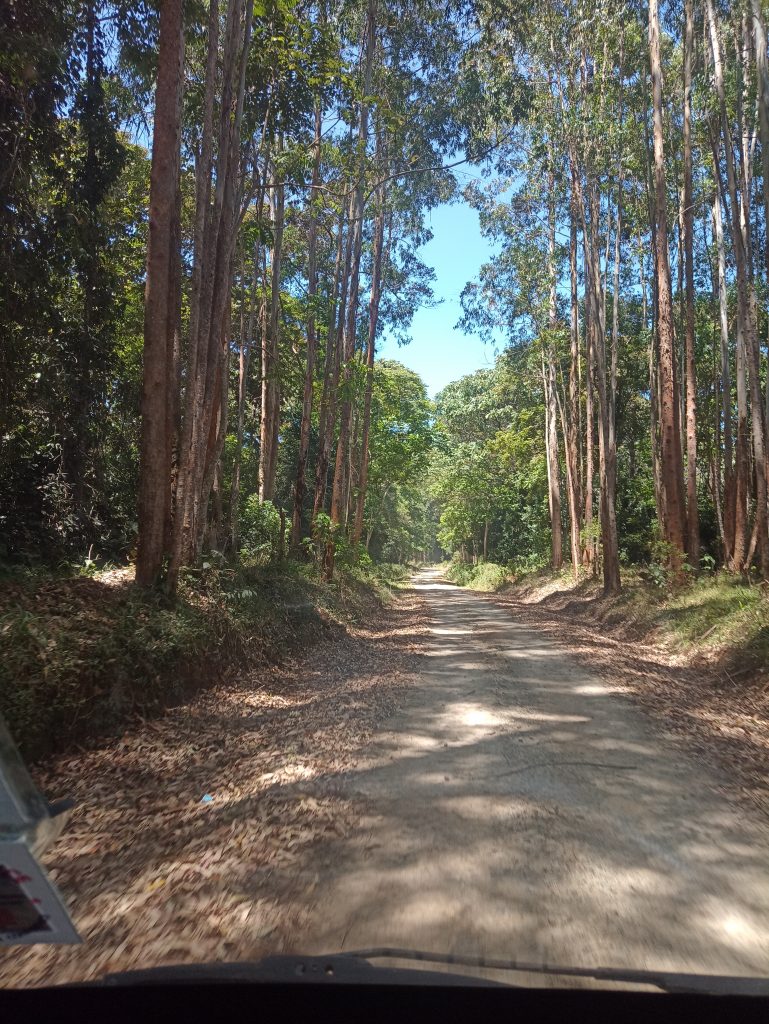
Climbing very slowly as the 1800cc engine was too feeble to carry 7 people up the hill and eventually stopped dead. We all got out and Steve got it going again; Nashon and I ran after him and jumped in, then we drove on leaving the others to walk! At the gate (rather further than we’d expected) we met my friends Makena ad Brian who had driven up in their Prado and Brian was despatched to rescue the walkers!

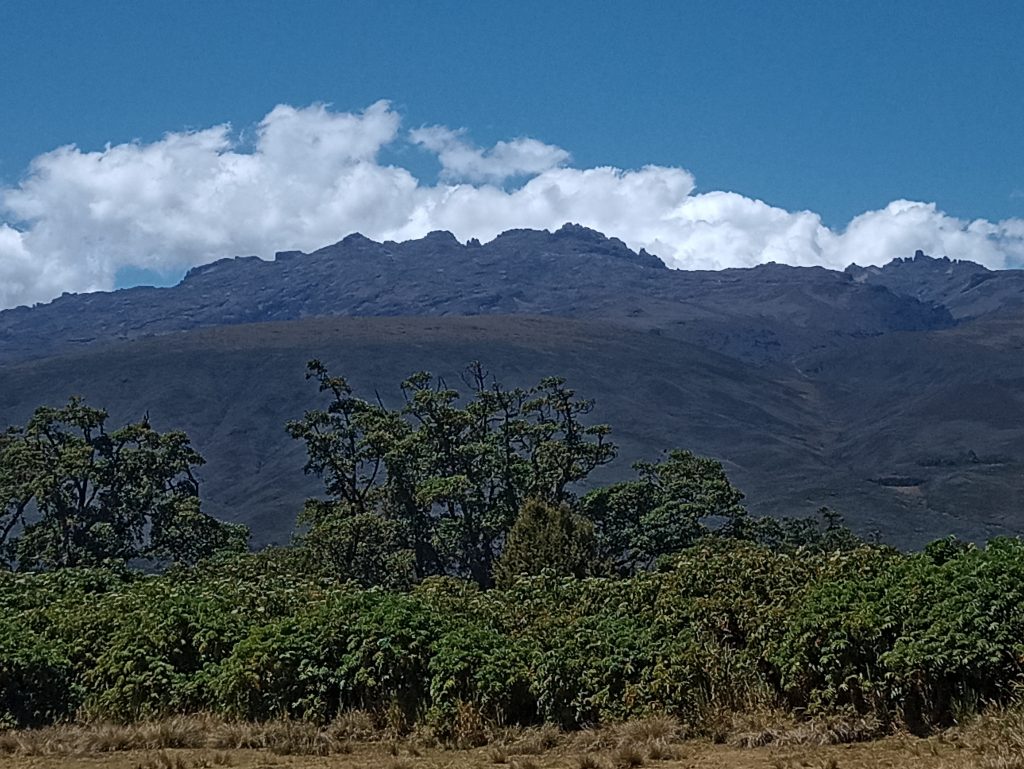
So it was after 1pm rather than 9am that we actually started walking.
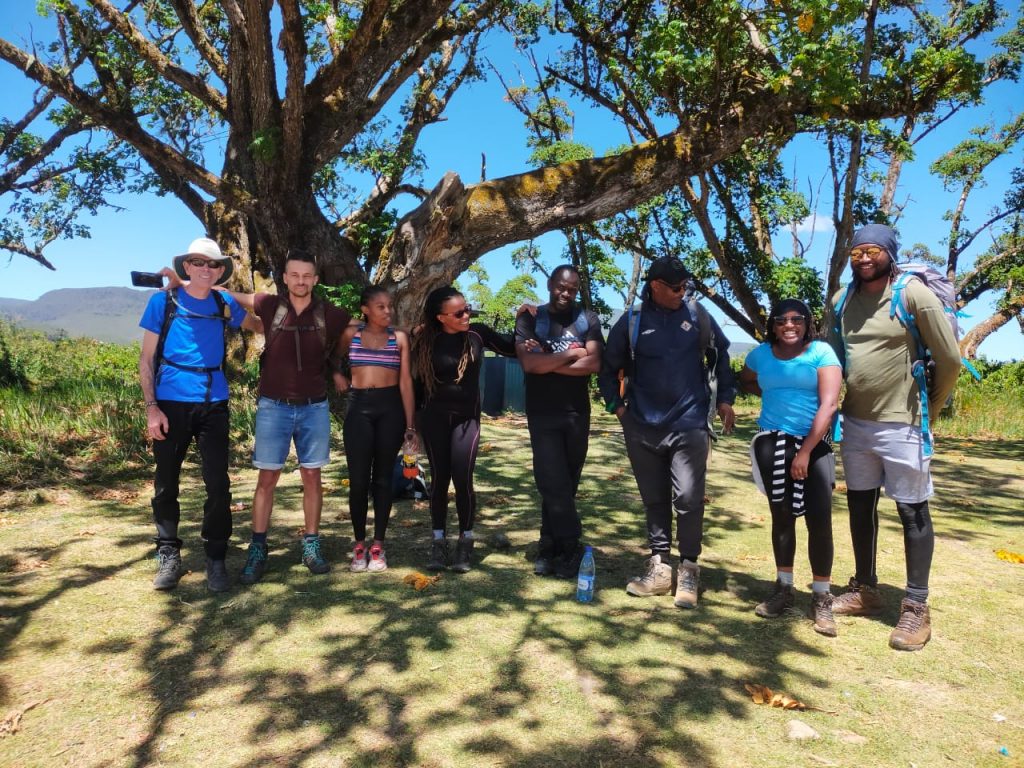
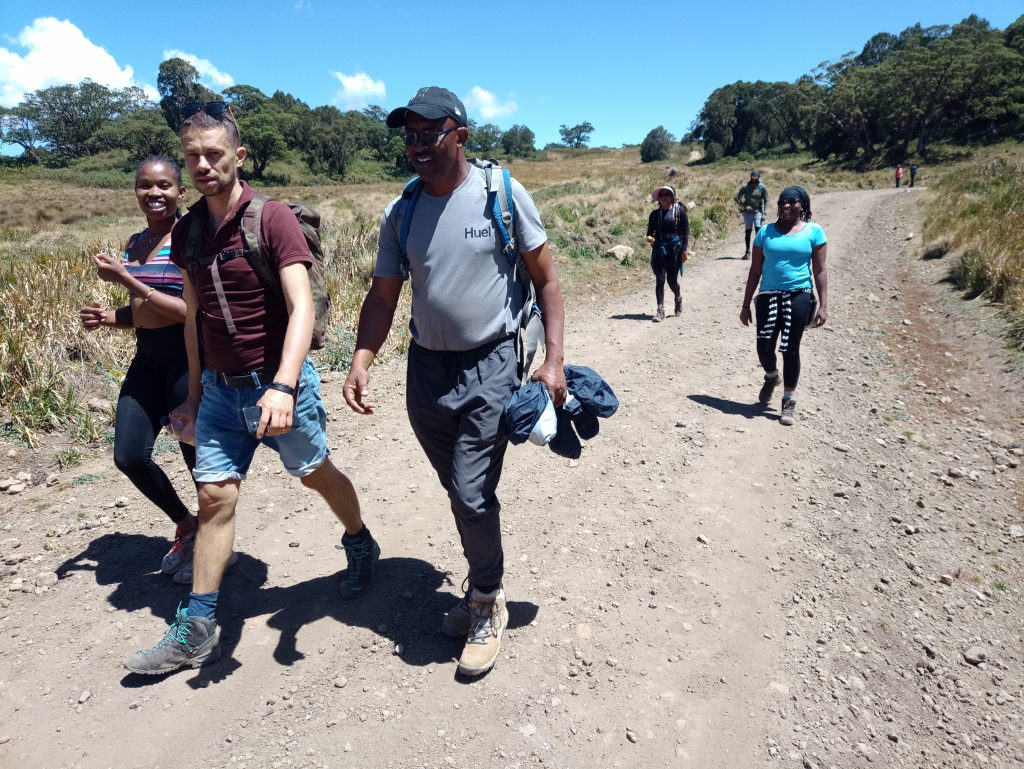
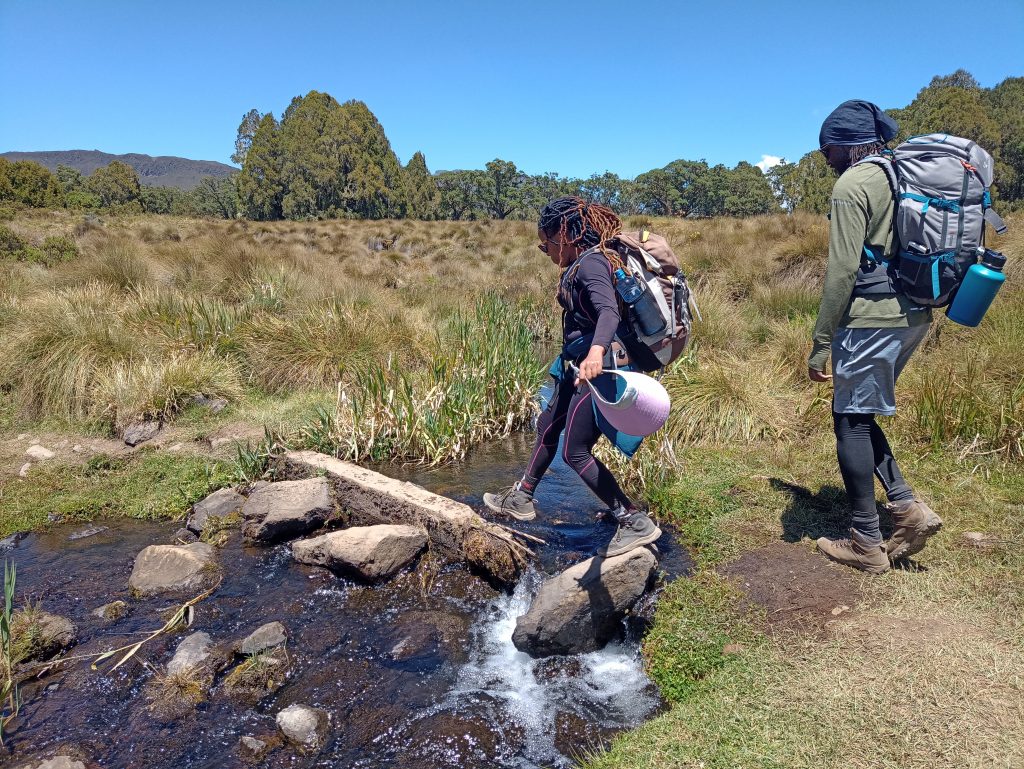
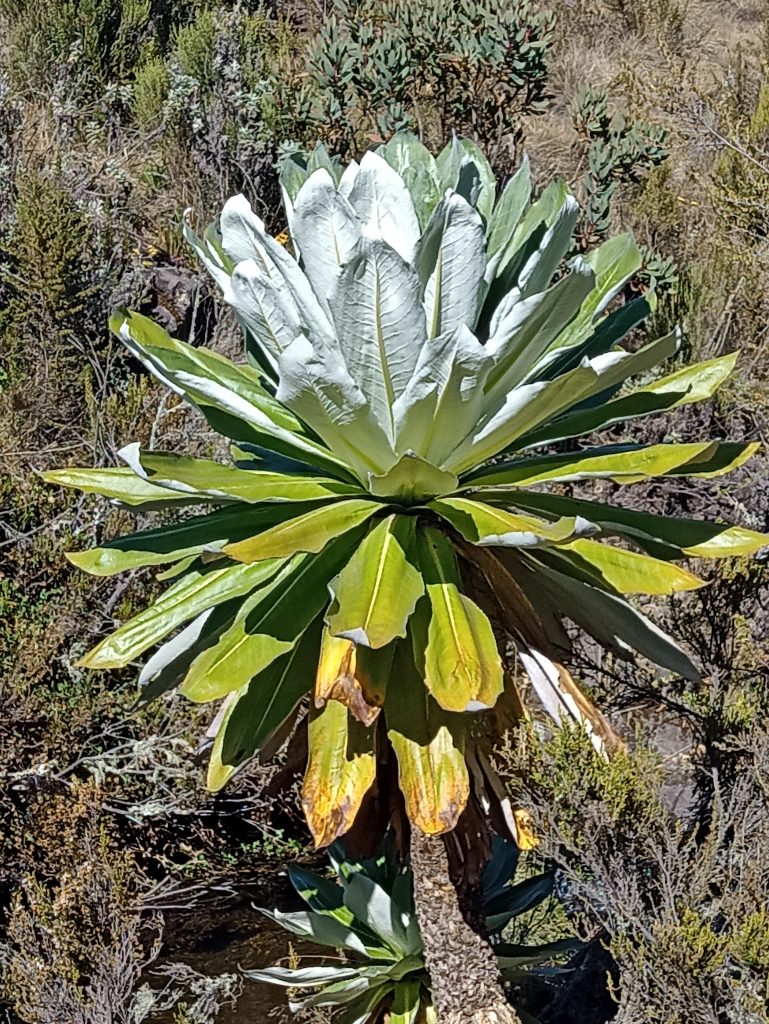

After a long steady climb, we descended to the stunning Nithi Falls.
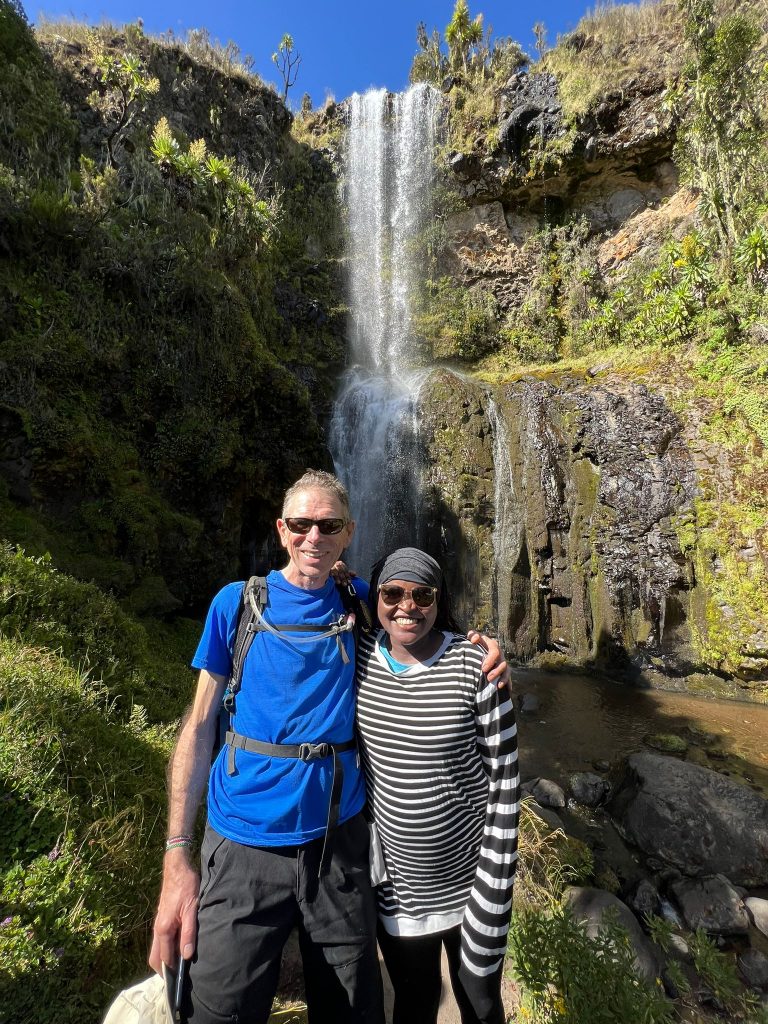
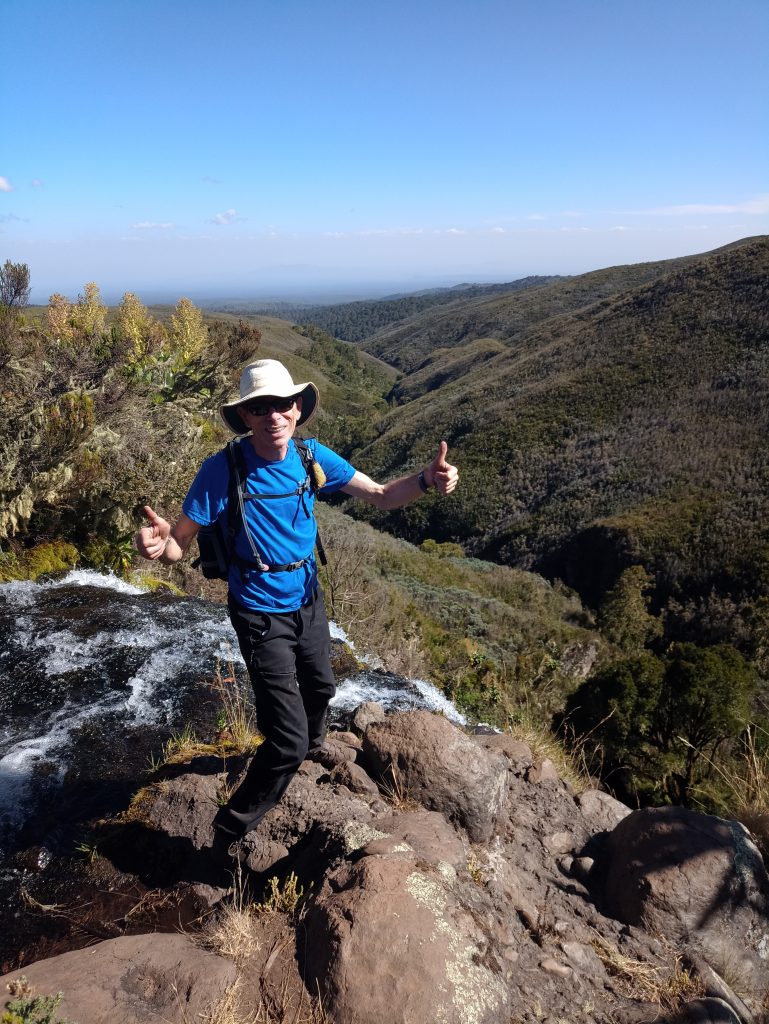
Then back up and on across the mountainside
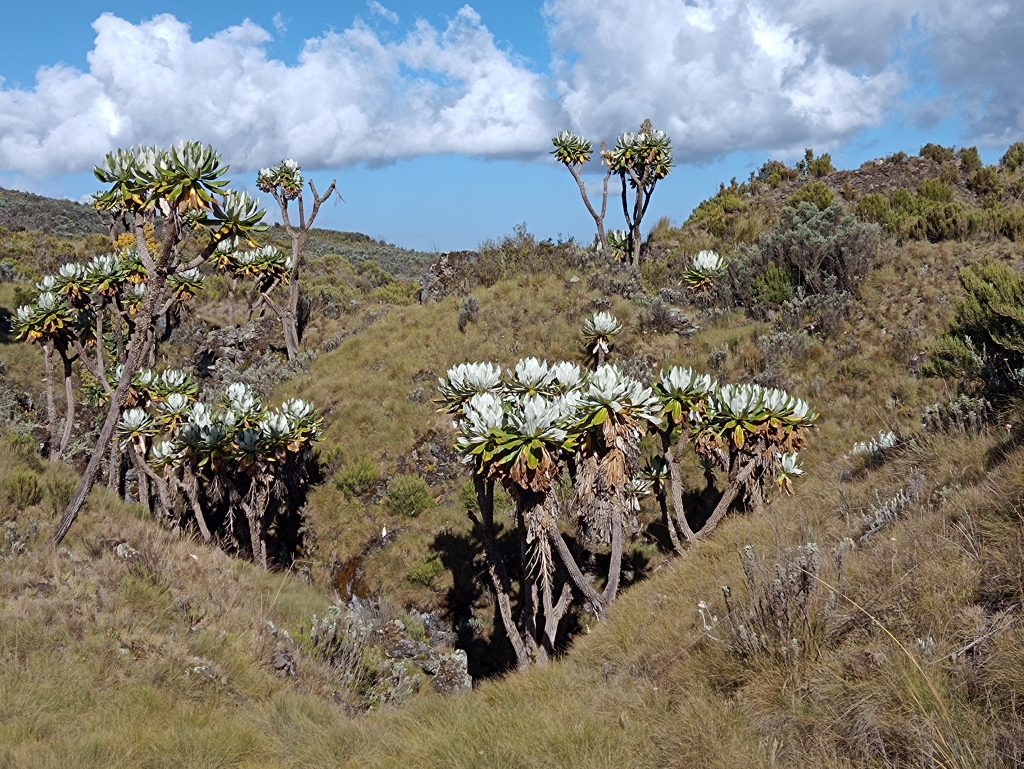
The giant Lobelia are weird and wonderful
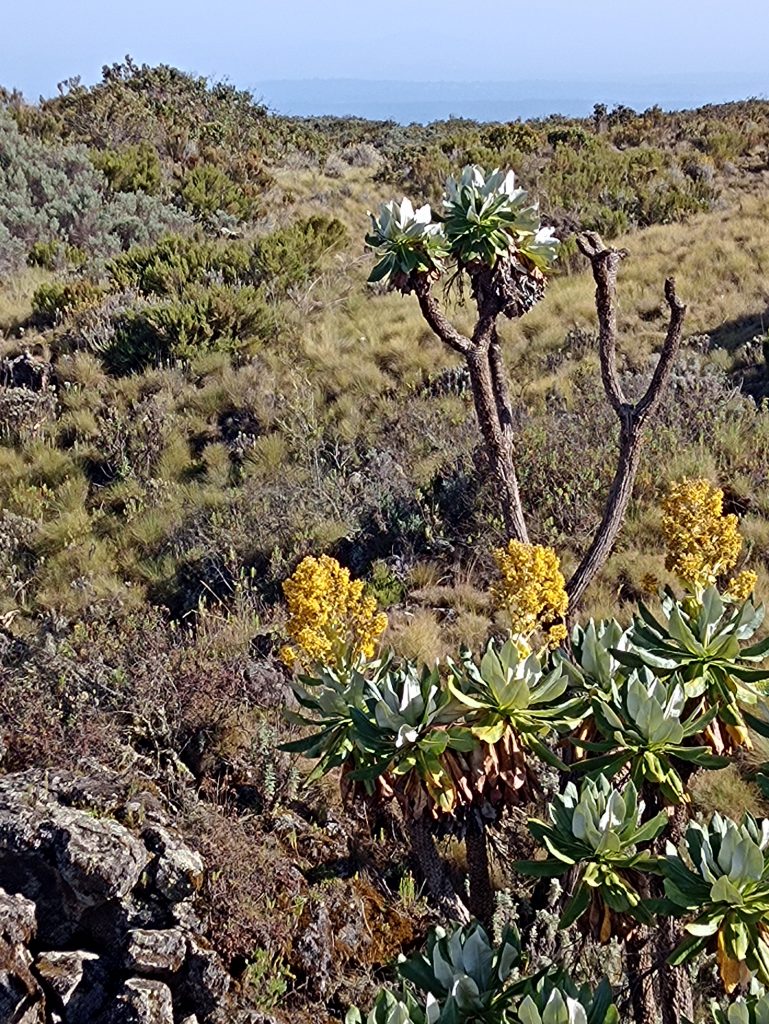
Eventually we got sight of Lake Ellis

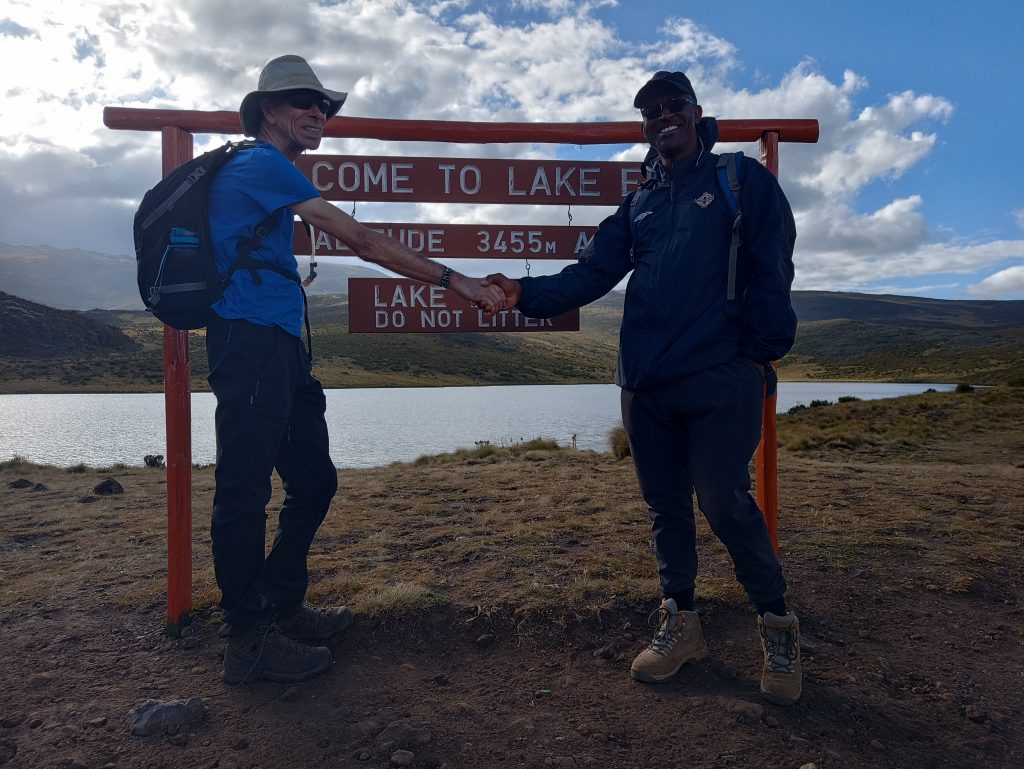
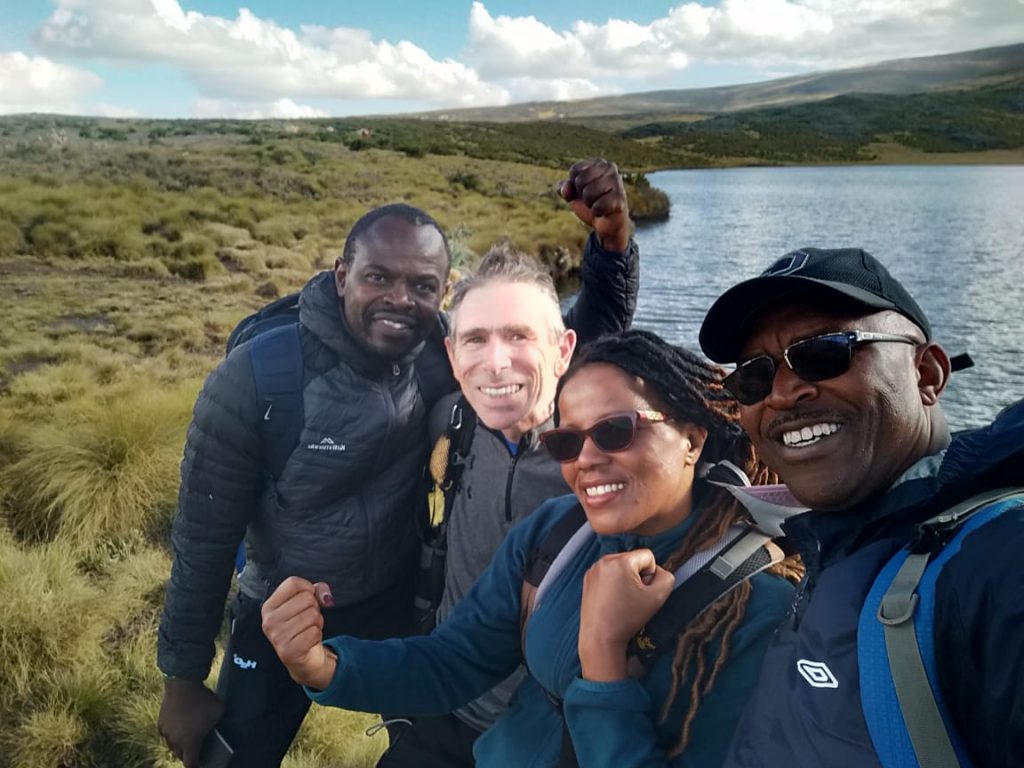
On the way back down it was getting late. Brian had driven up to collect Makena from the road head and stopped to pick the rest of us up for the last 2 or 3km. How many people can you squeeze in a Prado? (There were 3 more of us in the boot)
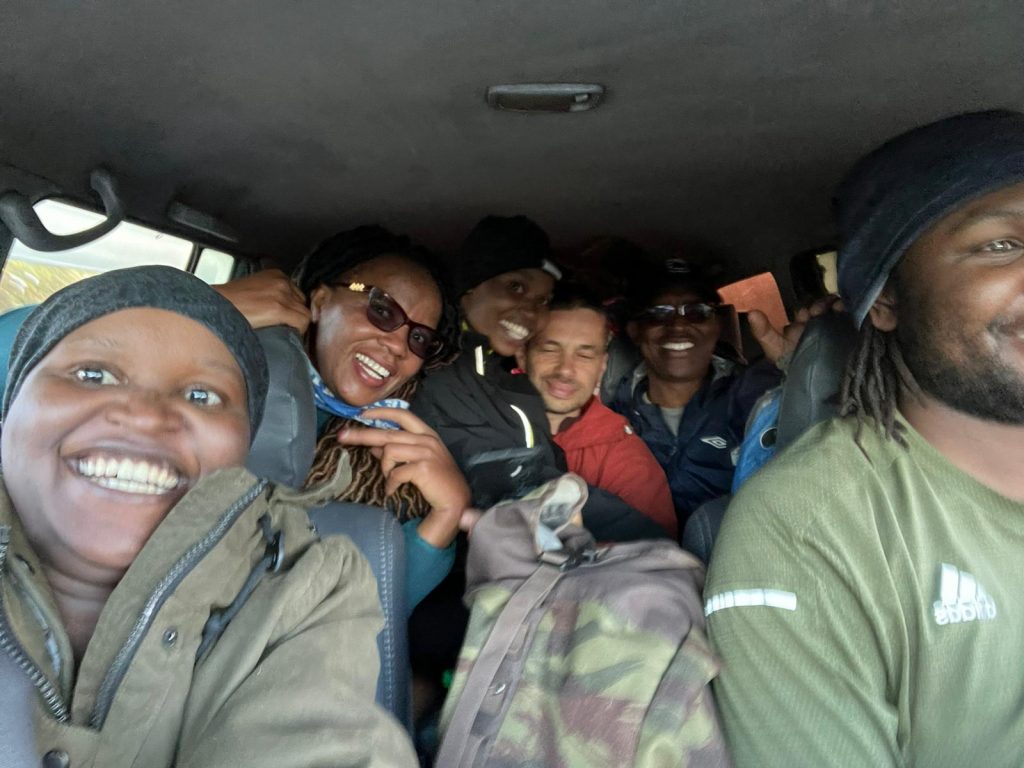
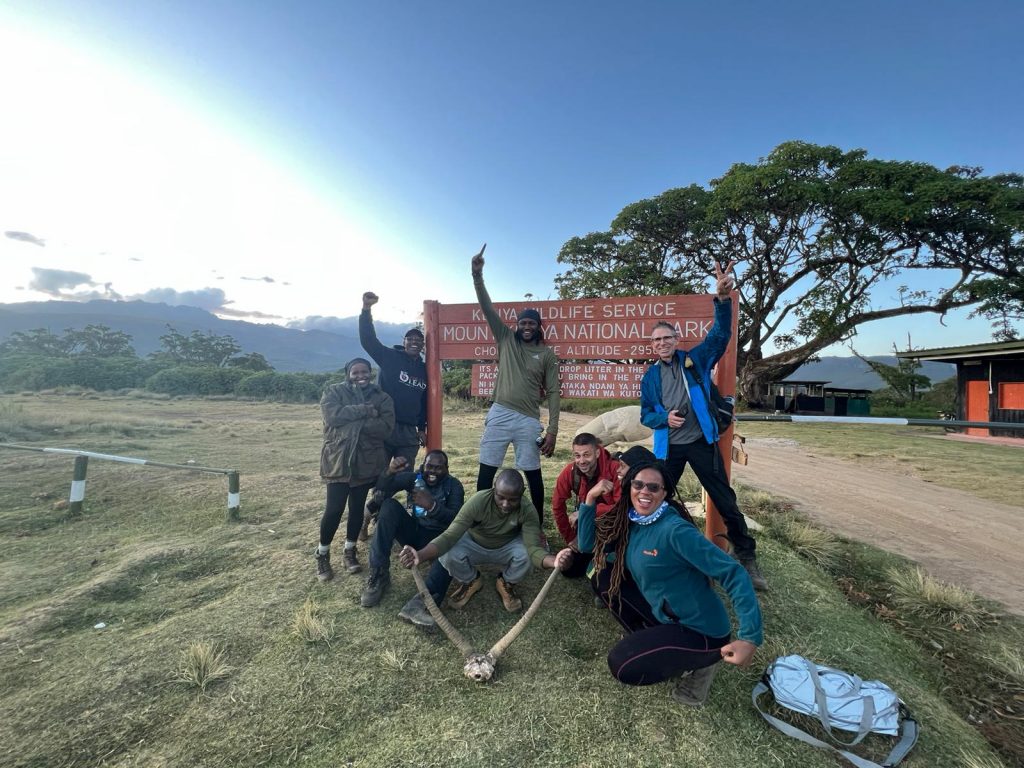
We ate our “lunch” quickly then started the descent by road, in the dark. I had elected to accept an invitation to stay with Makena and Brian (only 15 minutes from the lower gate) rather than travel all the way back to Nairobi that night.
After a great night’s sleep (no mosquitoes, fresh cool air) I awoke to birds singing, cattle lowing, cocks crowing, and a splendid sunrise across the tea gardens.
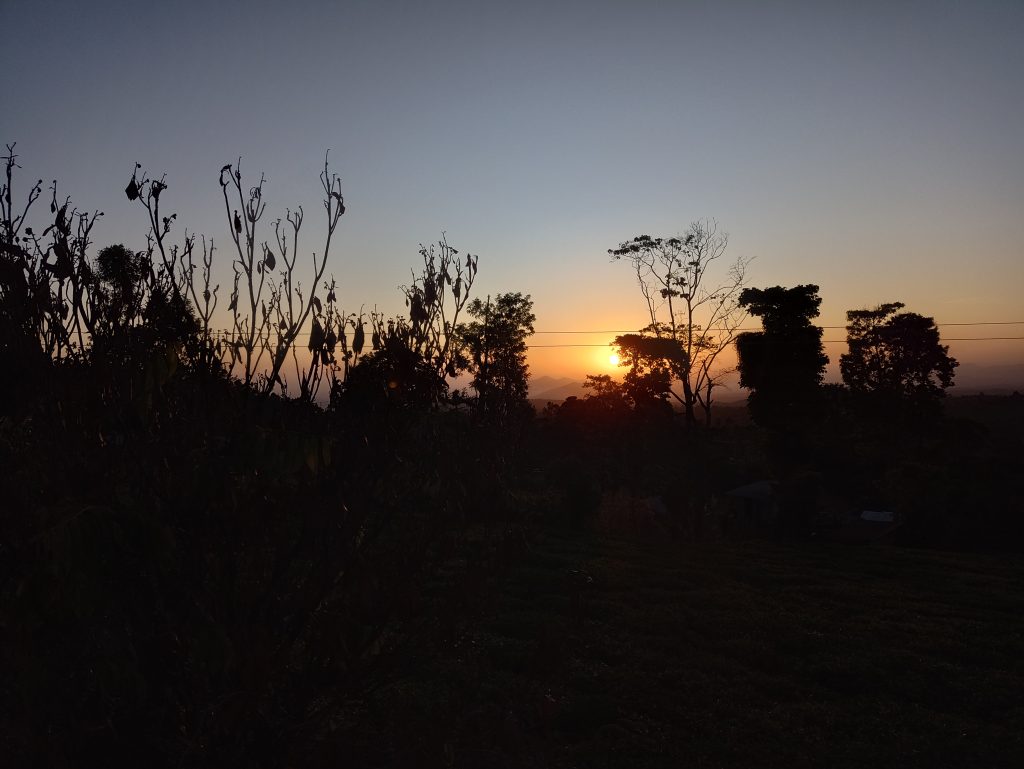
Before breakfast I took a short walk through the tea gardens, down to the river and back up again. So green, so peaceful. Is this heaven?
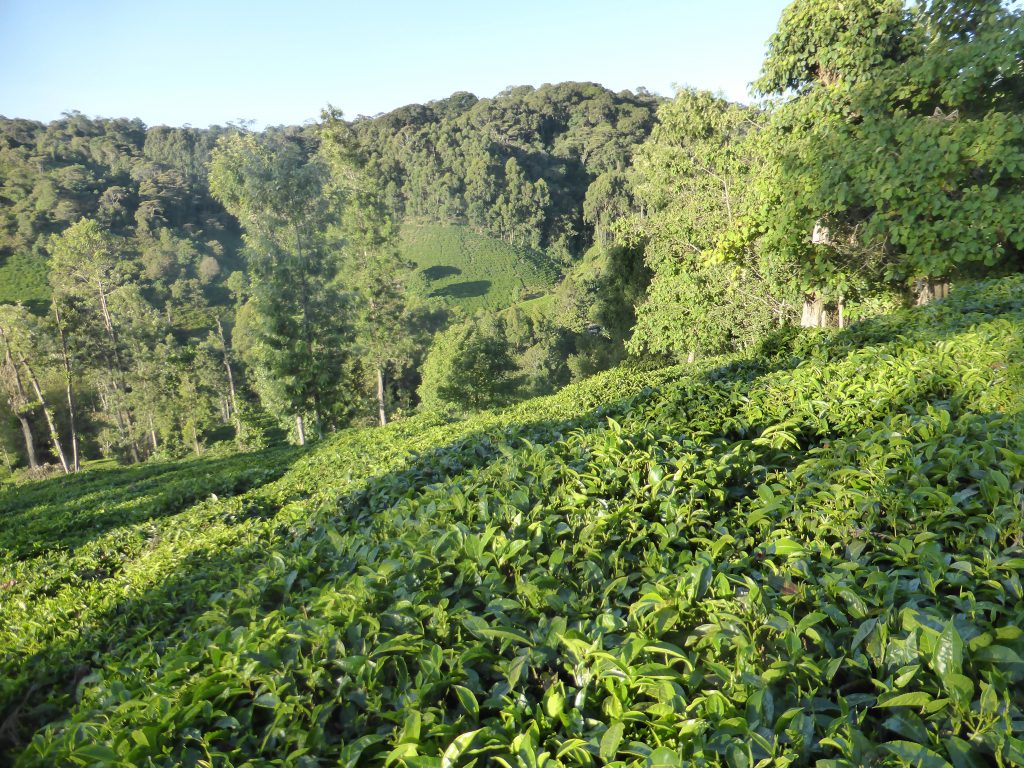
My final day in Kenya consisted of visits to Makena’s relatives, sharing chai and chakula, exploring shambas (it was lovely) before a drive back to Nairobi, and a couple of cheeky beers with Brian and Makena before heading to Nashon’s to pack, eat and head to the airport.
This bonus trip was the icing on the cake – despite all the morning’s grief (and thanks to Makena and Brian’s rescue service!)
Having used my Kilimanjaro Hike as a fundraiser for the Kwale Eye Centre, I was keen to visit the centre and understand how the money is used.
I was given a great welcome by the founder, Dr Helen, the staff and visiting ophthalmologist Roger and shown around all the departments (even having my glasses cleaned and adjusted). Helen told me a lot about their work and the challenges they face on a daily basis. Apparently eye trauma (e.g. sticks in the eye) is much more common here than in UK – safety generally is not a high priority and eye protection less so.But the bulk of the work seems to be cataract-related, soling avoidable blindness.
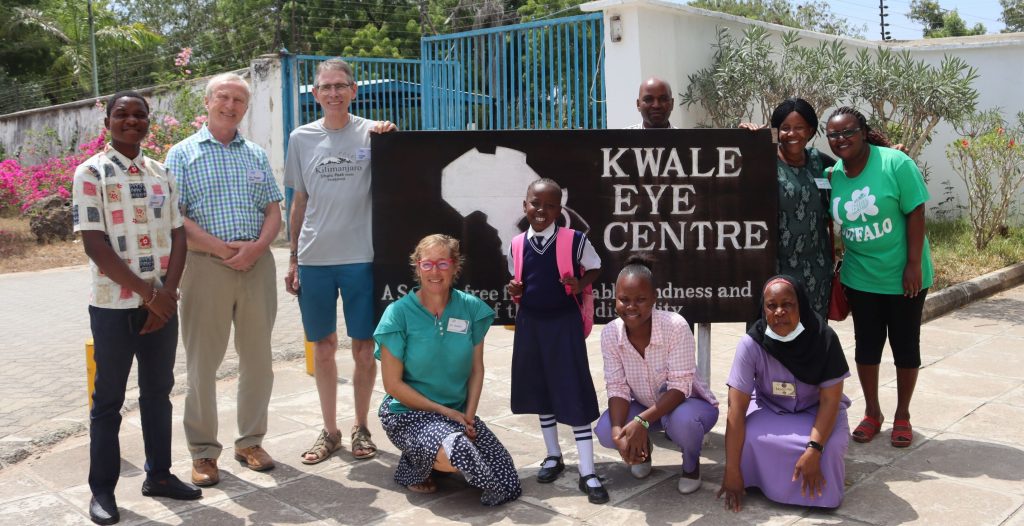
Then I went on a field visit with 2 of the staff, Vera and Mishi. We picked up a field worker by the road and went to visit 3 people who’d had eye surgery to check on their recovery, make sure they had medication. It was interesting for me and also for Vera who is normally office based and hadn’t appreciated the distances involved.
Me with Vera talking to the first patient.
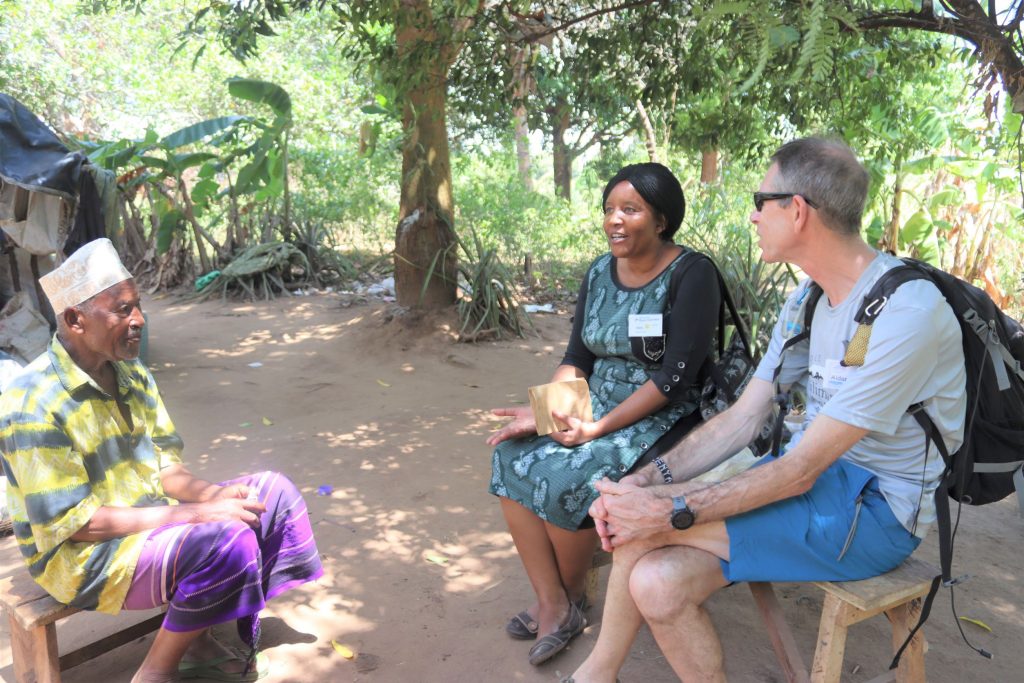
At the second stop, I was given a traditional stool to sit on. It was comfortable for a while!
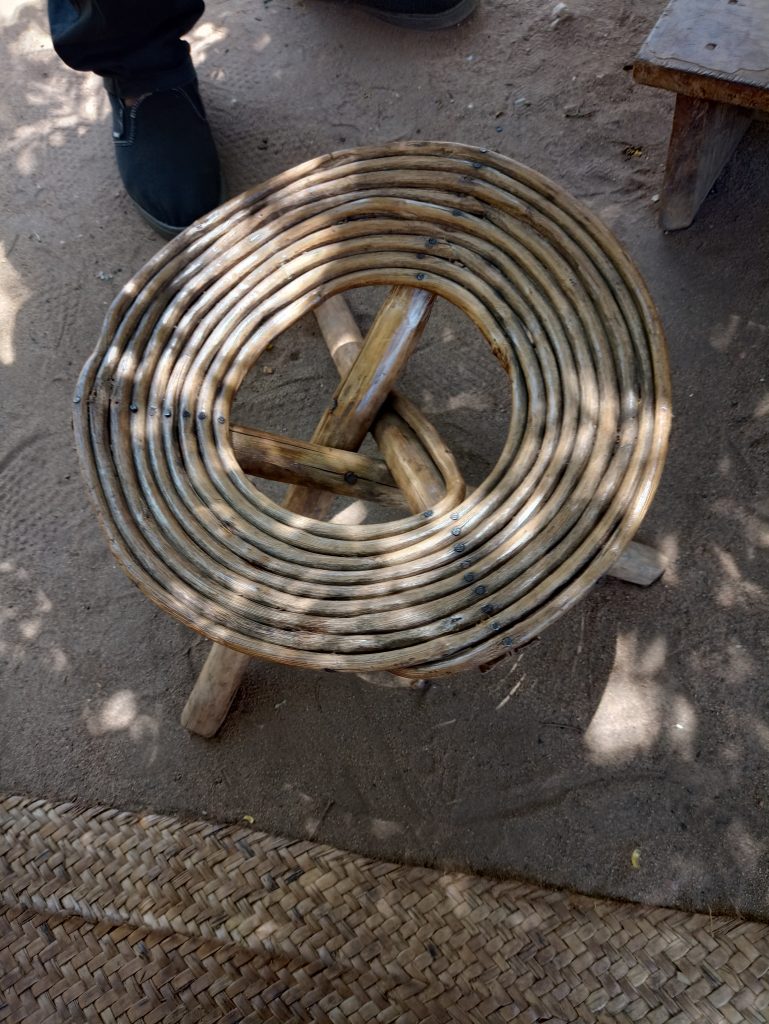
The patient is out of shot – we’re talking with her over her family.
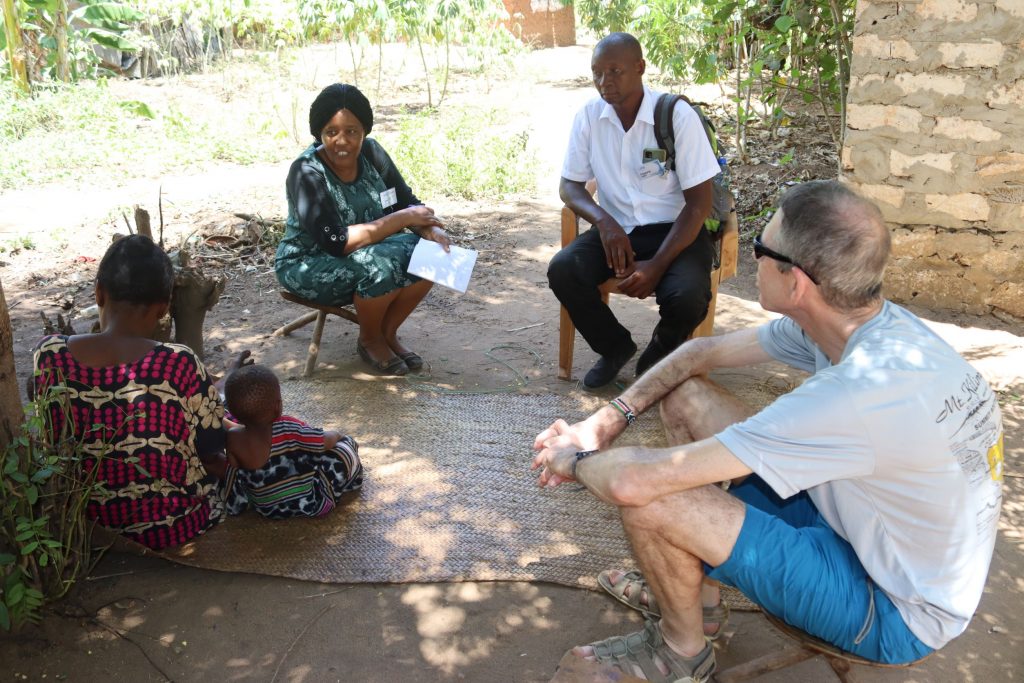
These are the patient’s twin granddaughters: she’d never seen them until after her cataract operation. She was so happy.
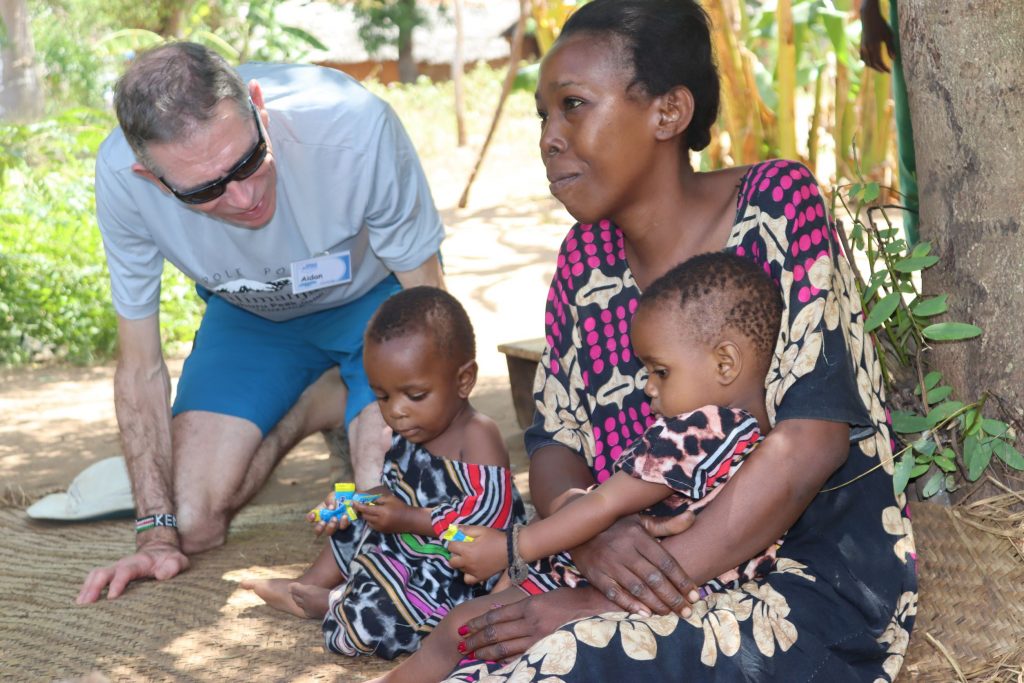

The third patient was a lady (in her thirties I’d guess) with children. When she lost her sight to cataracts she was unable to work, unable to do much for her family, and life fell apart. She was told she was incurable, tried the witch doctor, tried herbal treatment in Tanzania, all to no effect. Then she was discovered by the field worker’s network and was soon treated and is back caring for her family, working as a cook, and happy.
I guess this last bit was the eye-opener for me (pardon the intended pun). I thought access to healthcare was the problem (well, it is a problem), but awareness and education is also a problem. People don;t know that conditions are treatable, or where to get help. As with other illnesses and disabilities (epilepsy, deafness) sufferers are too often considered an embarrassment and hidden away. A bigger part of the centre’s worh than I’ ever imagined is trying to get the word out there that help is available.
Well, after all that driving and visiting (I was the driver) I was hungry, so we stopped for lunch in Shimoni – samaki na ugali.
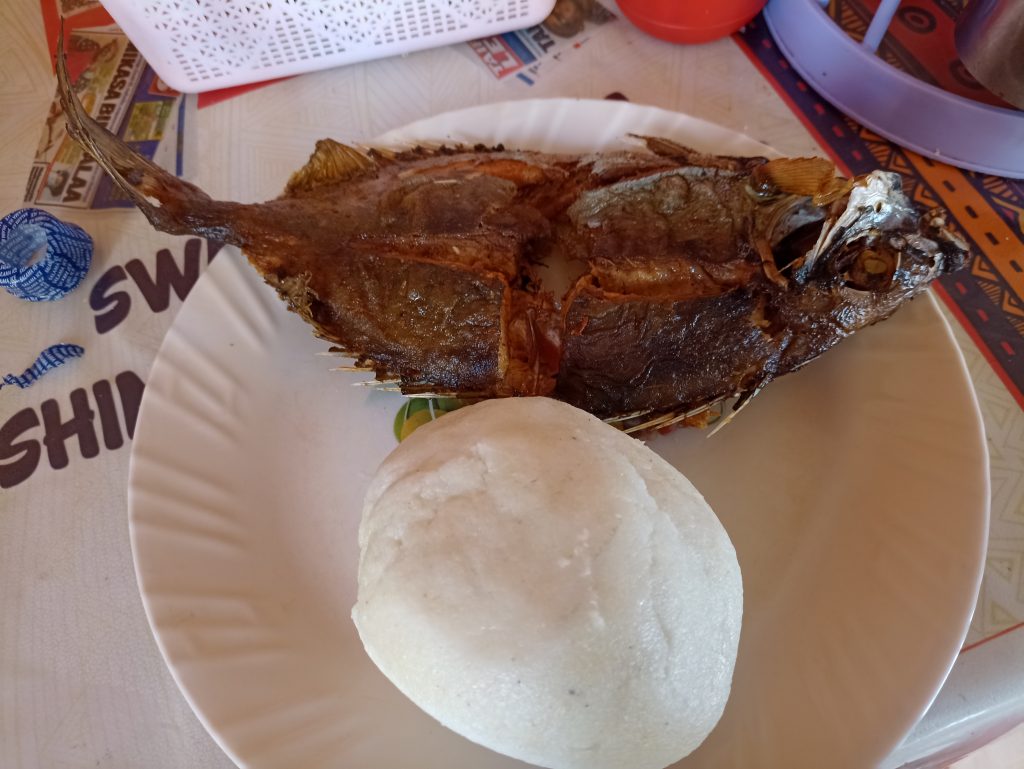
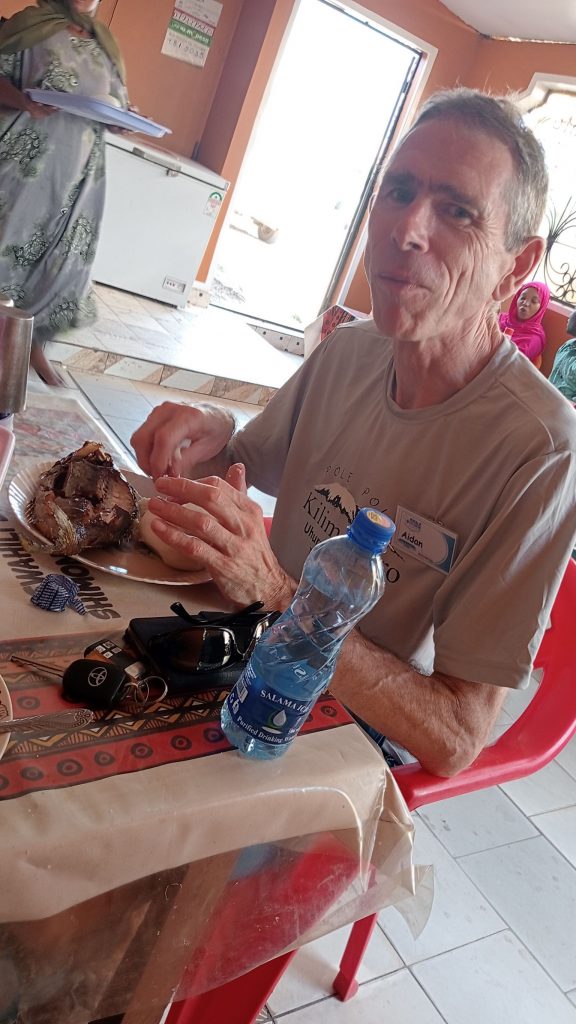
I returned to the Eye Centre on my way north 2 days later, giving feedback on the field visits to the doctors, then touring the departments again as a patient – glasses check, eye exam, then being used as a training aid by Dr Helen showing students what Fuchs Dystrophy looks like.
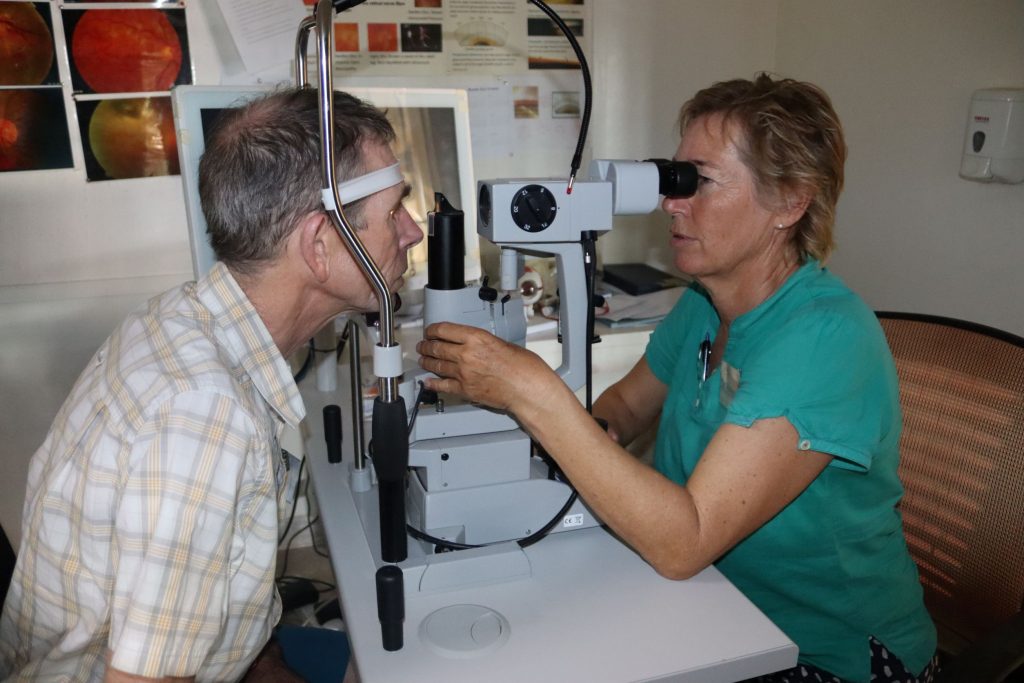
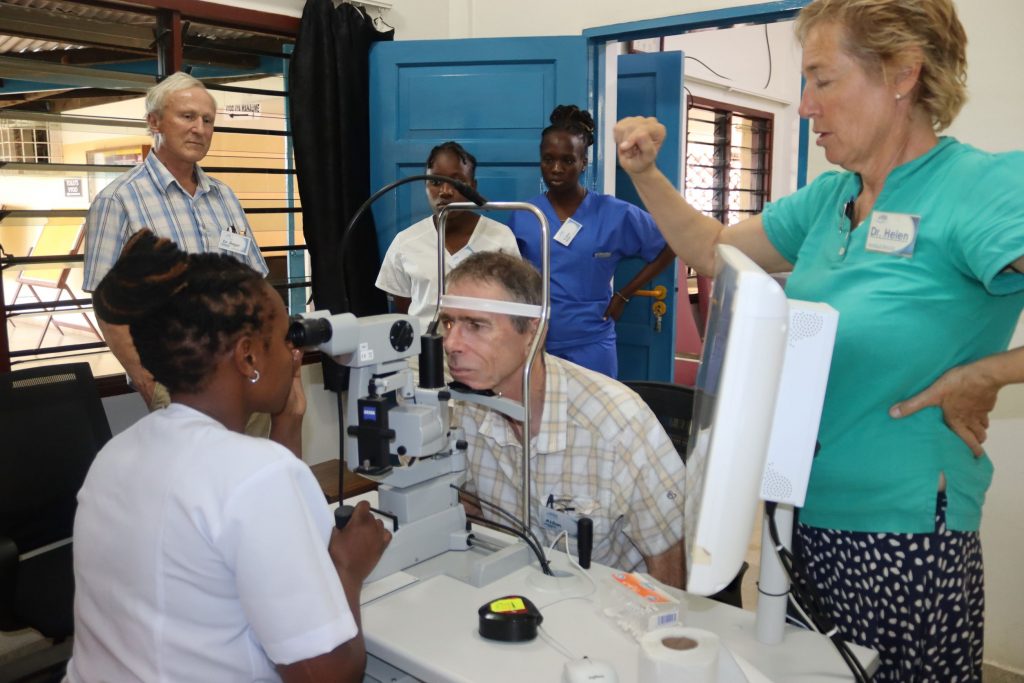
Thanks to Mishi who took all the photos (and is therefore in none!)).
A week after out Kilimanjaro adventure I drove up to Malindi to meet fellow hiker Joyce who wanted to show me the sights.
First stop (after breakfast of course) was Marafa (Hell’s Kitchen), a canyon in the sandstone with spectacular colours. The soft sandstone has been eroded to great effect.
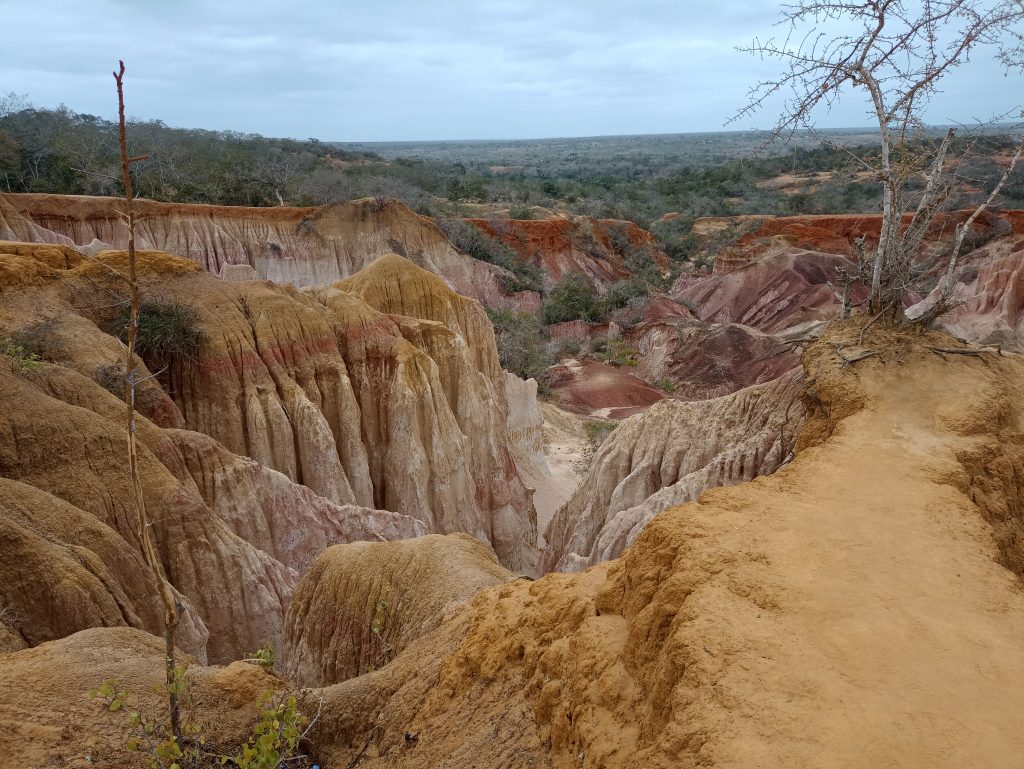

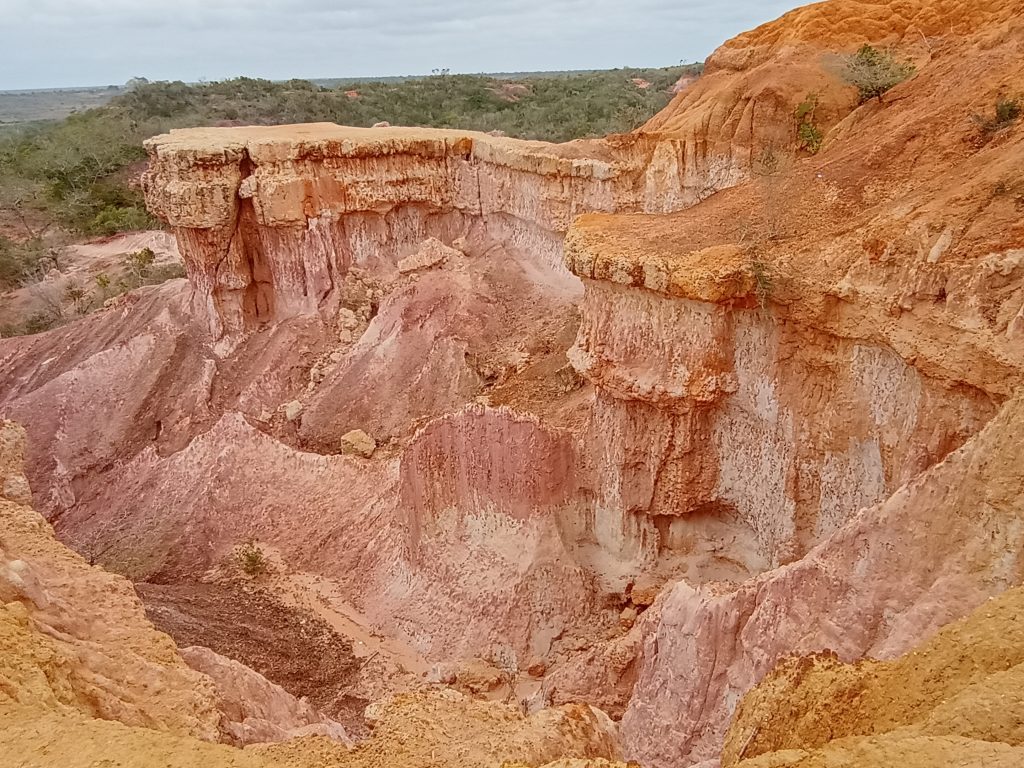
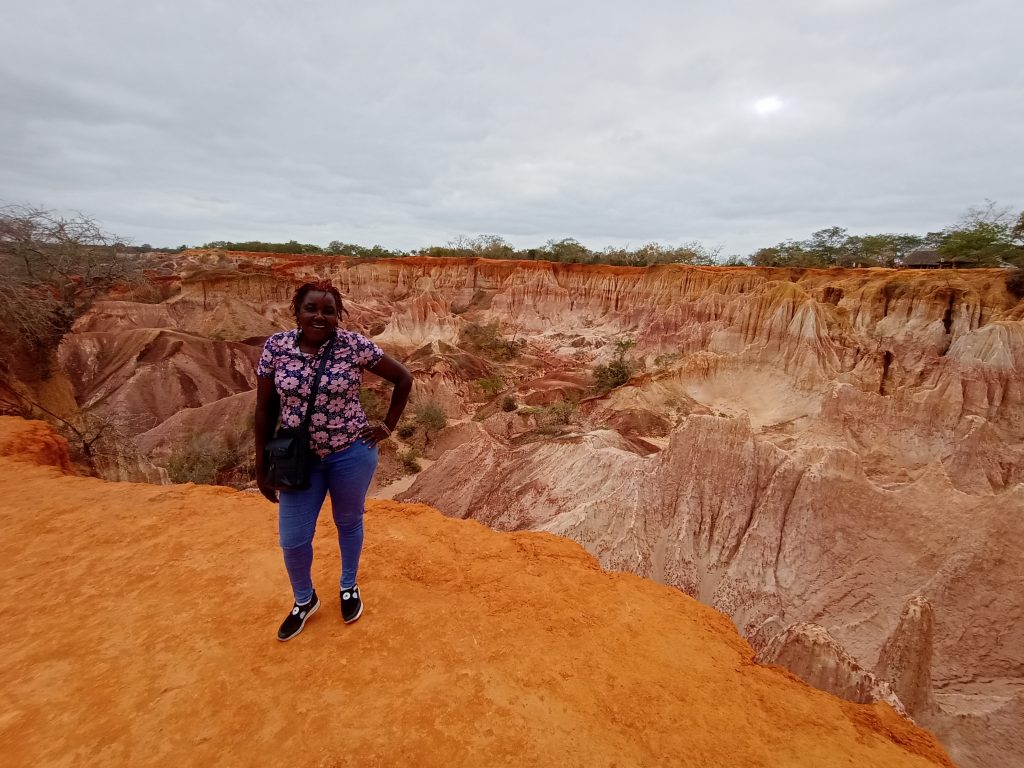


The soft sand was traditionally been used for body paint (red, yellow and white). Here we compare the appearance on differing skin colours.
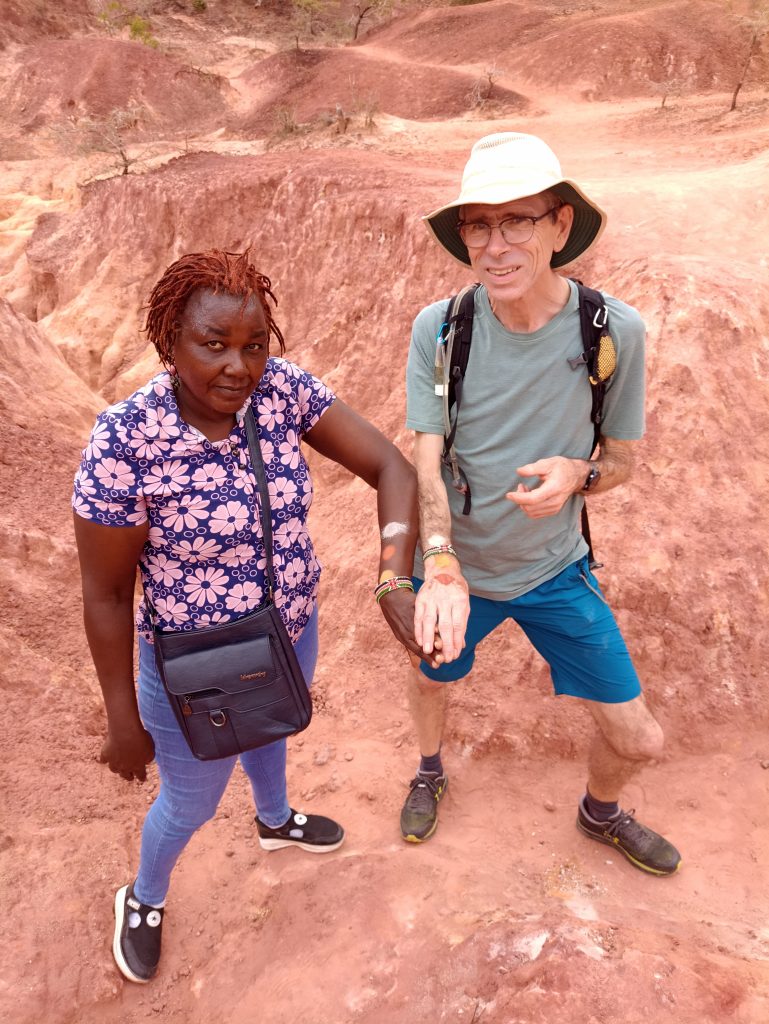
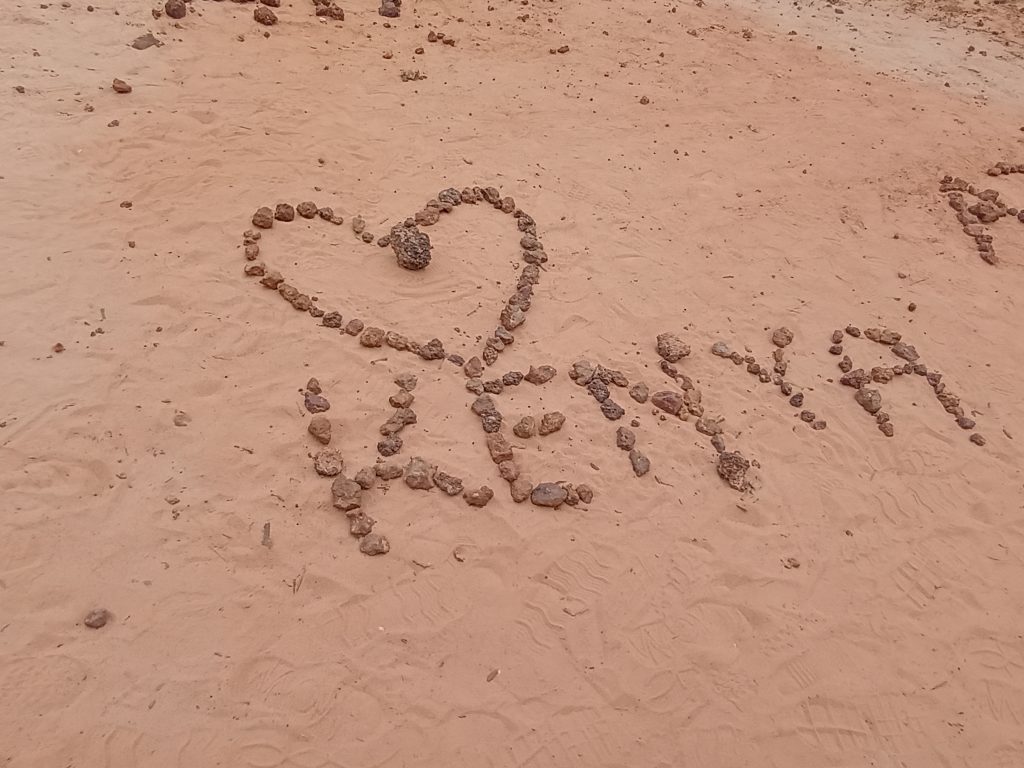
From Marafa, back through Malindi and Gede to Medi where we had fish lunch on the beach before trying the elevated boardwalk through the mangroves. I have to say this was more alarming than anything we’d encountered on Kilimanjario!

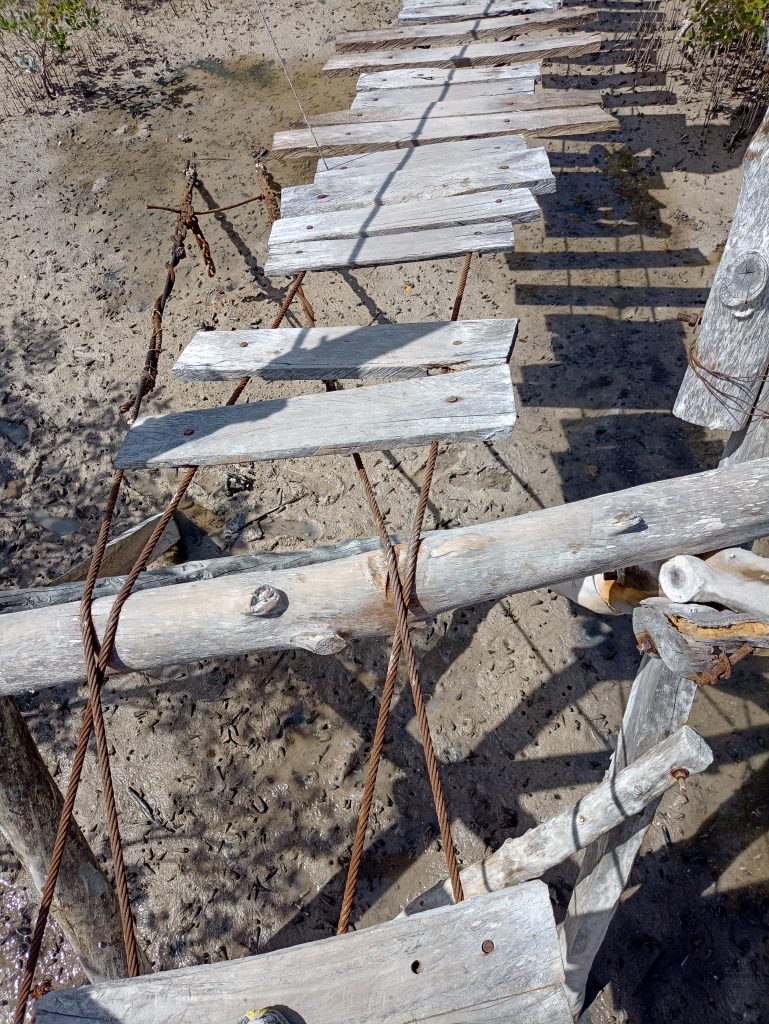
From Medi to Watamu for a swim and a run on the beach (avoiding kite surfers and their strings)
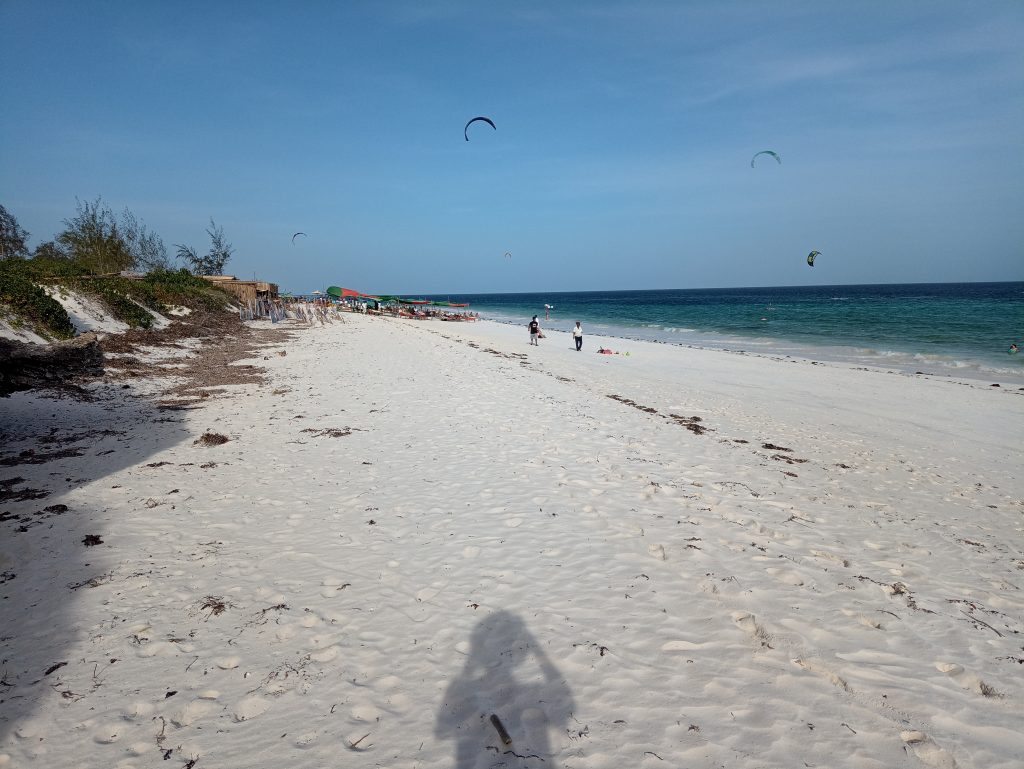
After an excellent coffee and gelato (Non Solo Gelato, Watamu) we headed to Gede ad a road alongside the Araboko Sokoke forest to see the elephants coming for their evening drink. Light was a bit low, but you’ll get the gist.
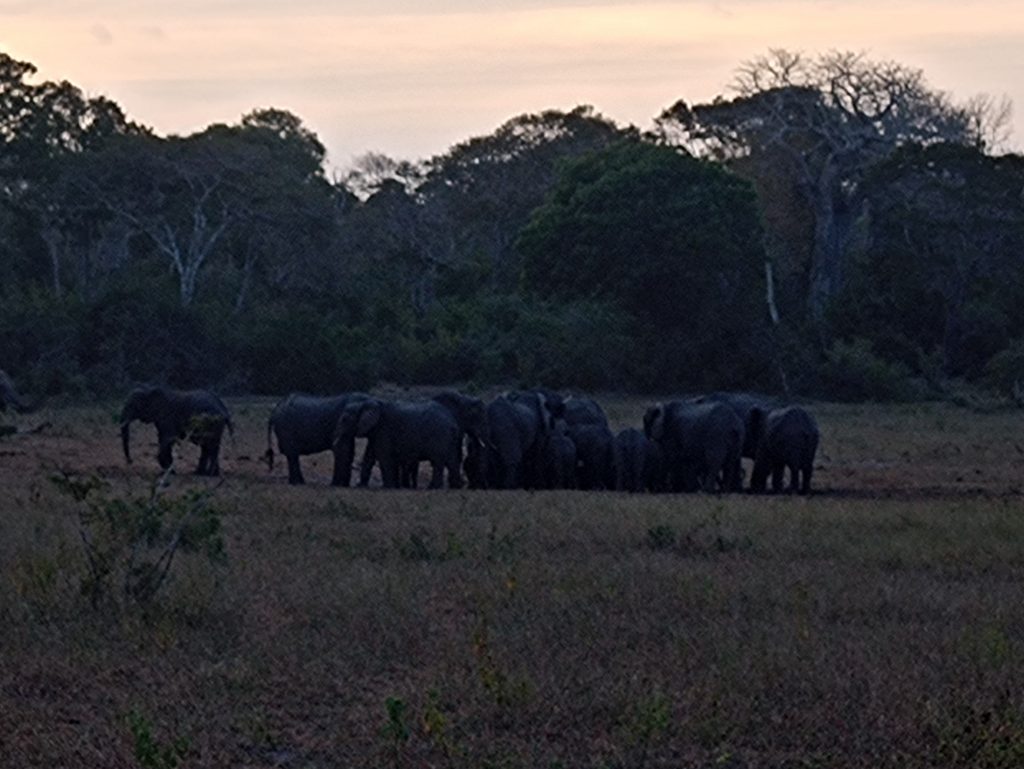
Next morning, before heading south again, we went to Malindi Beach for a swim and a walk .
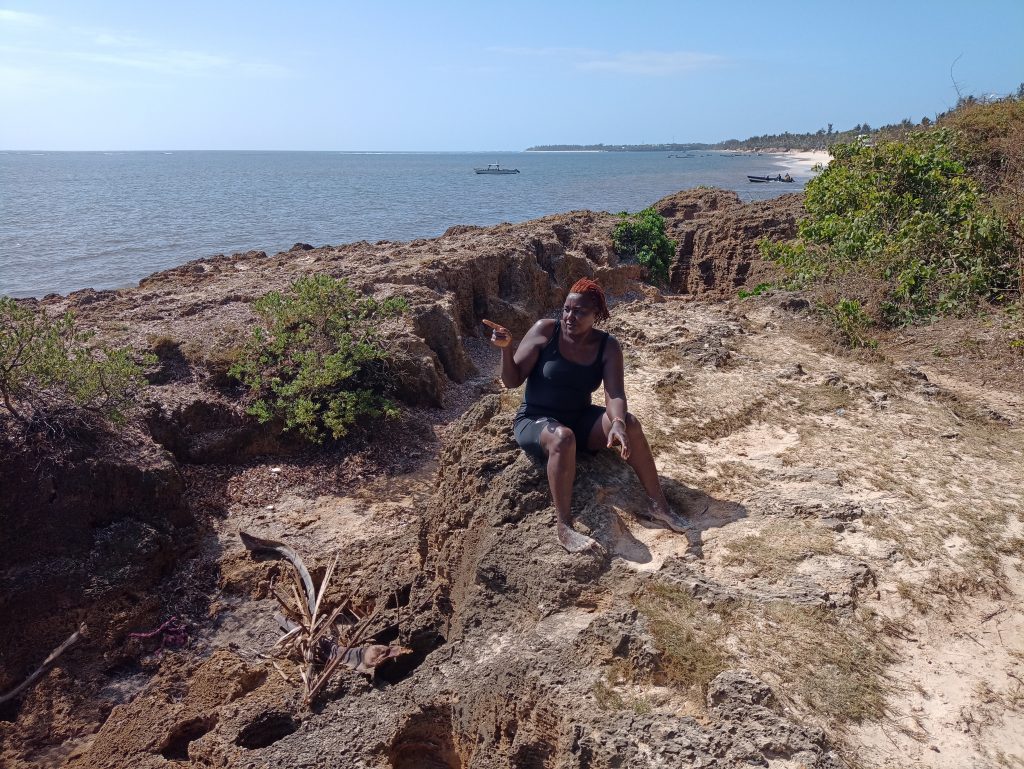
Rounded off with a glass of passion juice
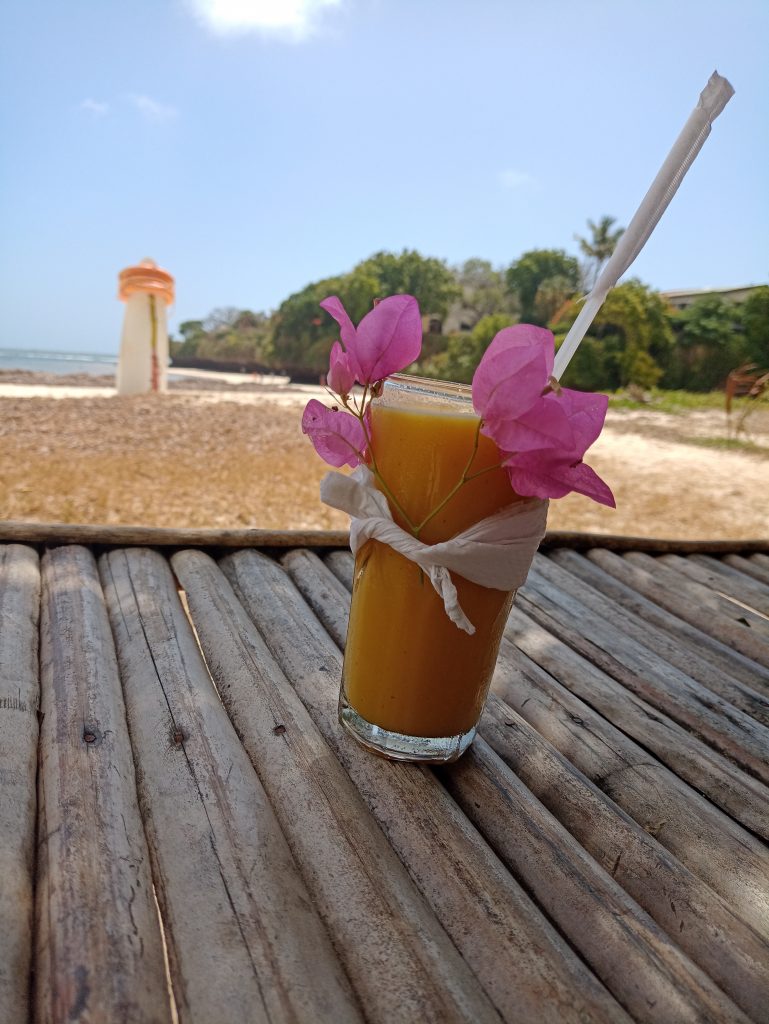
A sunny morning, so the solar charger was working well.

A great view of the mountain as the camp was dismantled for the last time.
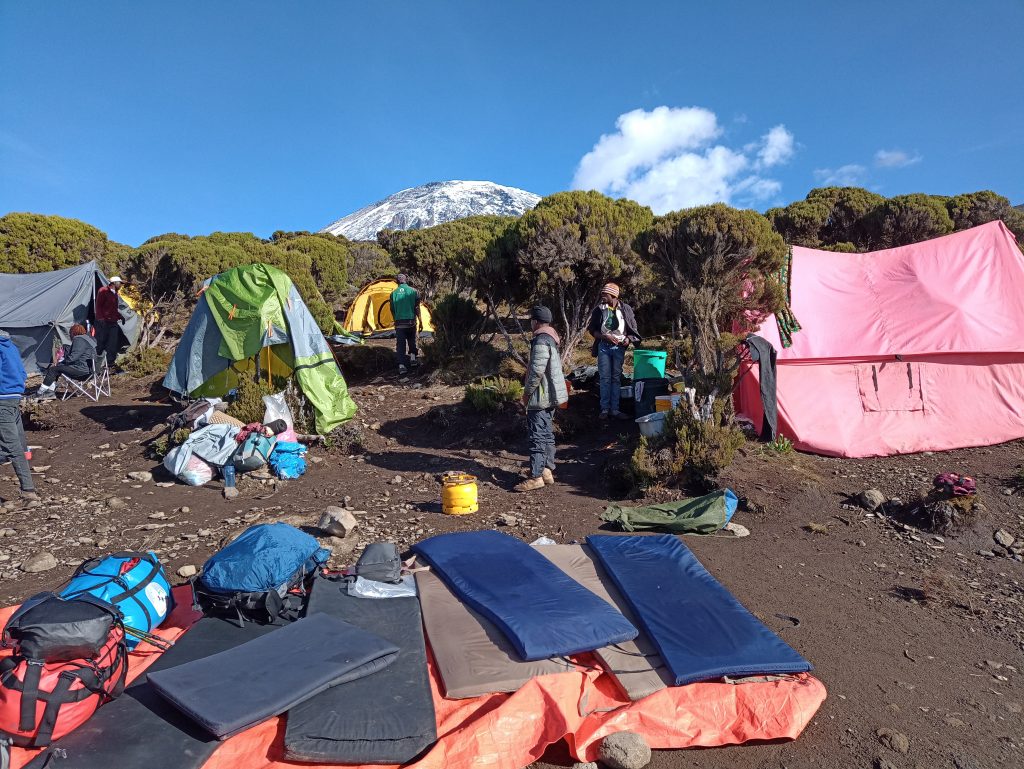
Time (and weather) to take tea outside, though we’re still at high altitude.
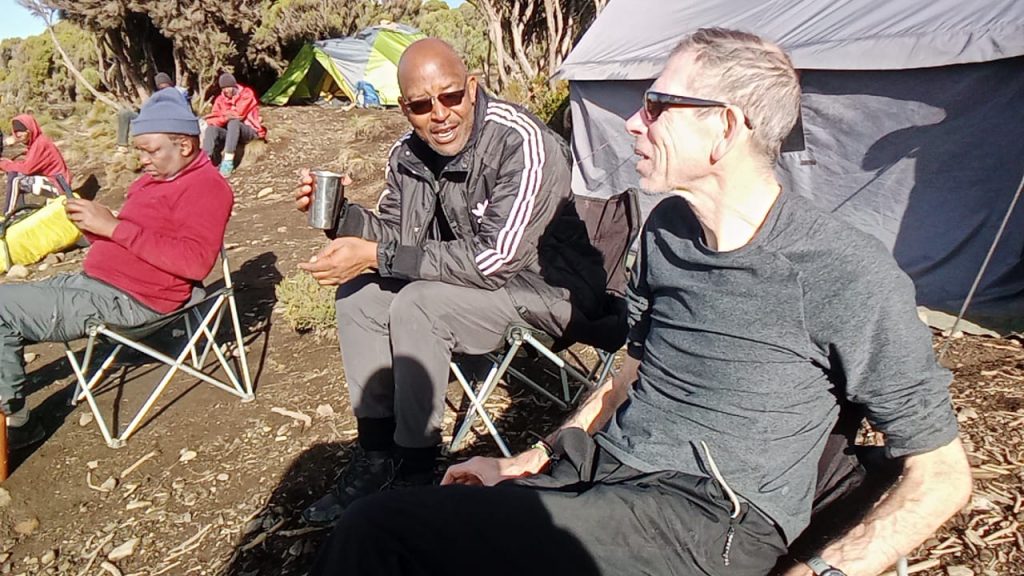
This is how you get the dust out of a tent (also works for late sleepers)
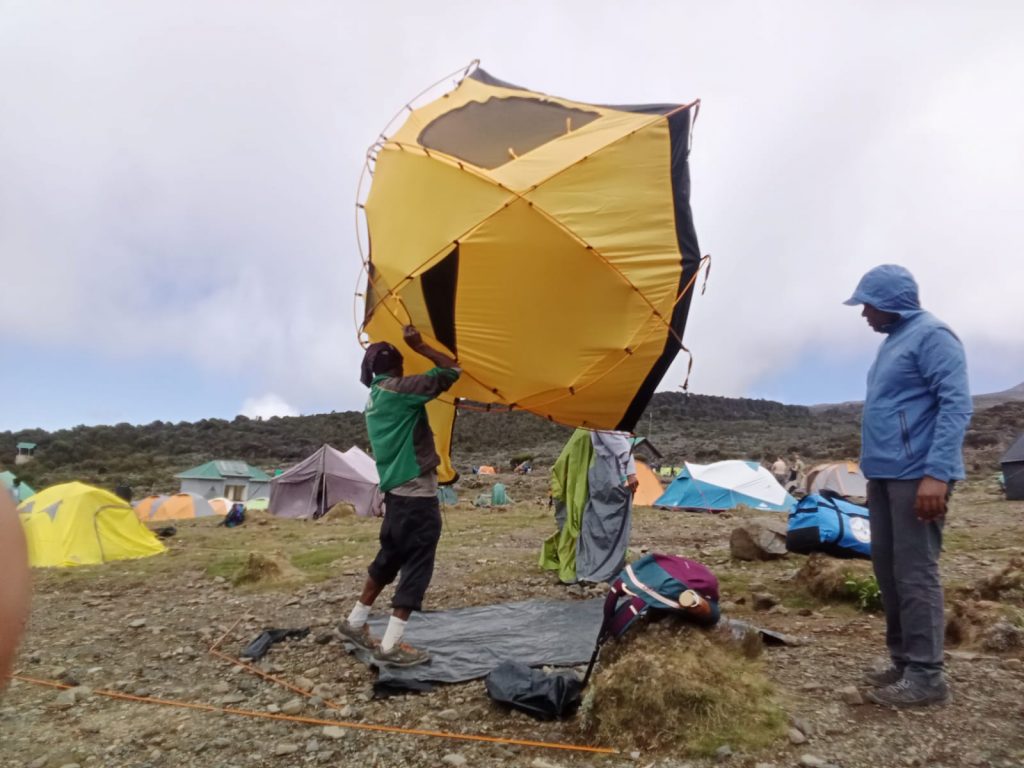
Ready to descend
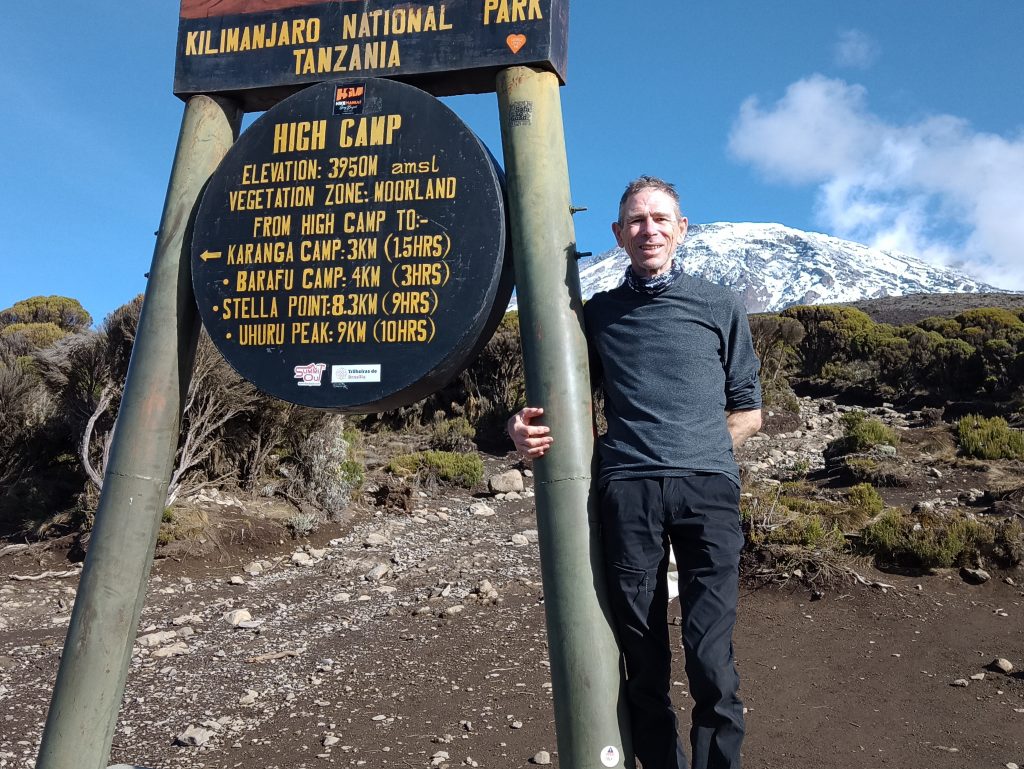
Farewell my friend
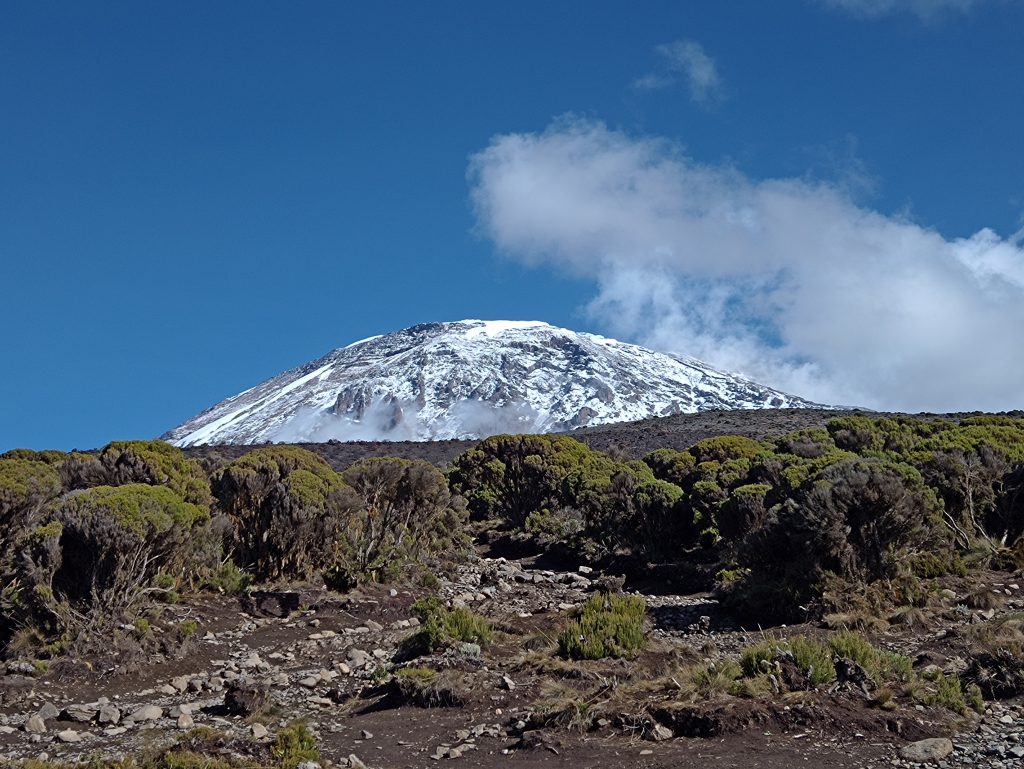
The descent started through moorland (as you can see in the above pictures) down to Mweka Camp. At this point I was on my own with everyone else ahead of me (I thought)

After Mweka Camp we were back into the rainforest, luxuriant and green, though steep and rocky at times. i was hurtling down, keeping with (even overtaking) the porters, with a few pauses for the scenery.
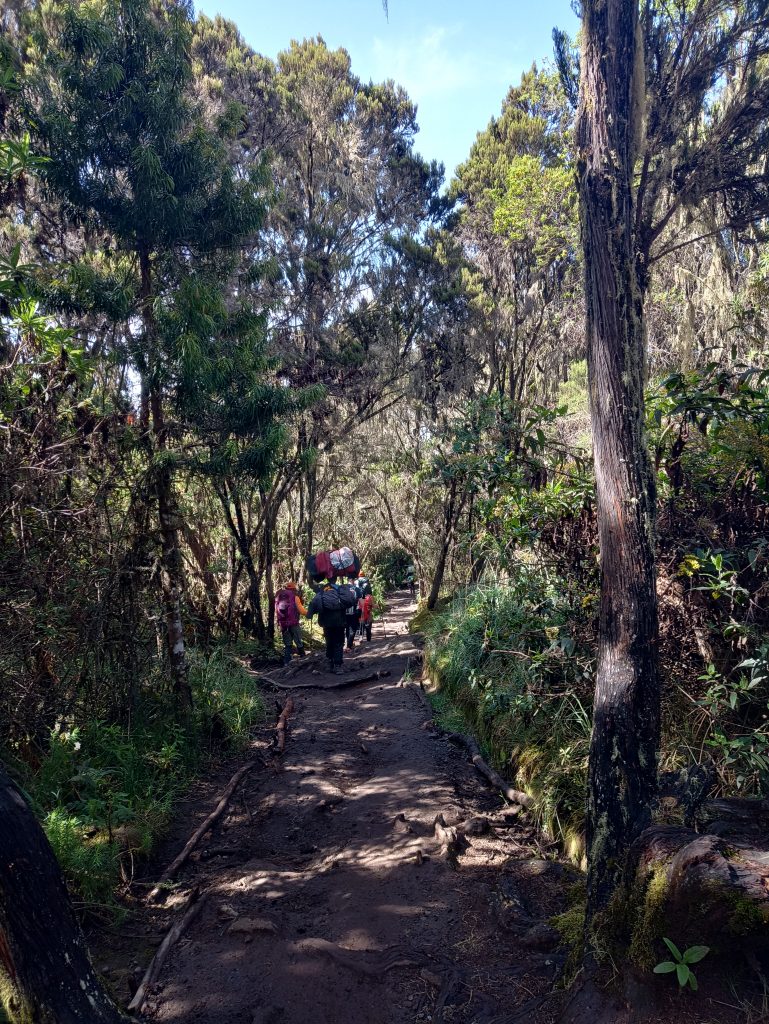
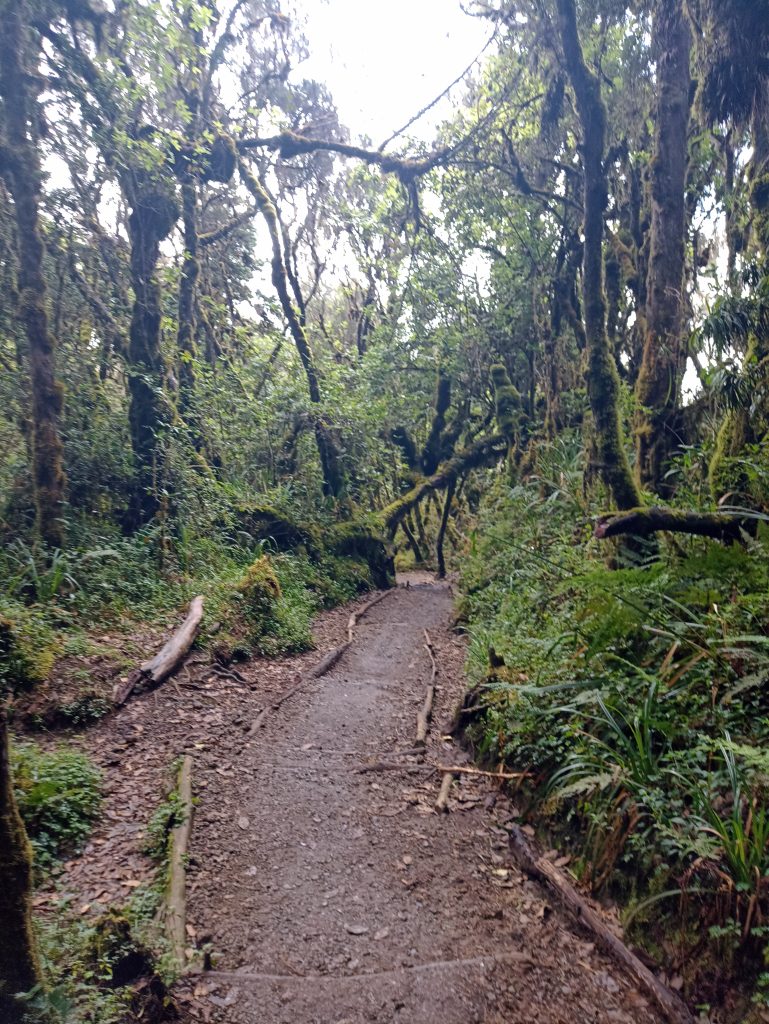

I rapidly descended to Mweka Gate – the end of the trail.

Here I met Mox, our steward, and we shared a beer (well deserved, especially on his part). This is when I learnt that somehow everyone else was behind me – like hours behind me – so we sat and supped until they caught up.
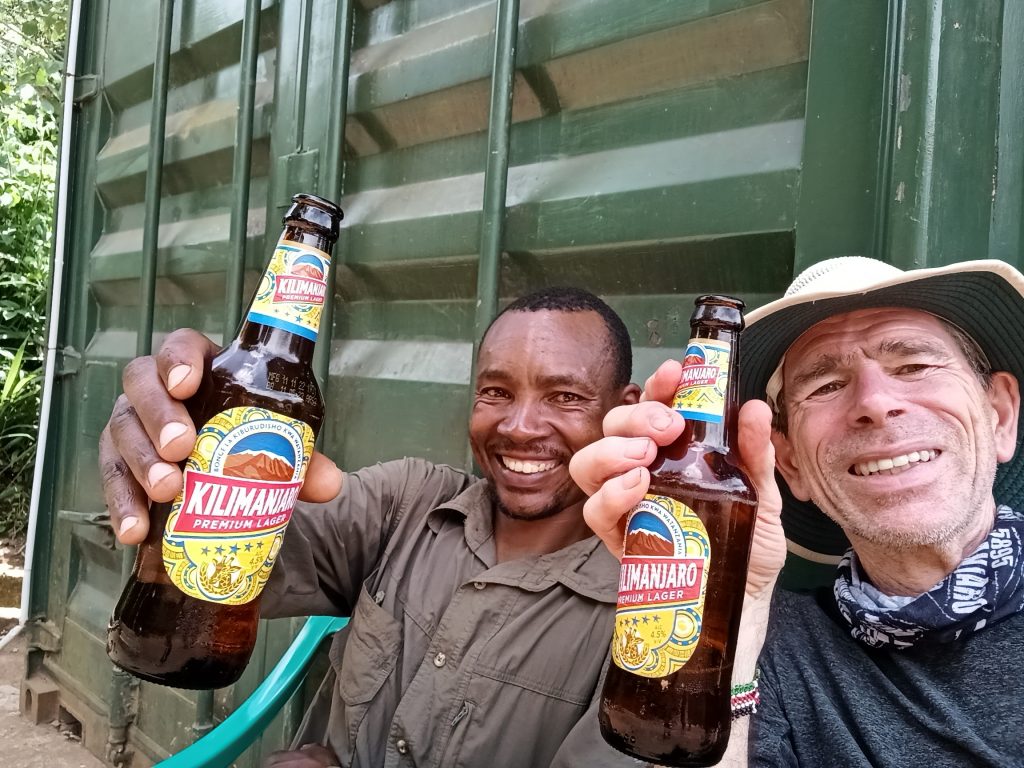
Then we all had to be officially signed out before being taken to an eatery nearby for lunch (now late lunch) and a chance to buy souvenirs and thank the team who’d supported us so well.
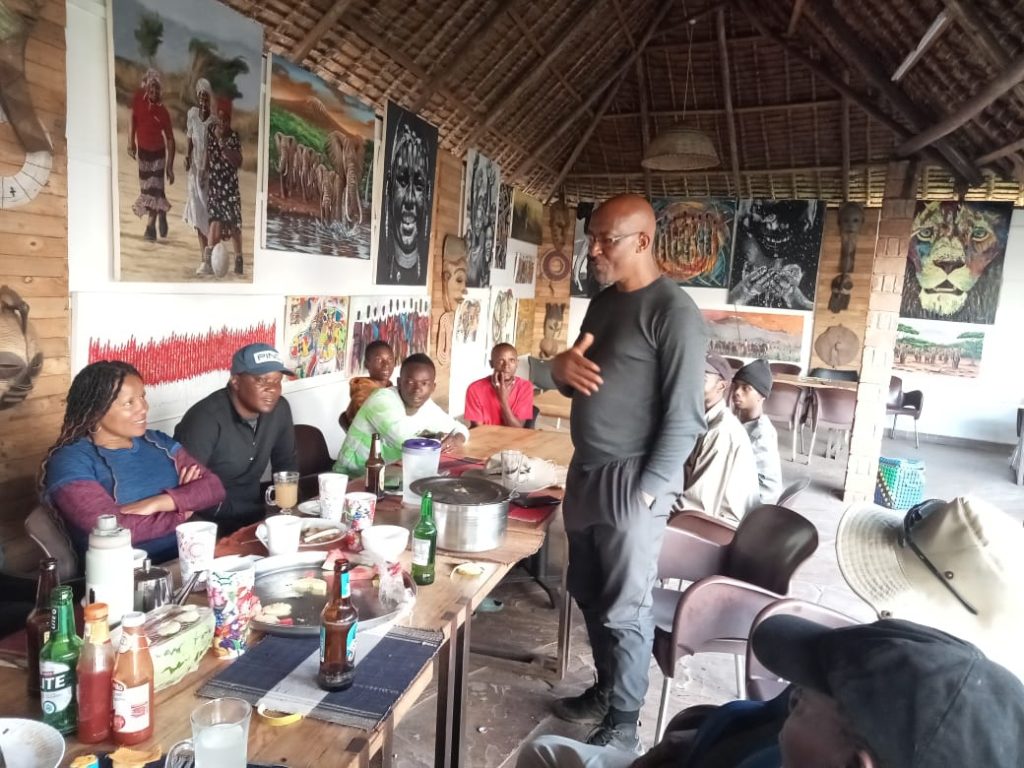
And then, back in the bus, via the hire shop to the Zebra Hotel in Moshi where we were awared our certificates of achievement by Ulrick, the head guide.
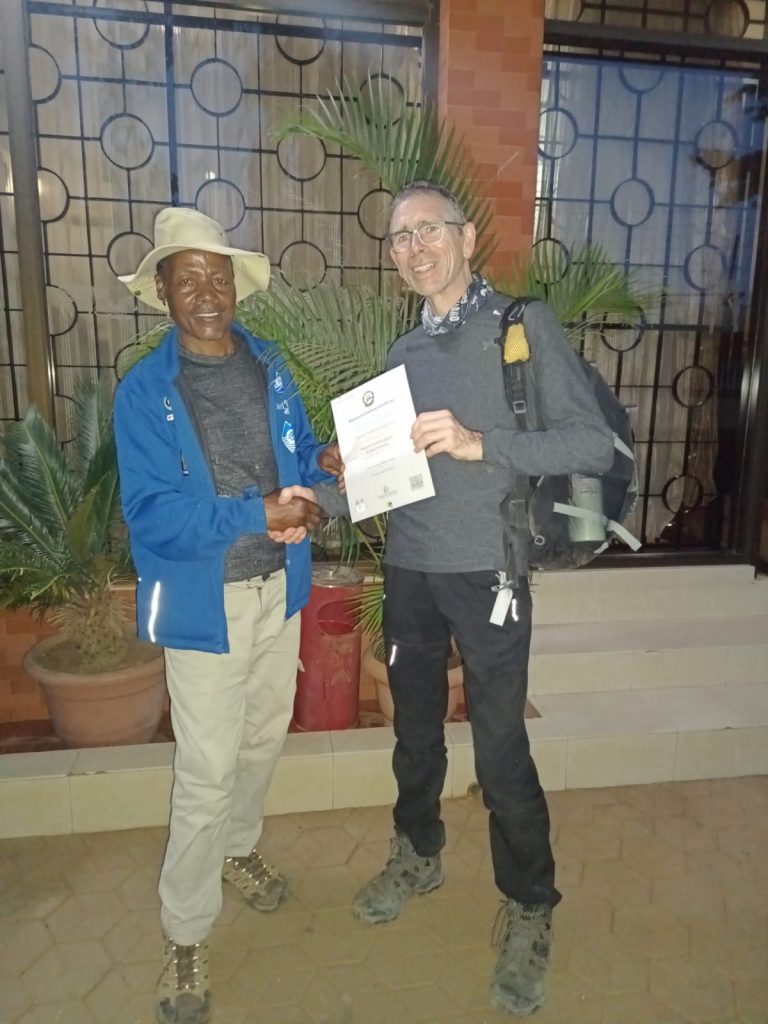
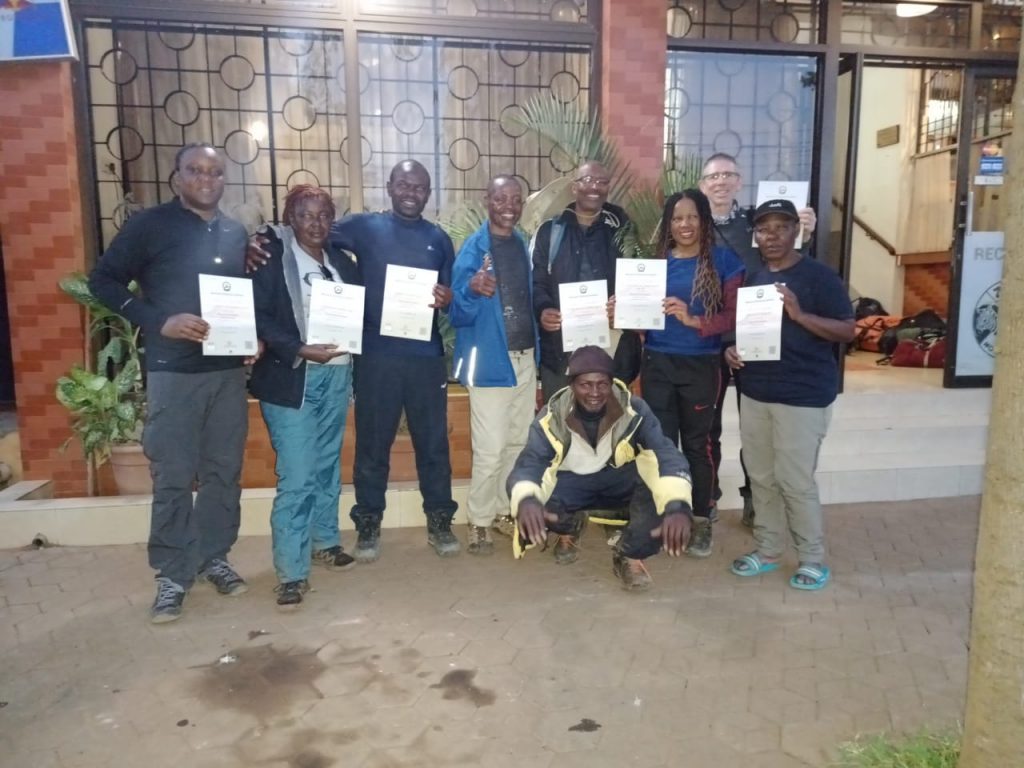
And then … shower (first for a week), dinner, more beers, bed (first for a week), repacking AGAIN. Saturday morning we were taken to the Kenyan border at Holili where our ways parted.
https://www.outdooractive.com/en/route/hiking-route/kilimanjaro-summit/260267160/
Our final ascent started at 00h30, in darkness, with us all lighting our way with headtorches. A snake of guides and hikers, among other snakes (other parties) all making their way up the mountain. We were already a good way up the mountain, which stands high above the surrounding land, and it was a clear night. There was an amazing view of the twinkling lights of Moshi way, way below us.
We continued in our snake for some time, walking polepole as instructed, but Coach Steve had an urgent call of nature and the group fragmented. I guess they didn’t want us all standing around in the cold (and it was pretty cold, though it didn’t penetrate my layers of insulation). Engr Anthony and I found ourselves with a guide who didn’t seem to have received the polepole briefing and we found ourselves asking him to give us time for breath. In the thin air, everytime I stumbled and gasped I had to wait and get my breathing back under control. The guide was helpful, carrying things like water bottles but we might have set a more realistic pace.
Talking of stumbling, i did quite a bit of that as in the limited light my depth perception was poor, and there was no shortage of odd rocks to trip over.
We weren’t quite at the top when the sun rose, but it was pretty spectacular.

It was pretty tough. As we neared the top I was getting confused (e.g. asking Nashon “where has Nashon gone?” and at Stella Point (where we met the rim I wanted to sit down but wasn’t allowed. We got some photos, but what happened thereafter is a bit of a blur until sometime later we were descending.
View into the crater.
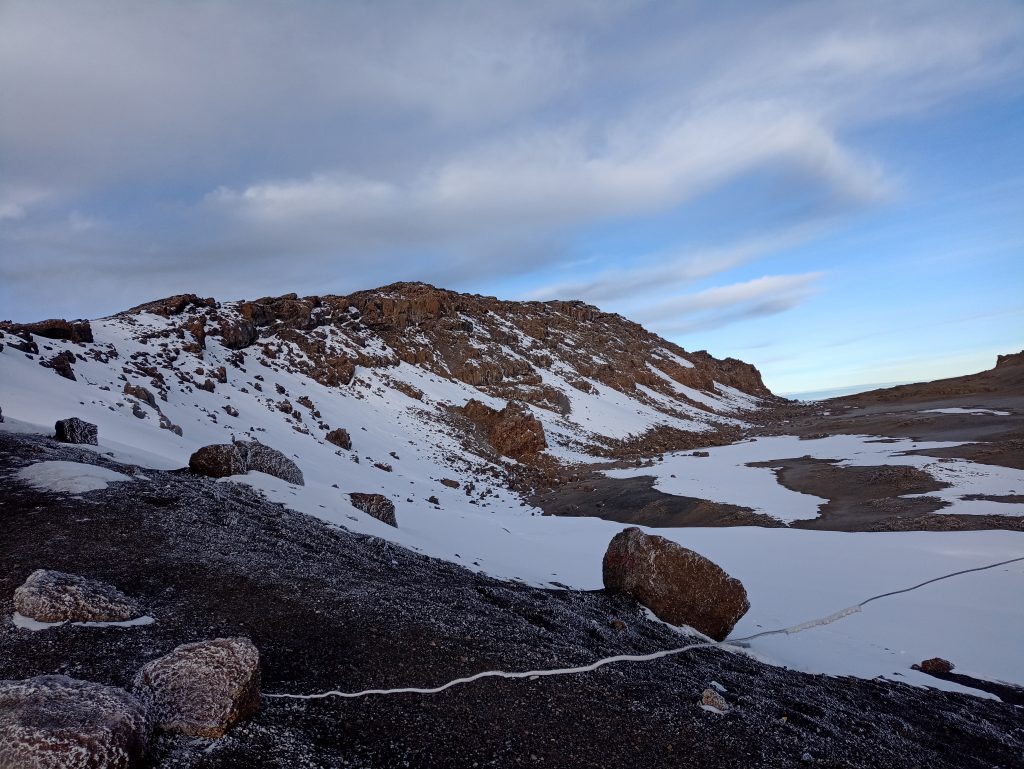
Me at Stella Point
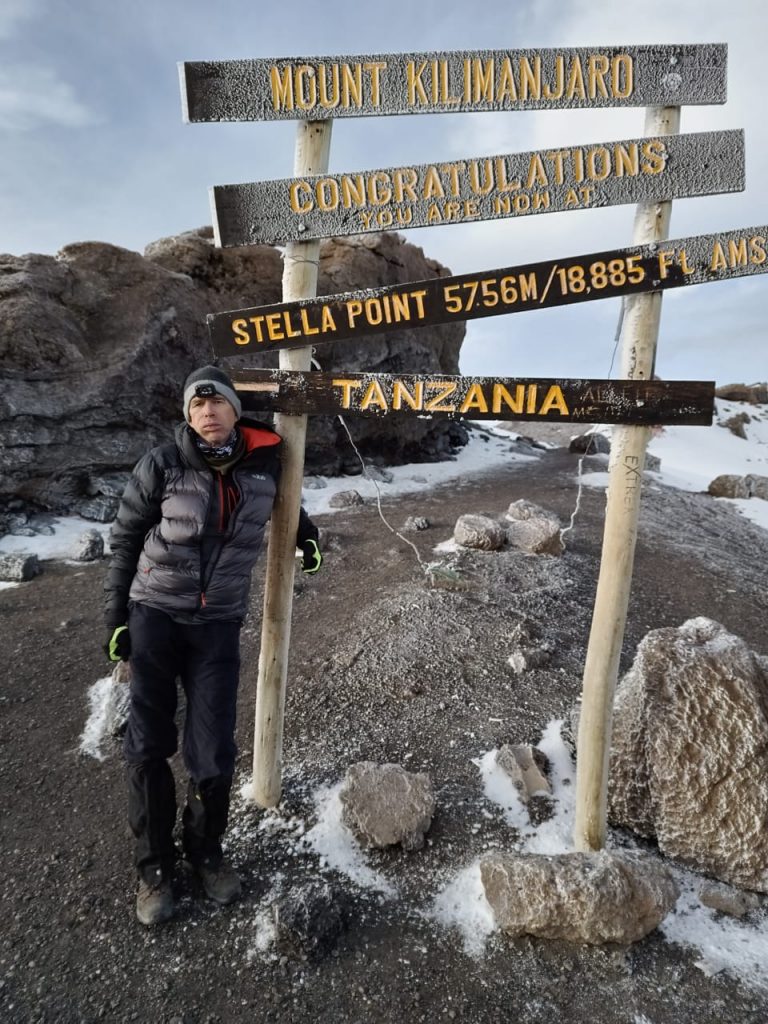
Me on the rim, more confused than usual.
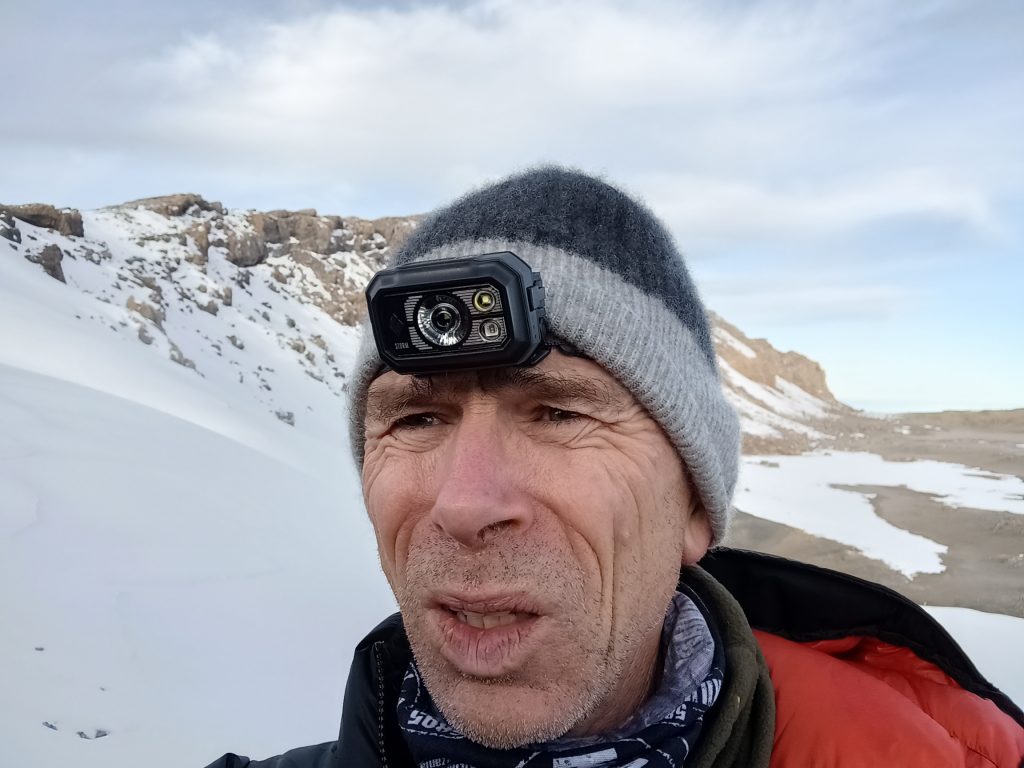
Approaching the summit.
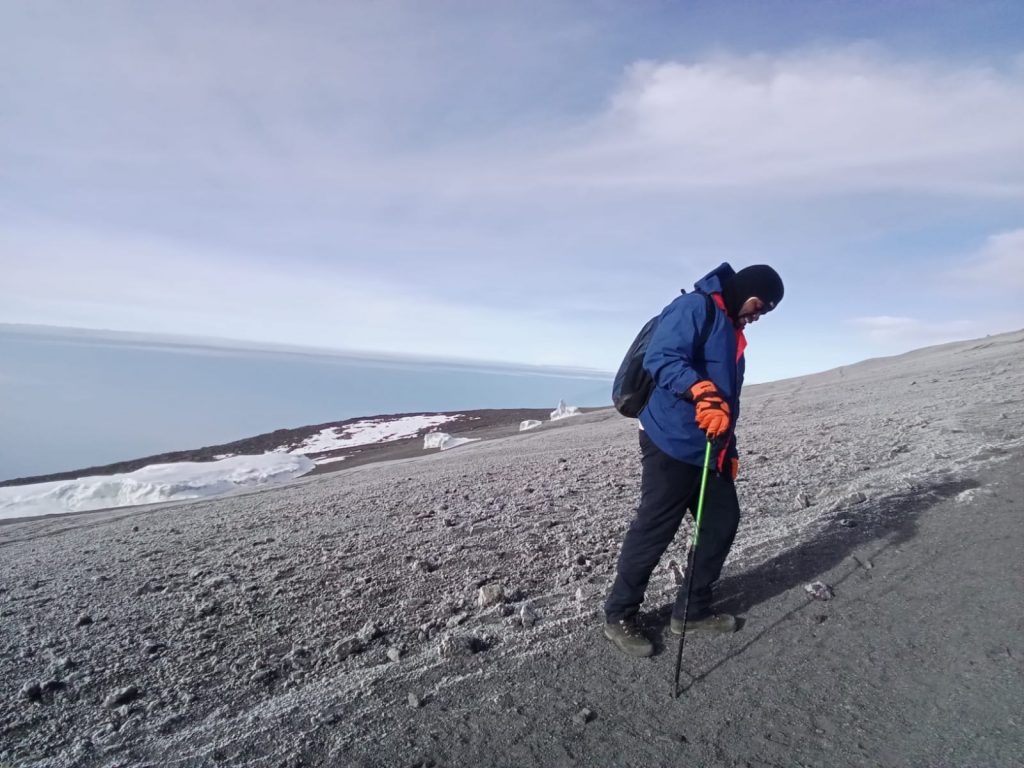
Uhuru Peak

Starting the descent

As you descend (in daylight) you get better views of the hill around you., if only you can stop to take a photo, and preferably not get your dayglo glove in the way.
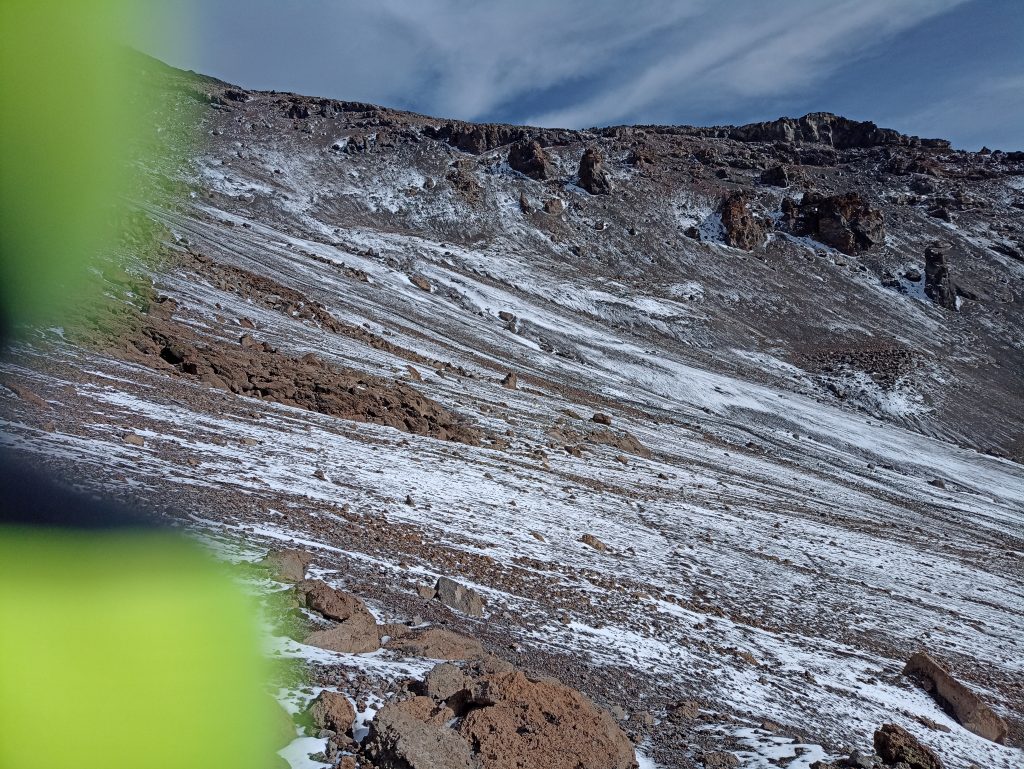

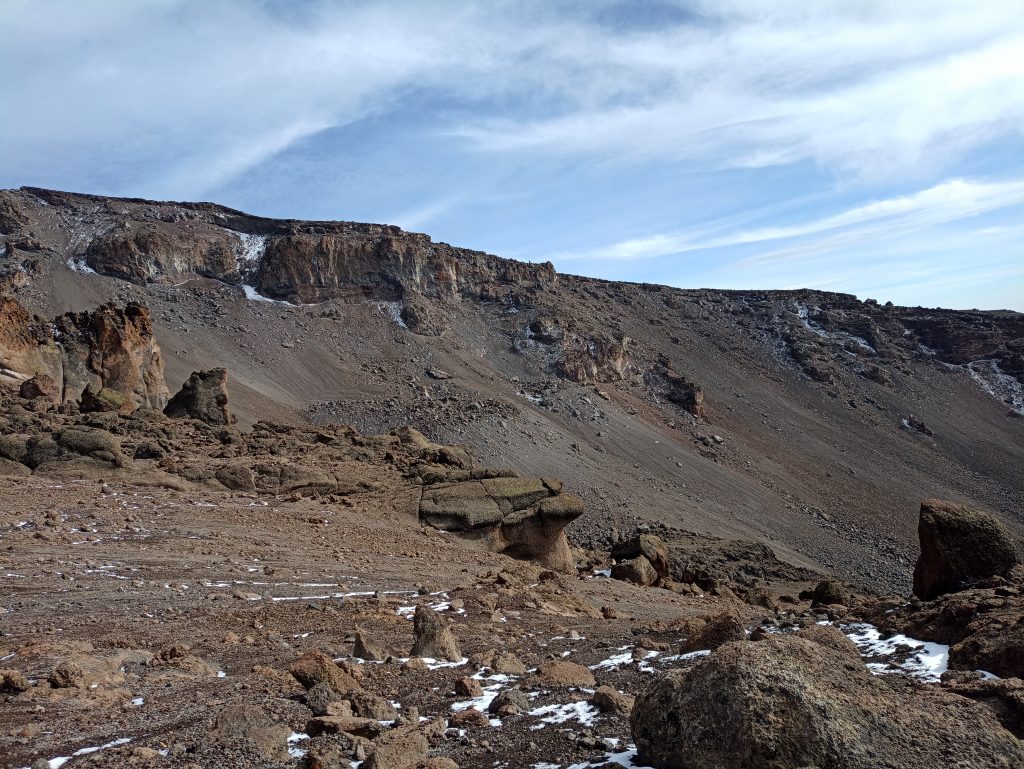
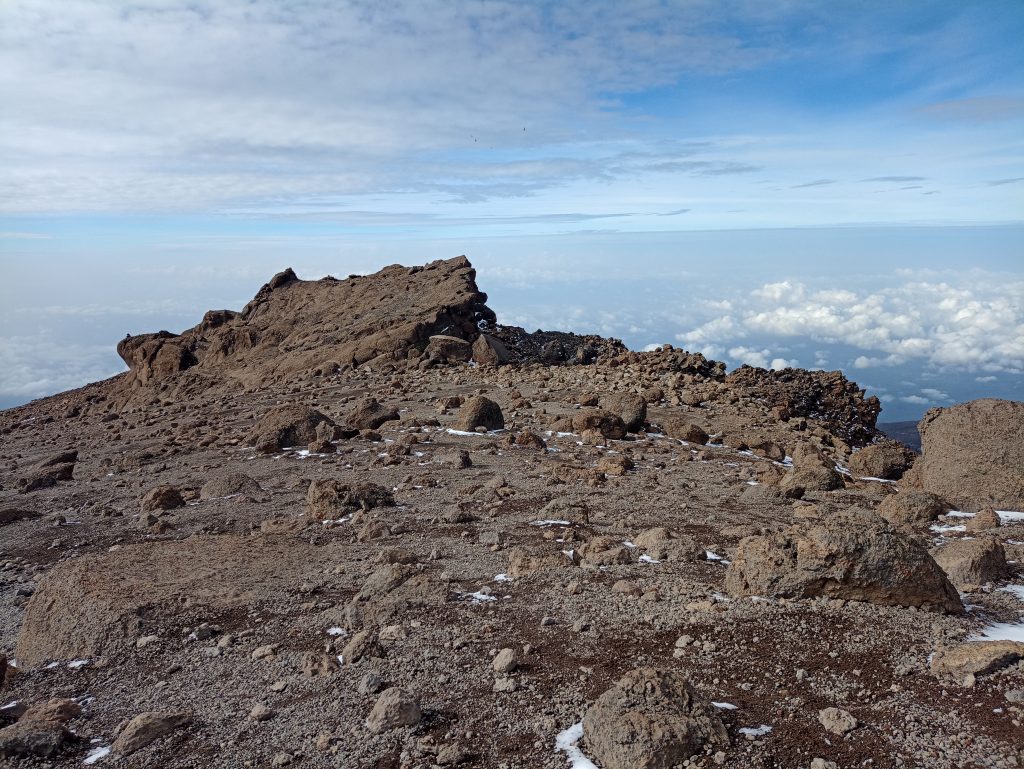
Approaching Barafu Camp from above, our line of yellow/green tents in the middle.
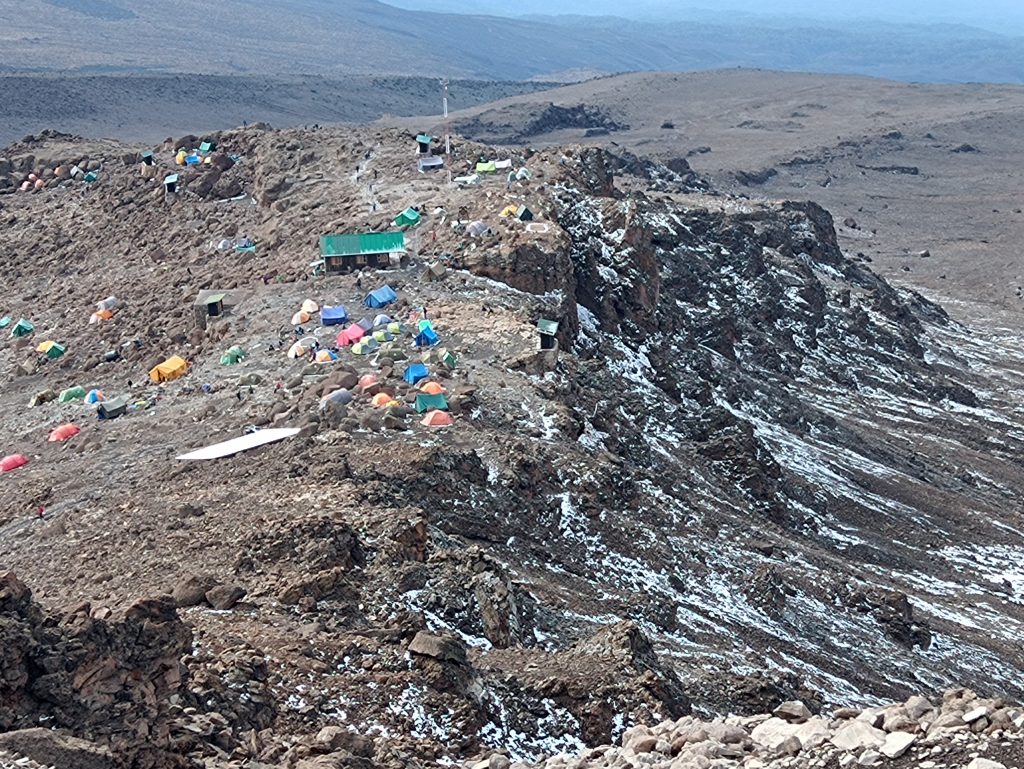
Back at Barafu Camp we had time to relax, snack, pack etc. Some of the group were hours later getting down, and I think I might have enjoyed the experience more if we hadn’t rushed, but c’est la vie.
We were not allowed to stay another night at Barafu, so we had to hike down another 4km to Millennium Camp. On the way we passed the “Kilimanjaro Ambulances” used to evacuate stretcher cases. You’d need to be in a bad way to want top travel on one of those!
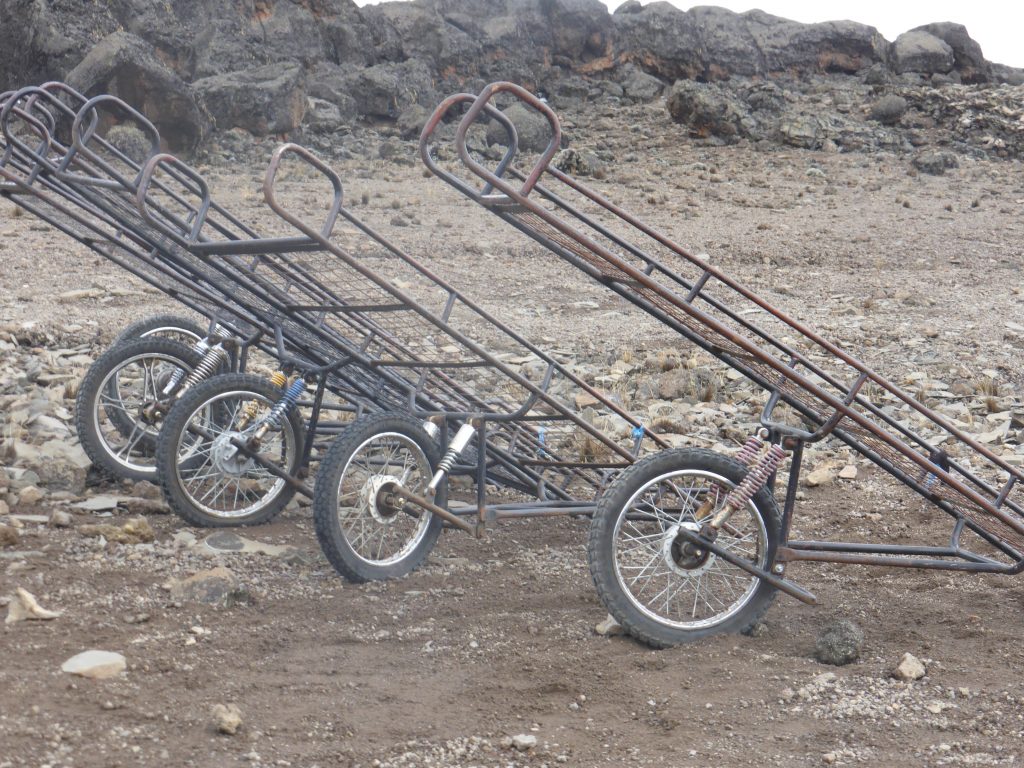
And so, to our last Camp, and a blissful night’s sleep.

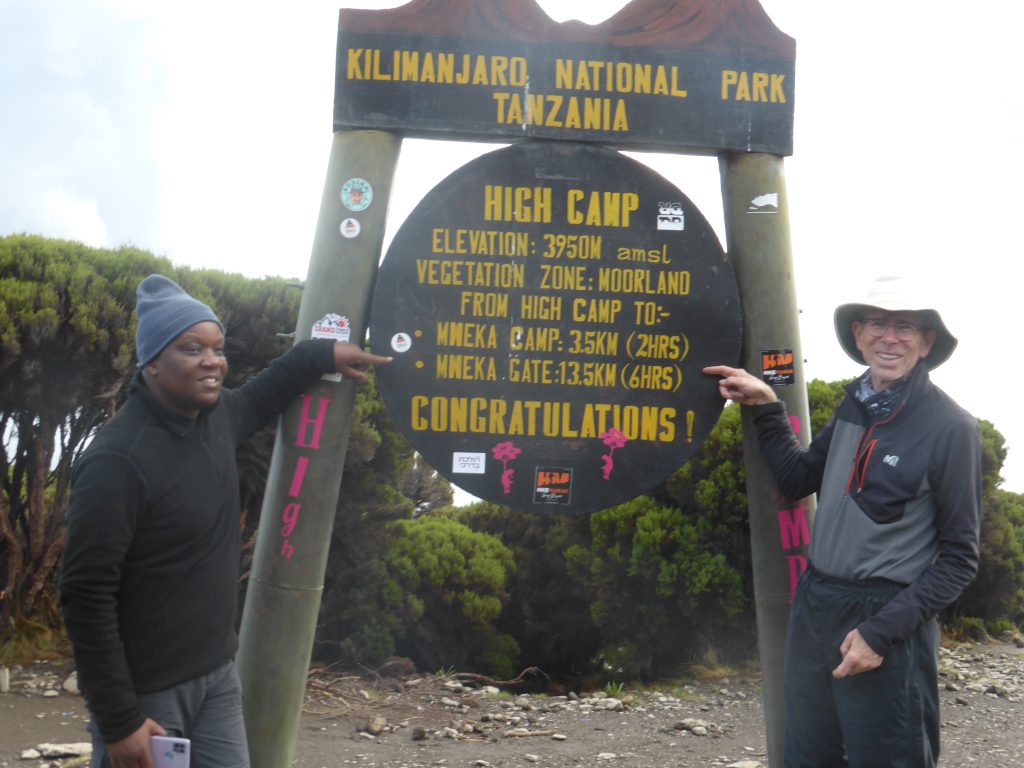
Again the morning was clearer than the precious afternoon and there were views up the mountain.
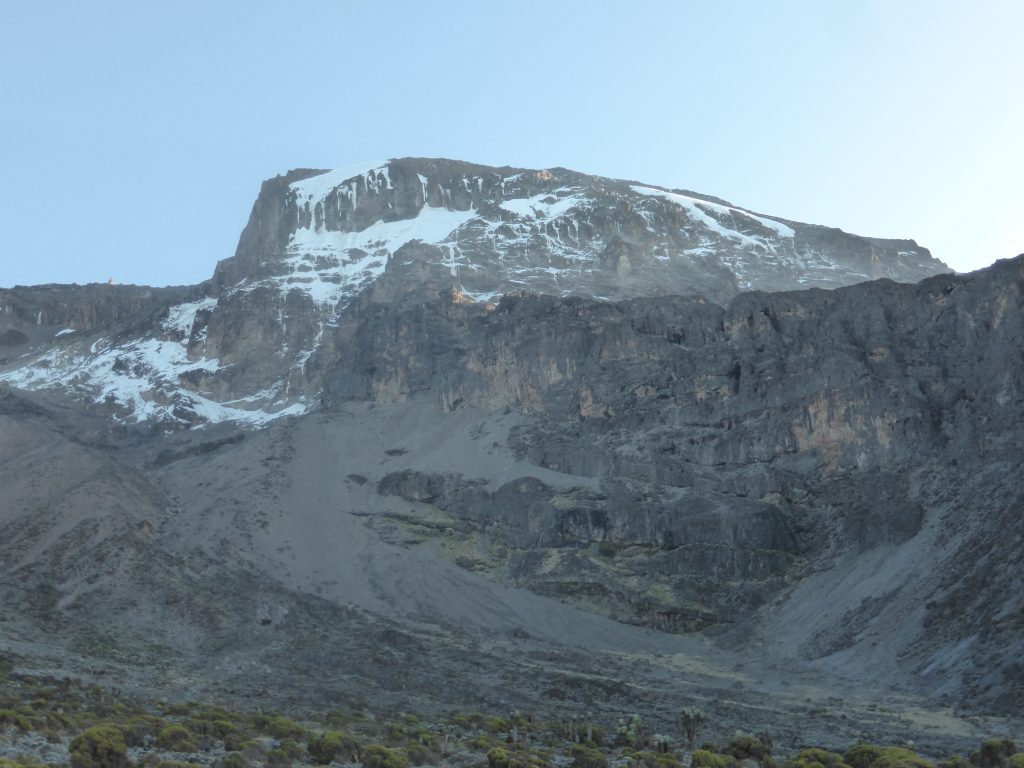
First we had to scale in the infamous Barranco Wall – a solid rock face that towers over the camp and looks really difficult to climb. In reality the route is well defined and there’s just more pushing up than walking forwards.
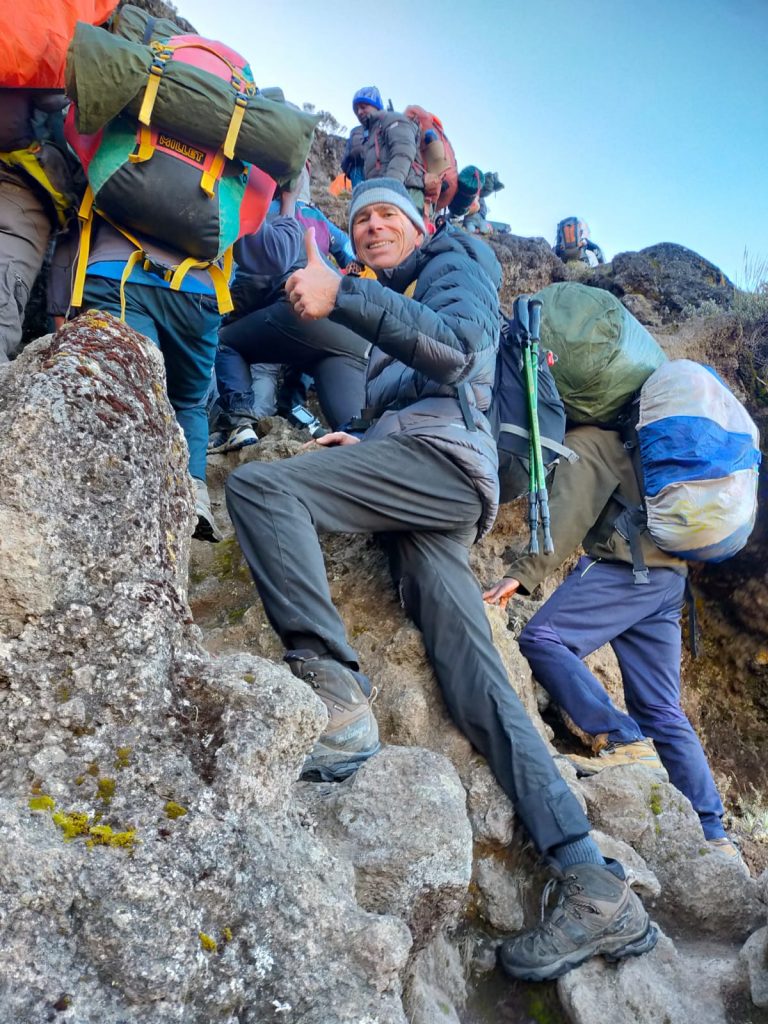
There were some narrow gaps to squeeze through
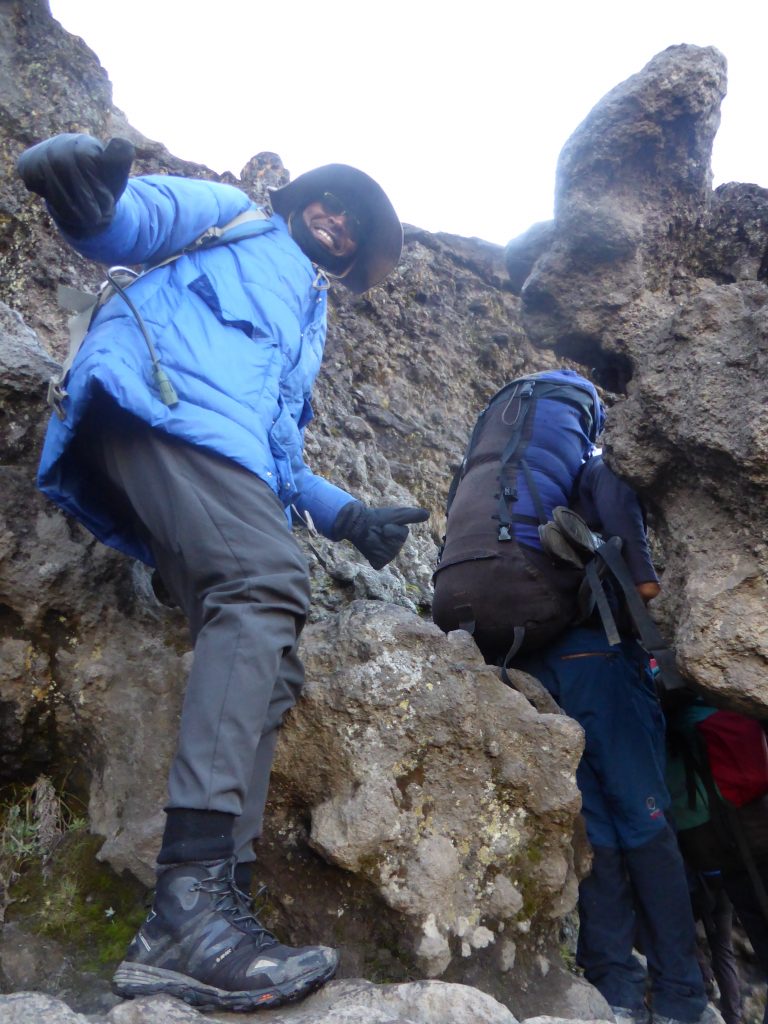
And the famous “kissing rock” where you slide round with your face to the rockface.
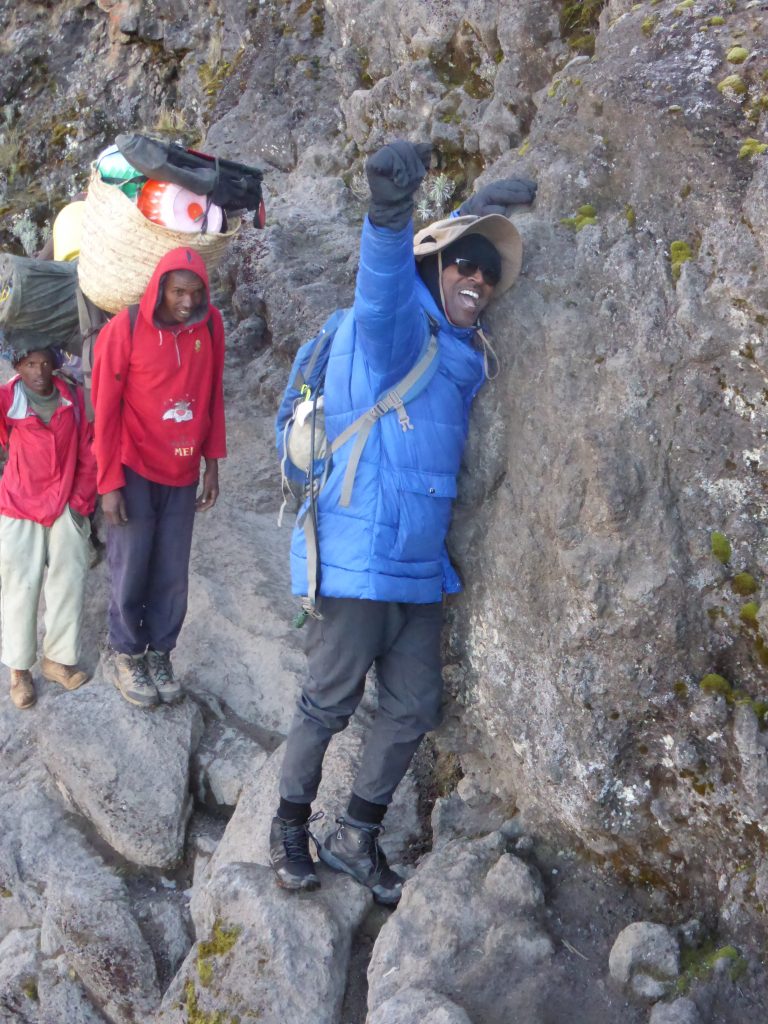
As we climbed, the views got better
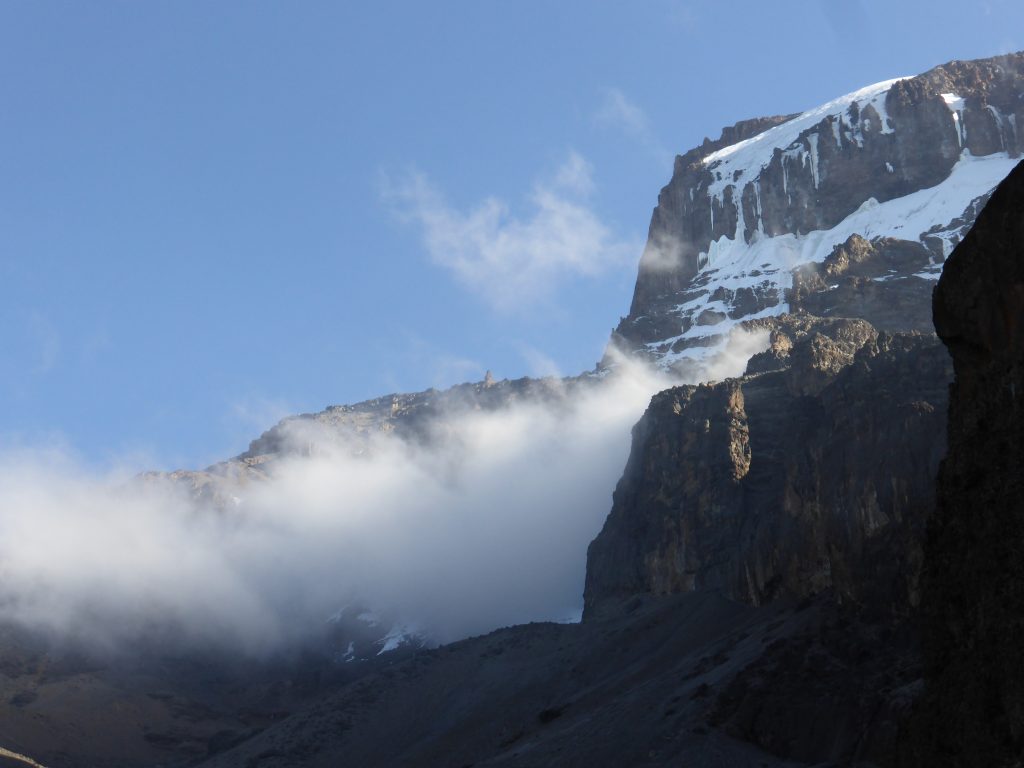
Having climbed the wall the route was up and down, with the off place to sit and rest
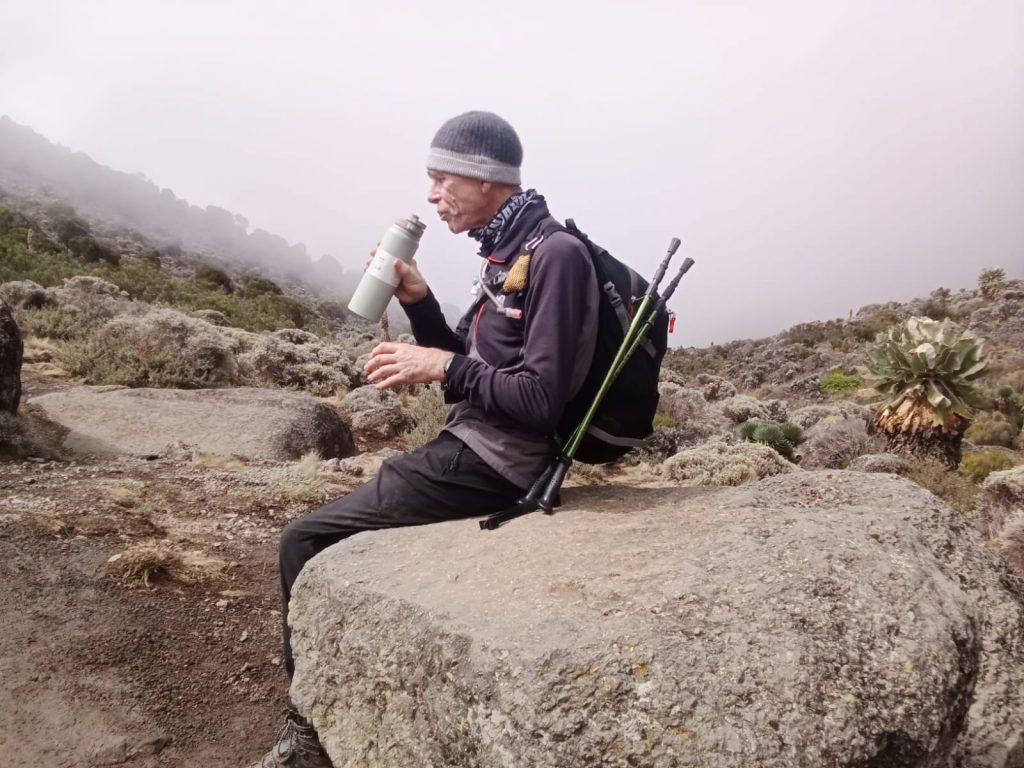
At Karanga Camp the weather was closing in again.
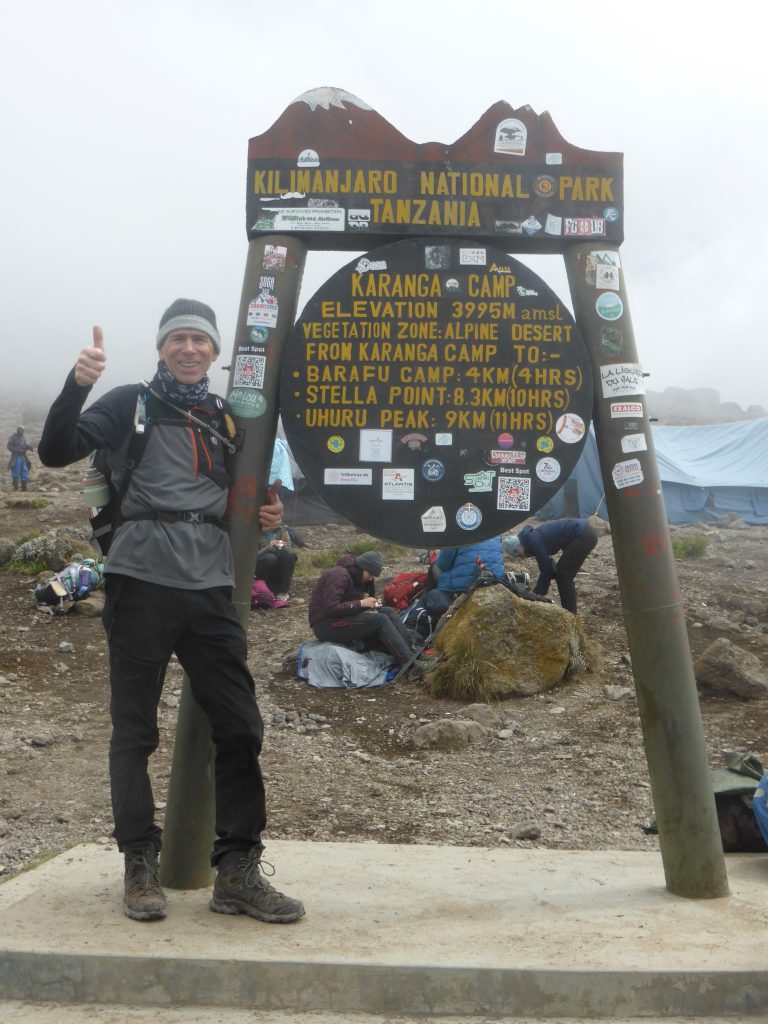
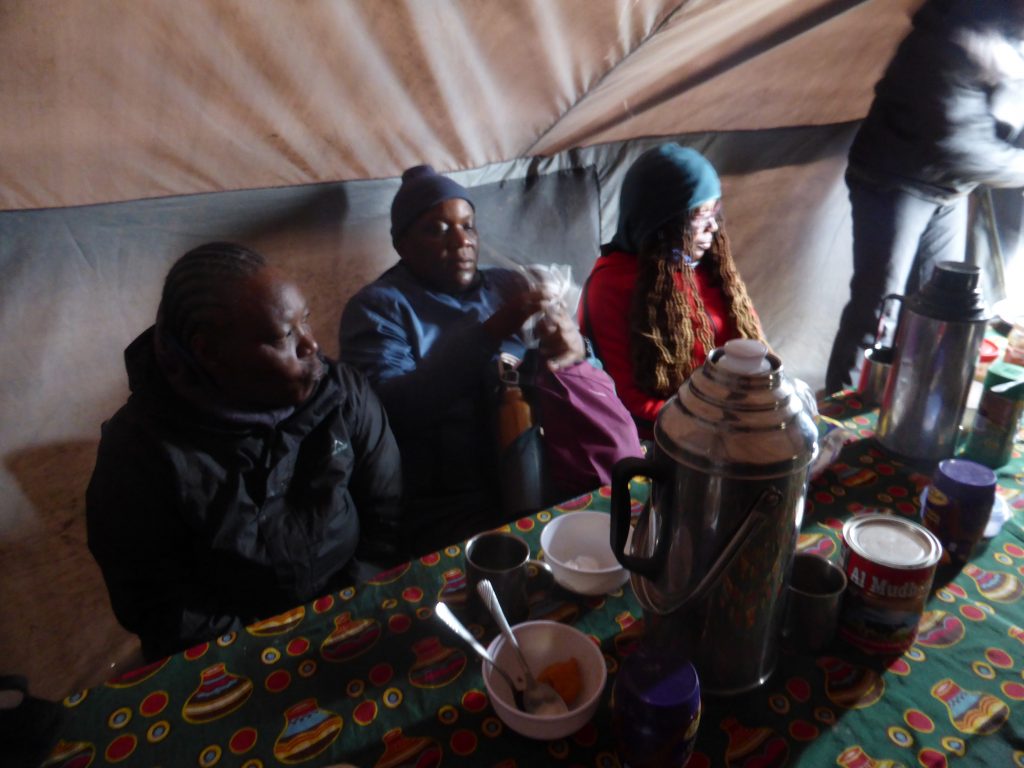
After lunch we set off again into a minor blizzard. We’d actually dropped lower than the start point, and had over 800m to climb to Barafu Camp.
We were relieved to reach Barafu Camp
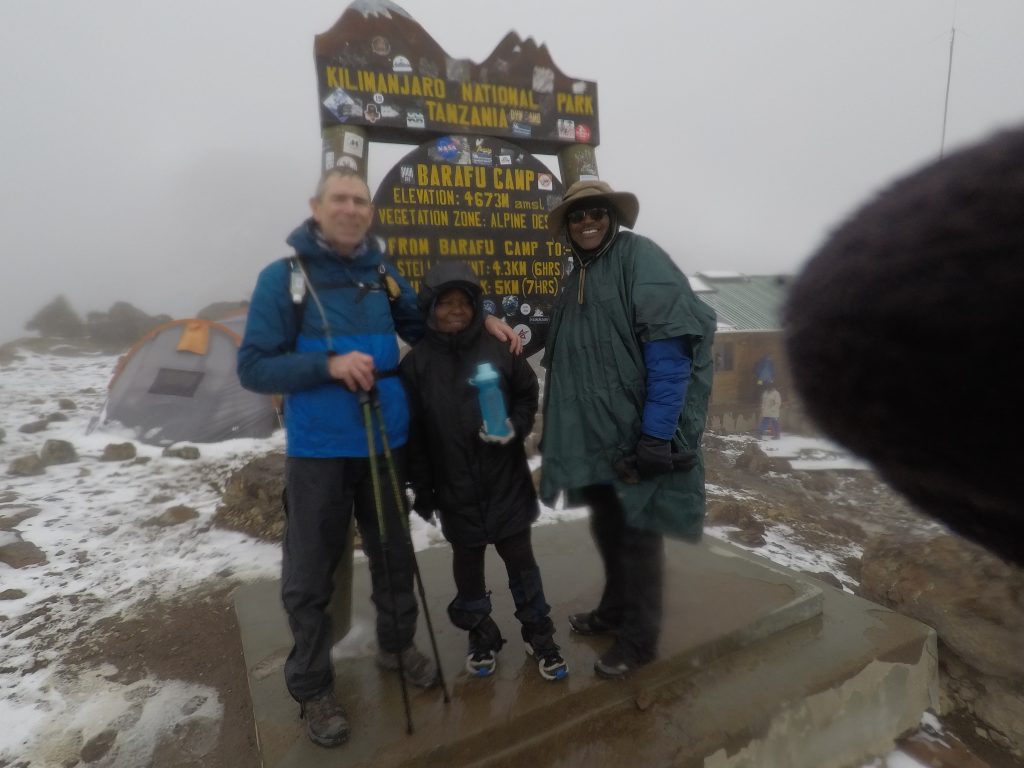
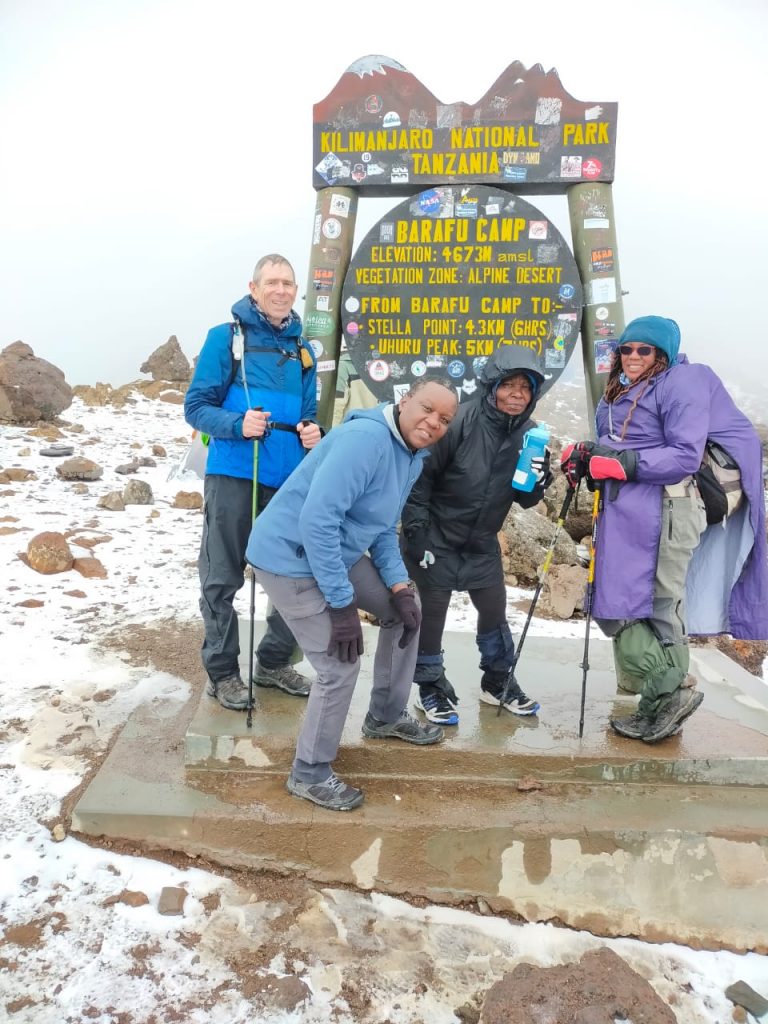
However, as we sat by the hut waiting for our camp to be ready, the sun emerged
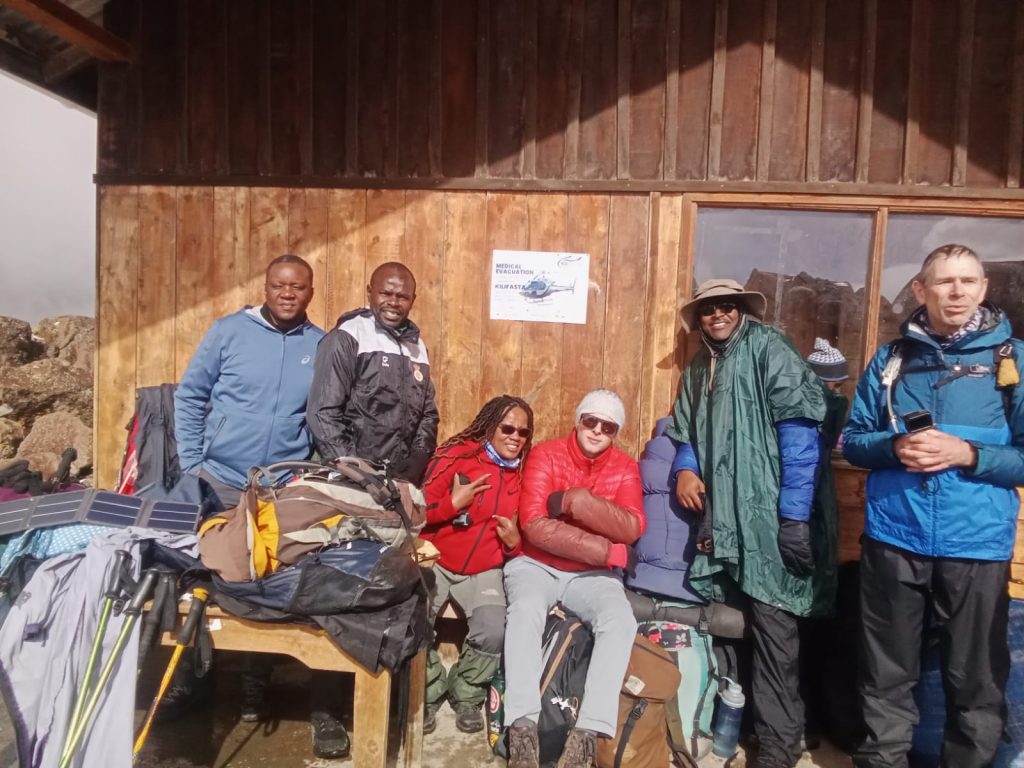
Here we are joined by hikers from Brisbane and BC – the whole world comes to Kilimanjaro.
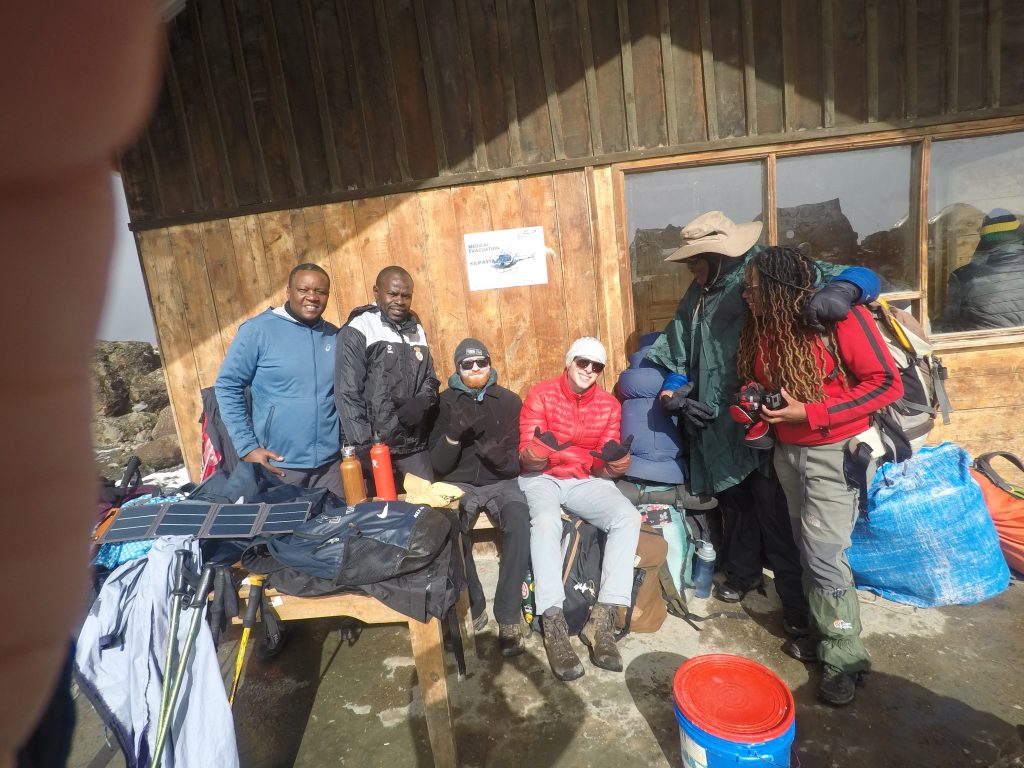
Even the summit came out to see us briefly
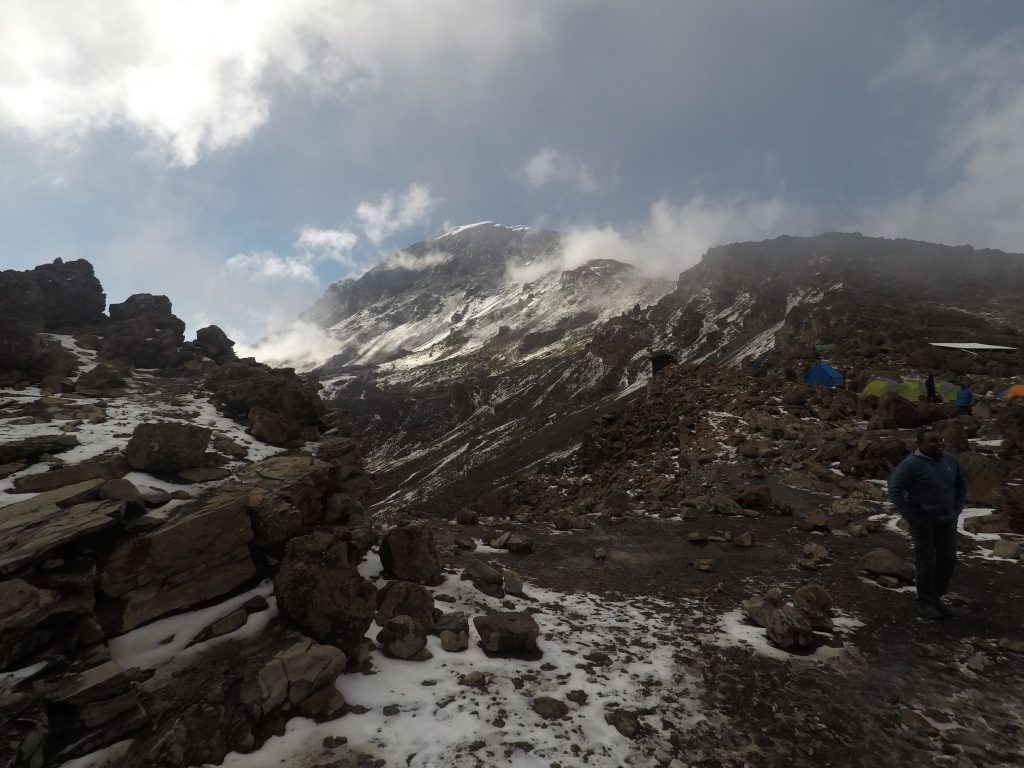

And so to camp, to be fed and to rest ahead of our ludicrously early start in the middle of the night. And they fed us PIZZA – good pizza. How do they manage that on the mountainside?
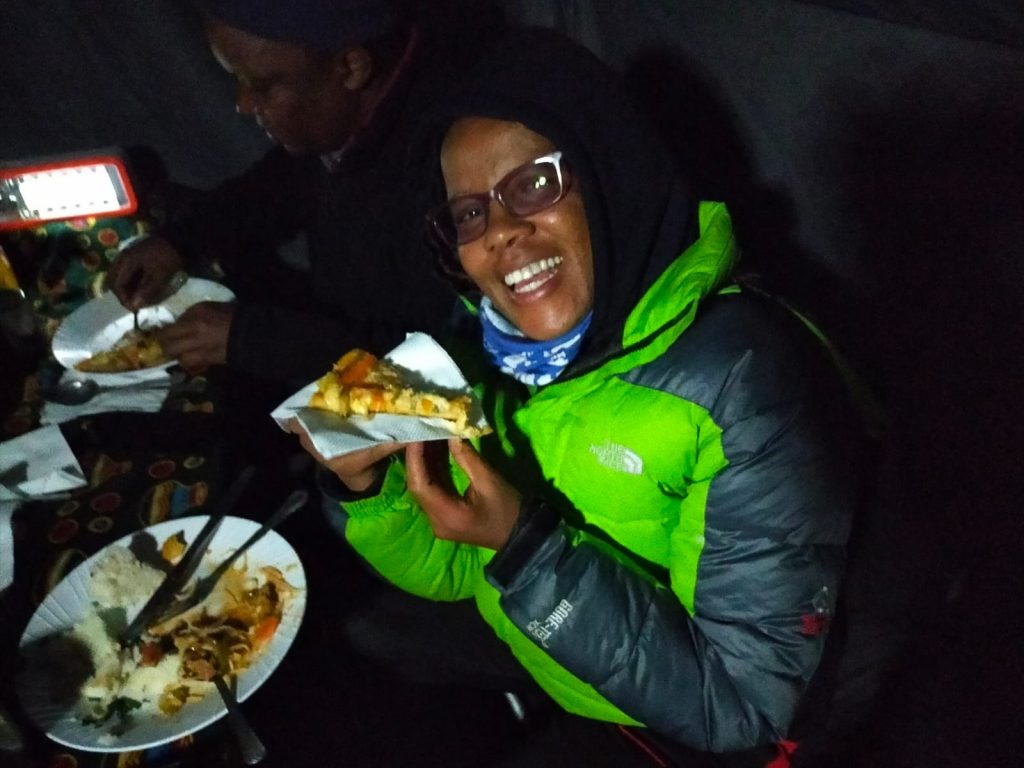
https://www.outdooractive.com/en/route/hiking-route/hike-shira-camp-to-barranco-camp/260266897
After yesterday afternoon in the clouds, today dawns clear and we have sight on the mountain above our camp.
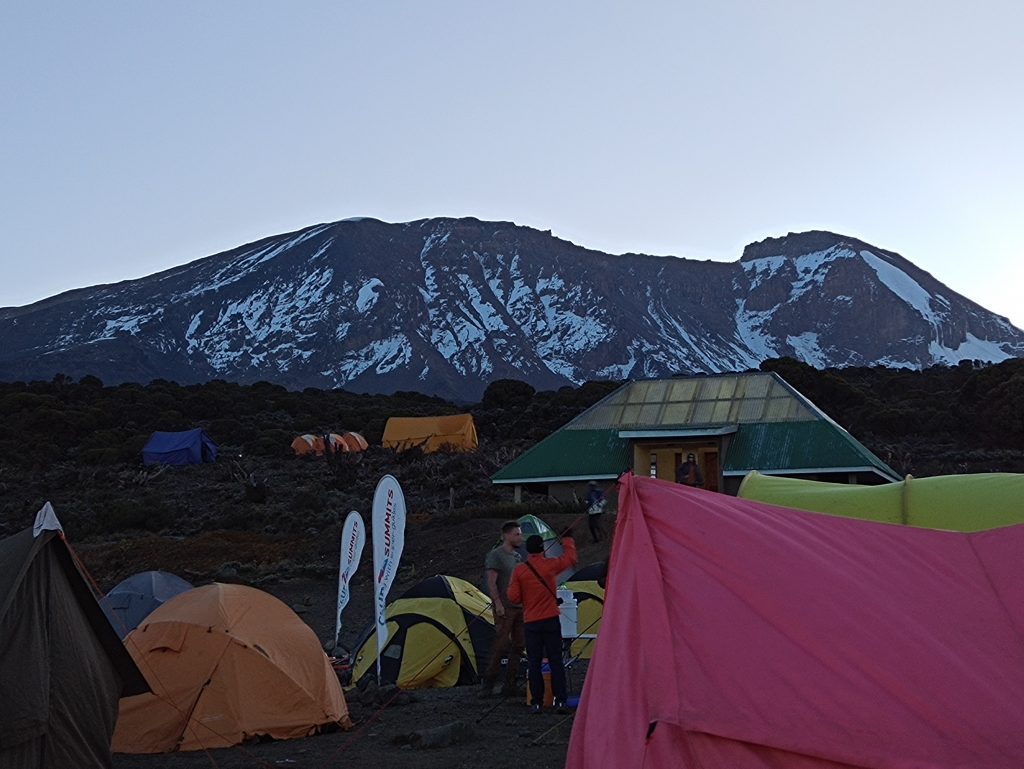
There are a lot of people here, and a lot of kit to be gathered up and carried by the porters.

Our team are ready for the day. It’s cool, but bright.
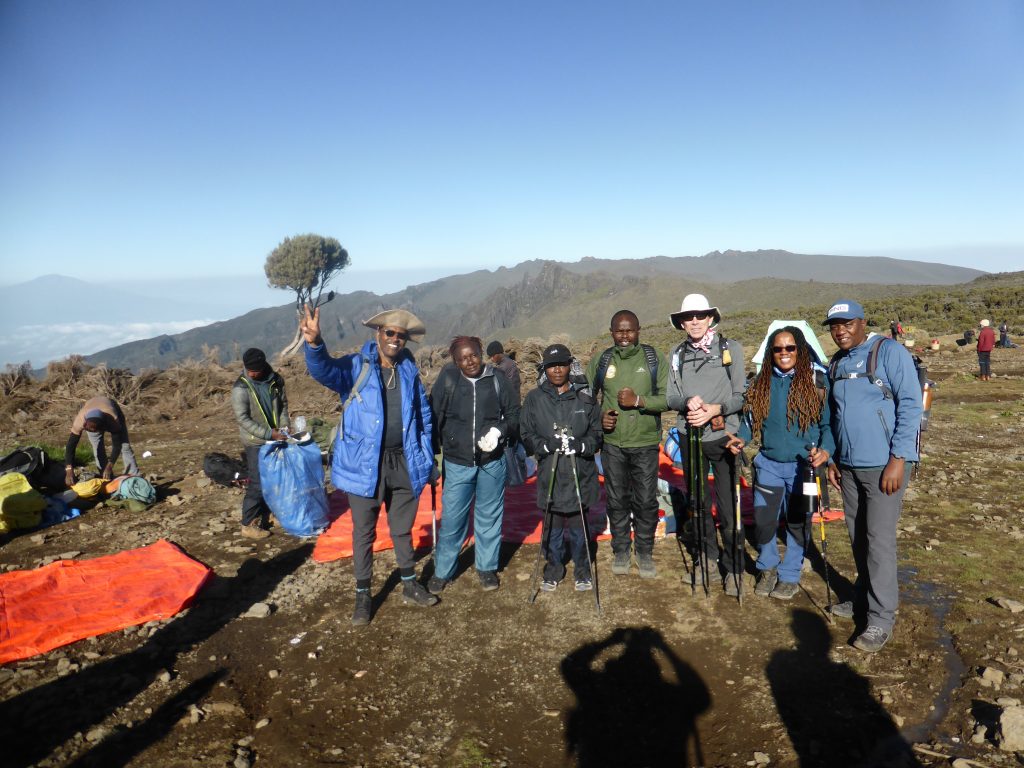
The morning was a long slog uphill – about 800m of ascent over 6.5km. The vegetation was getting sparser, but we had a view of the mountain to encourage us.
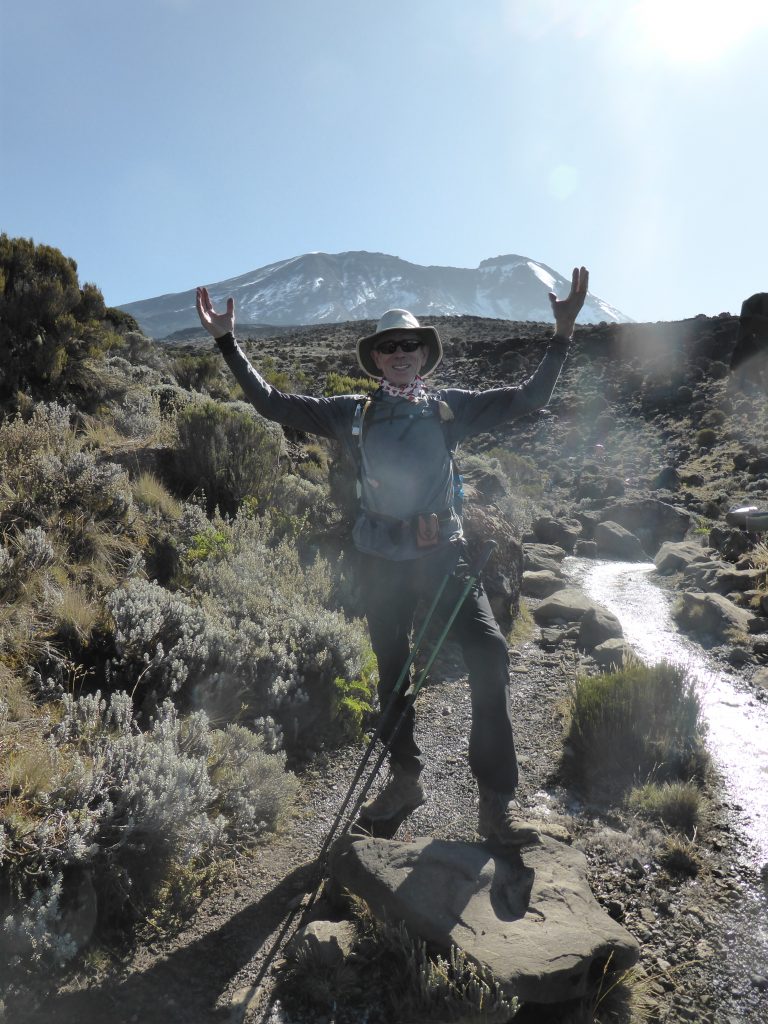
Not quite as processional as yesterday where overtaking was largely impossible, but a long ribbon of people snaking up the mountain. We were in awe of the porters carrying everything including the kitchen sink, while we just had daypacks.

Faith and Mary take a quick break.

As we got higher the clouds rolled in – not above us but around us – and the terrain became rougher.
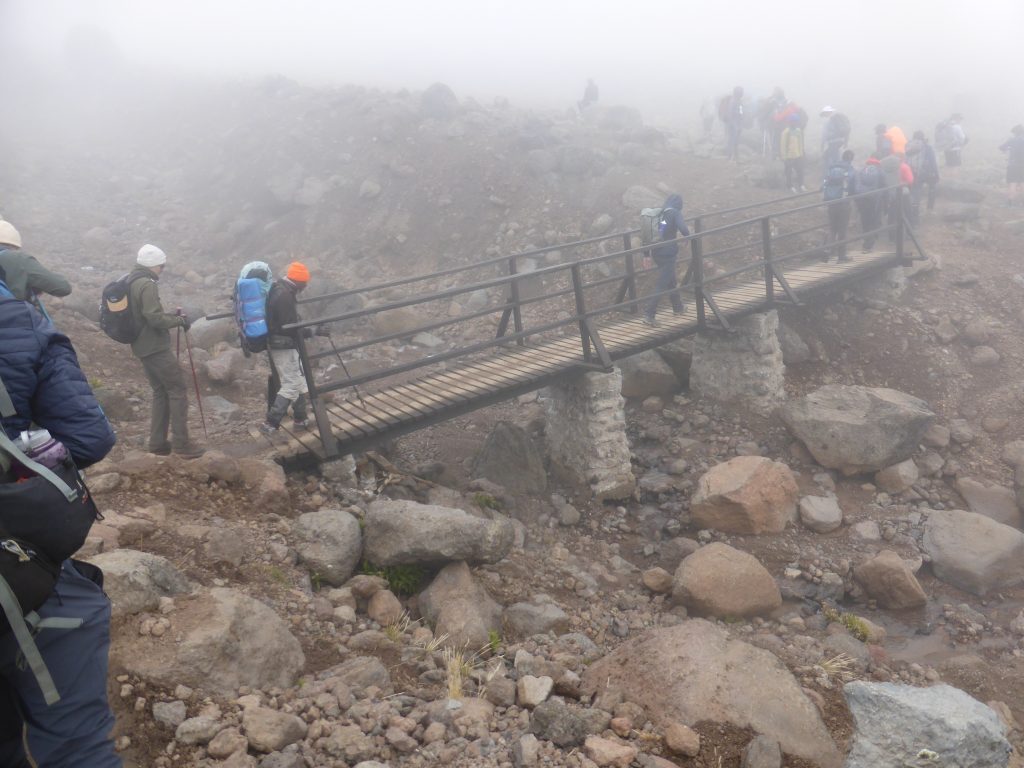
We eventually reached Lava Tower, where they had erected the mess and kitchen tents (and our loo) so we could dine in “comfort”. It was decidedly chilly in the damp breeze so shelter was essential.
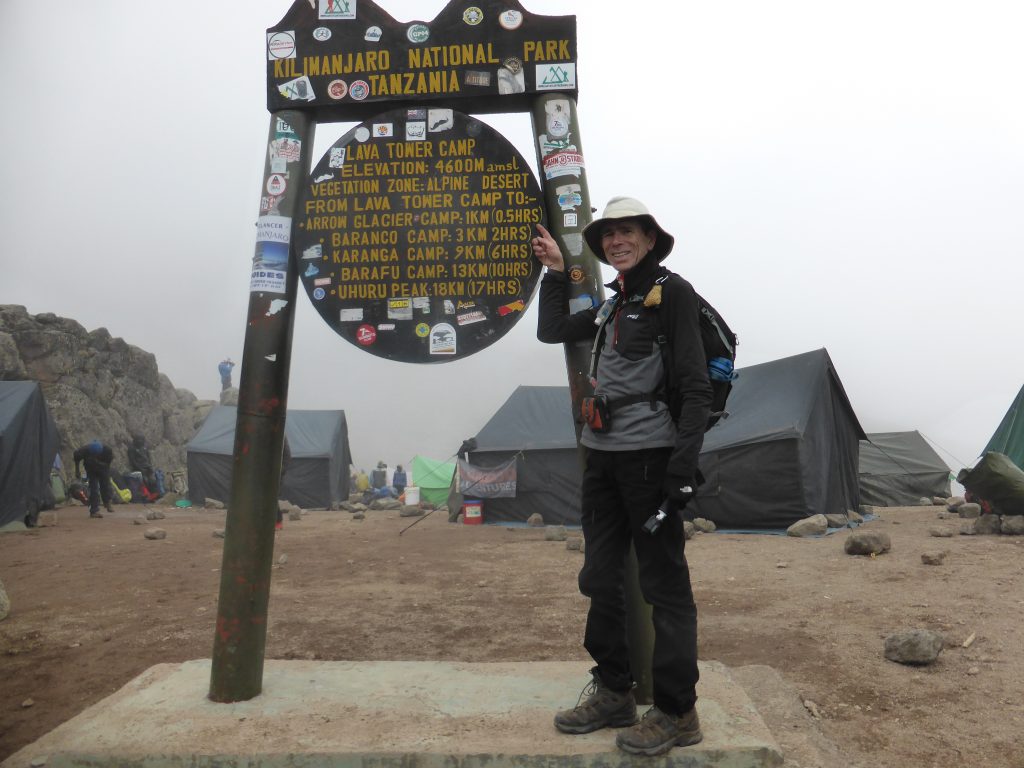
The Lava Tower could just about be made out in the mist. Finding the way down was also tricky!
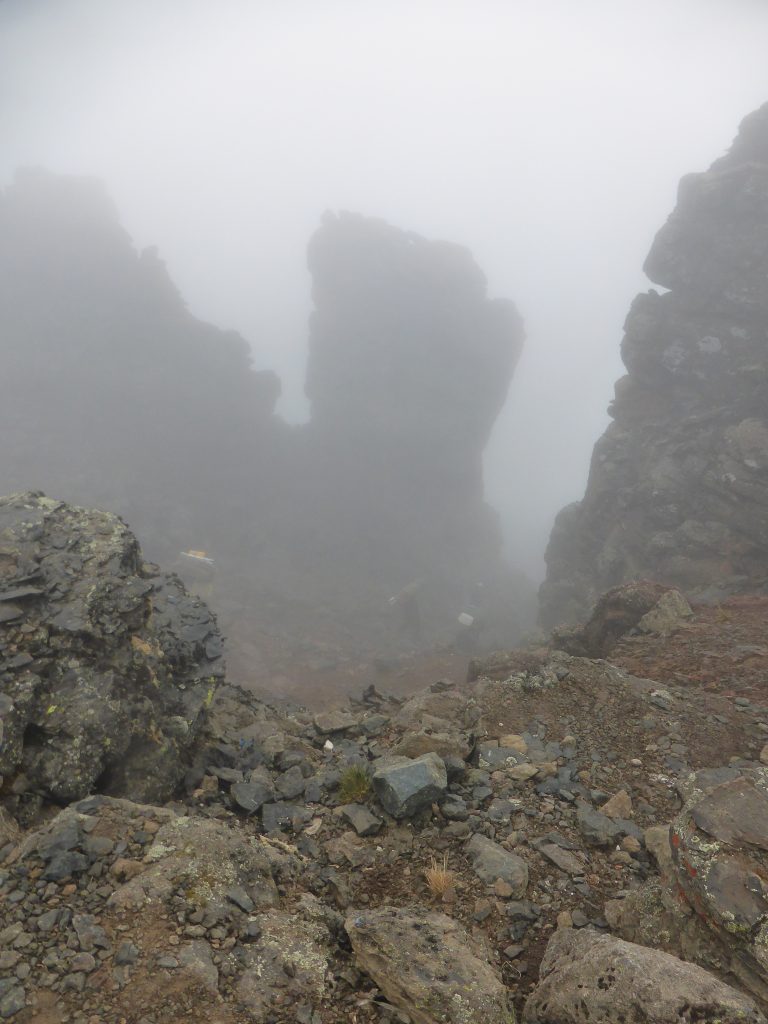
The afternoon was a descent of some 600m on wet shale (“hike high sleep low” being the mantra for avoiding altitude sickness). On this side there was some pretty weird vegetation, made even weirder by the mist. Well, maybe mizzle rather than mist because we got quite wet despite not sensing precipitation – should have worn my waterproof not a down jacket! Also note that the photos are from GoPro as the regular camera was stowed away to keep dry.
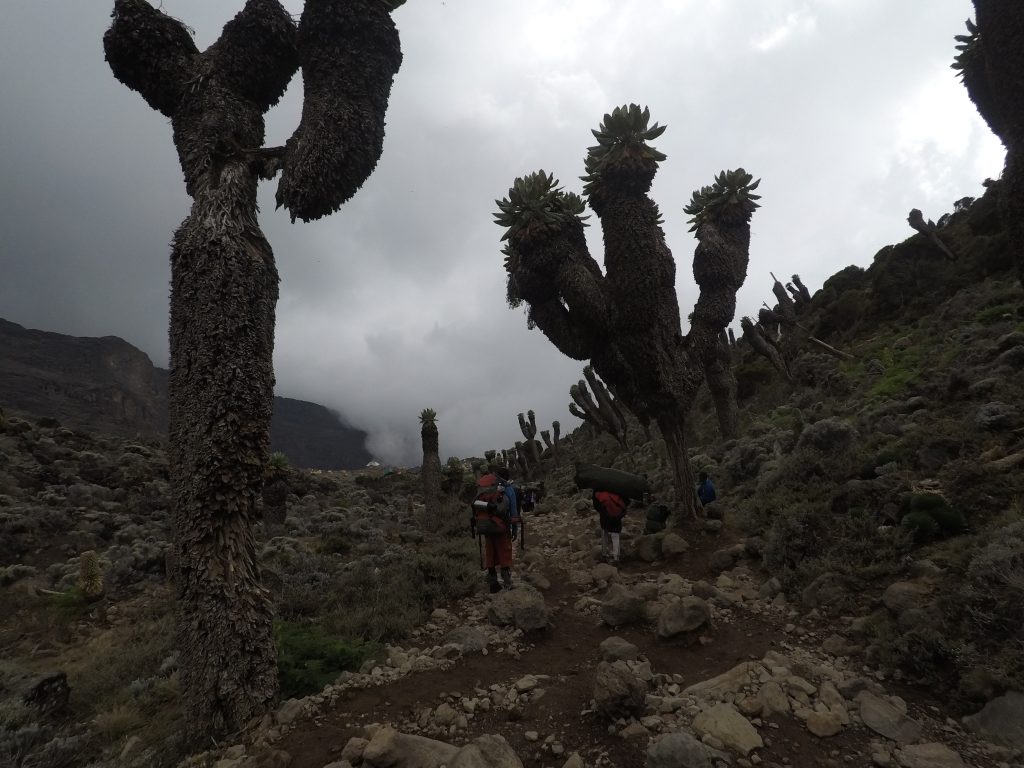

It was still pretty damp when we reached our next camp, tents perched between the rocks, the walk to the toilet tent a short but challenging adventure!

In the safety of the tent I took off my socks and inspected my legs and feet. Sunburn from Ngong Hills still shining, and swollen where the socks didn’t compress them. Still, felt OK.
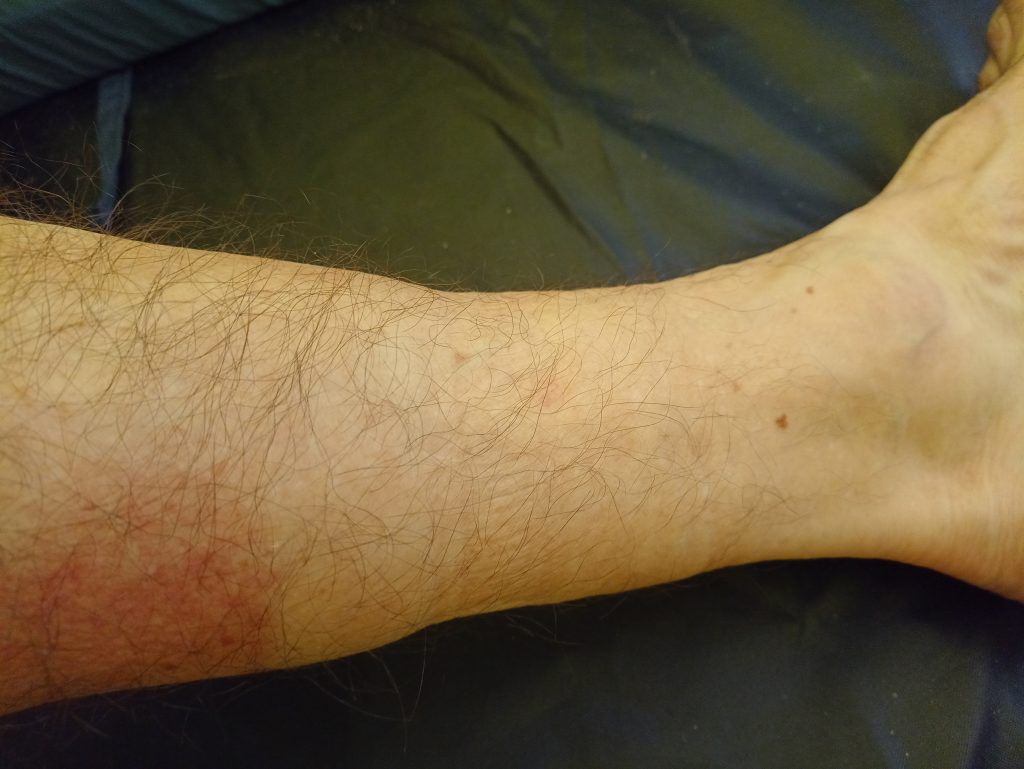
Hike: Machame Camp to Shira Camp • Hiking Route » outdooractive.com
Today’s was just a morning hike climbing some 900m from 3,000m to 3,900m over 5.1km. That’s rather steeper than yesterday’s longer steady climb.
Having arrived not long before sundown yesterday, we got a better view of our camp this morning. The hikers are housed in the little green tents.
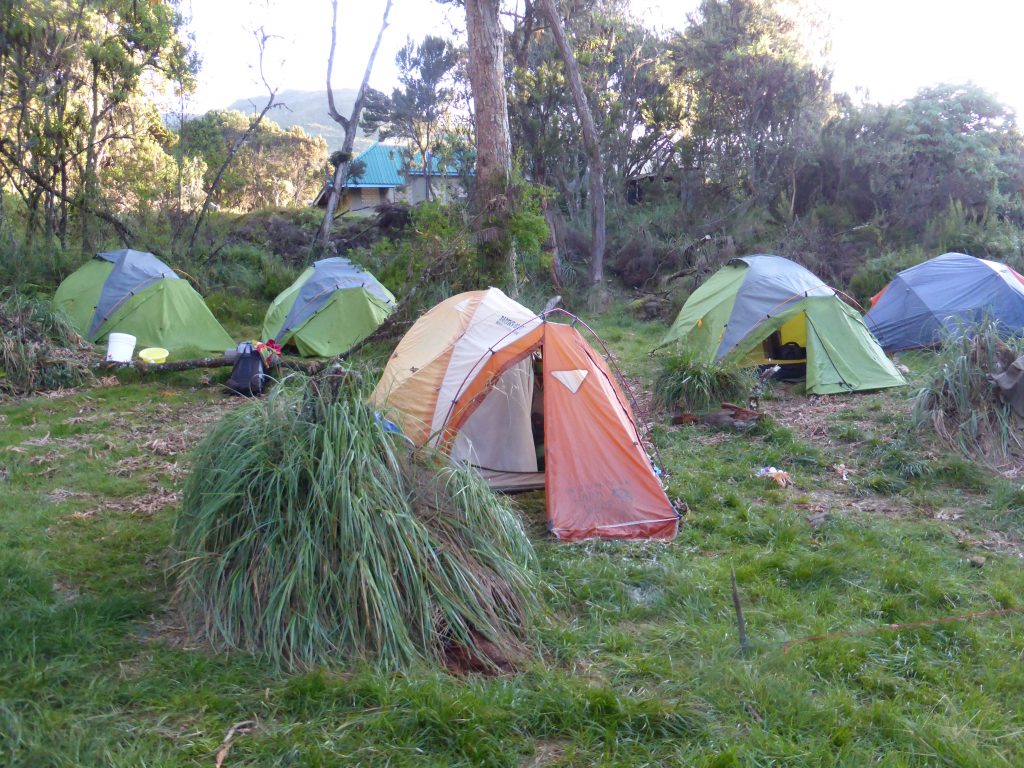
Breakfast was served in the mess tent – dark blue and always gloomy inside.
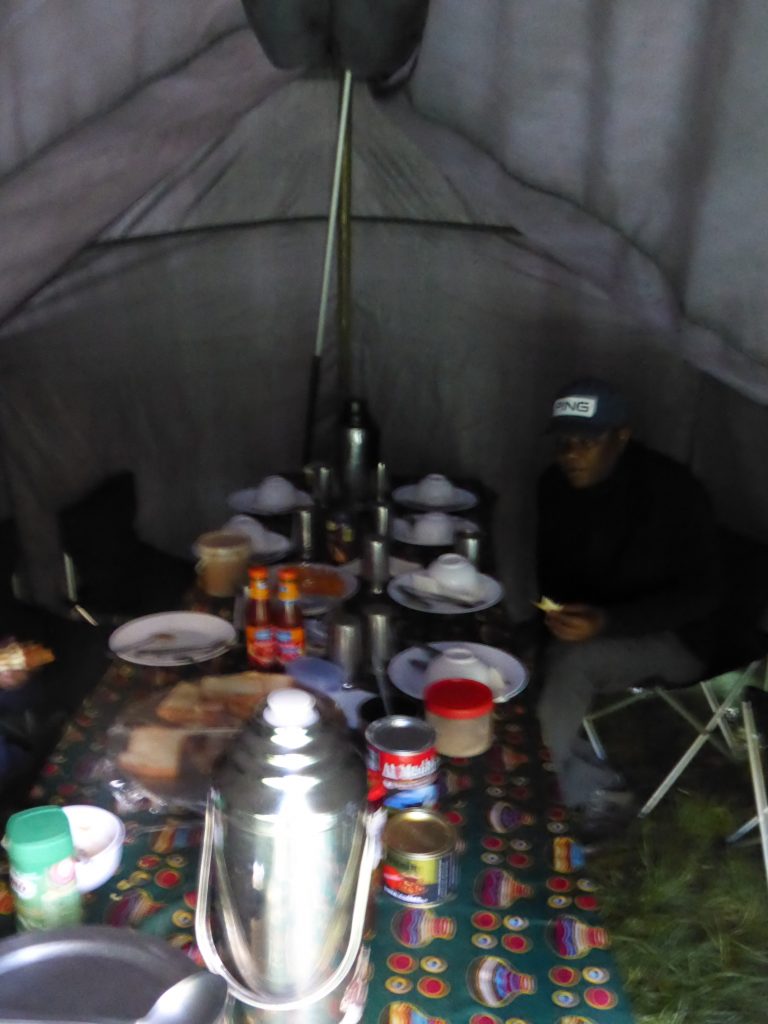
Mary, next oldest after me, is ready for the day.

The climb starts immediately and is relentless. But we’re only carrying ourselves and our day packs – the porters carry much more.

We are encouraged by the view ahead and around us.

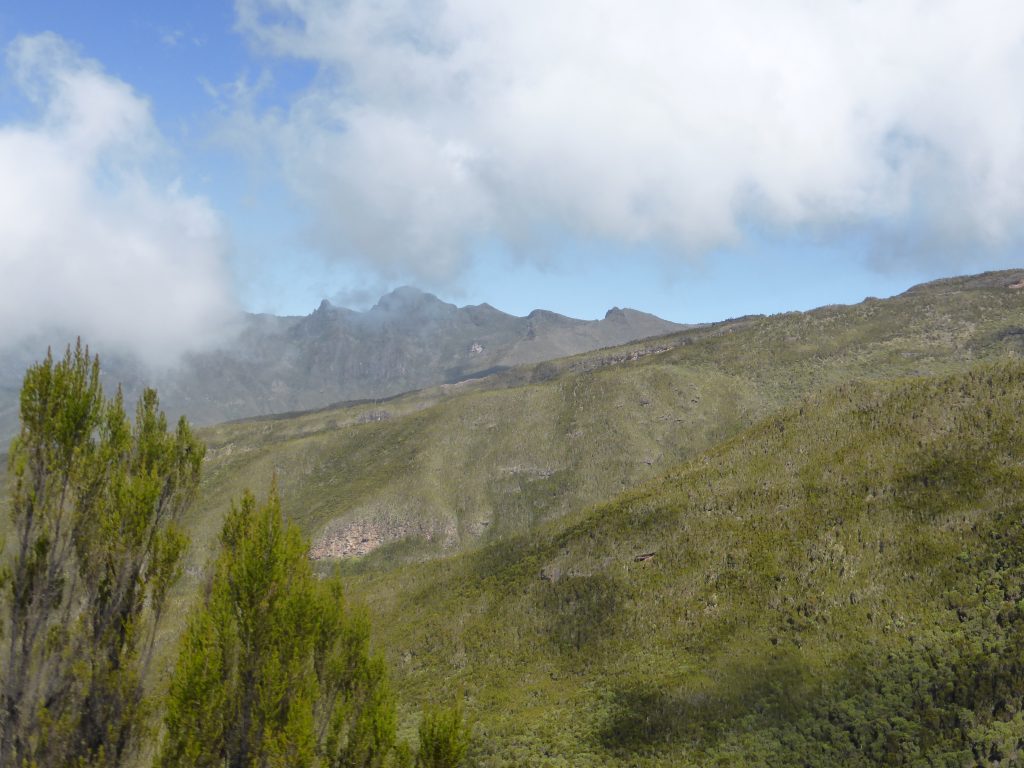
Here it is quite a procession with little chance to pass unless someone stops. The porters are always keen to get ahead – they want to have the camp ready for our arrival.

This cold shower wasn’t quite tempting

We’re out of the rain forest now, with weird vegetation and evidence of how damp it generally is up here.
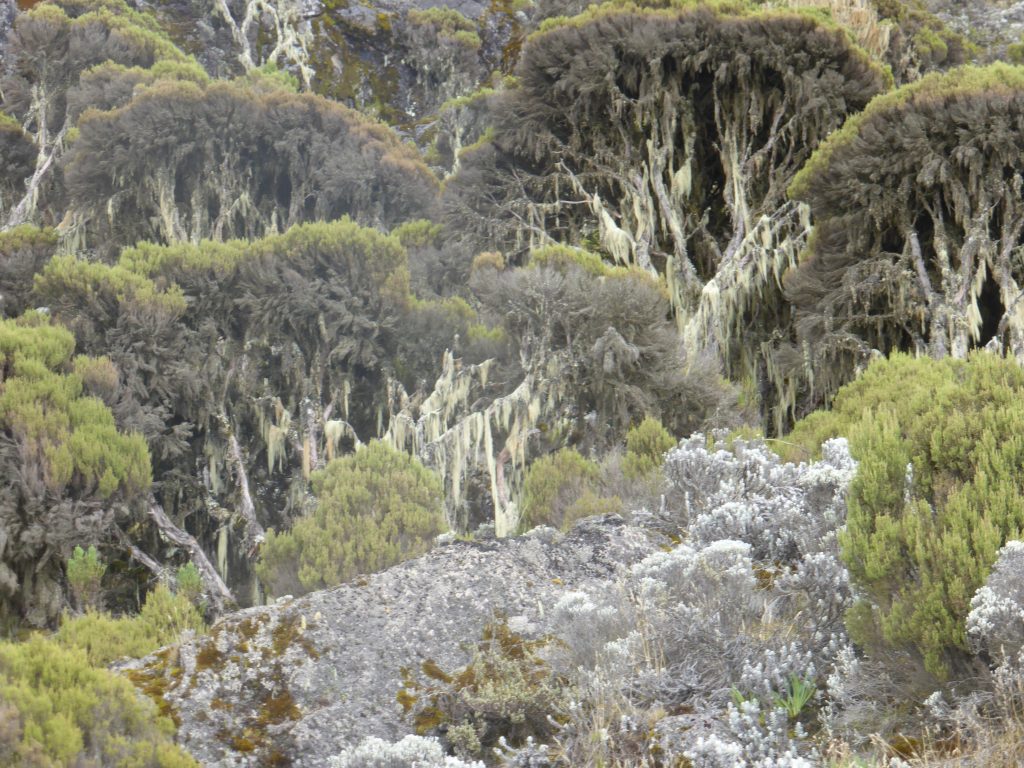
As we turned across the face of the mountain it was less steep but tricky underfoot.
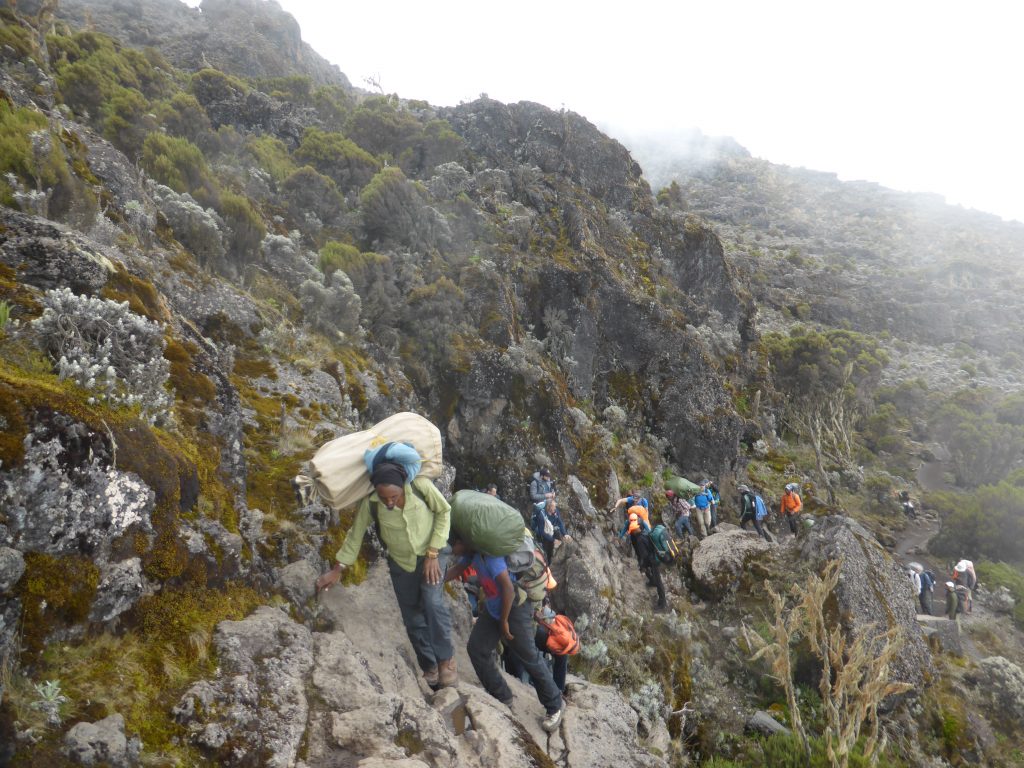
Some splendid mountain thistles
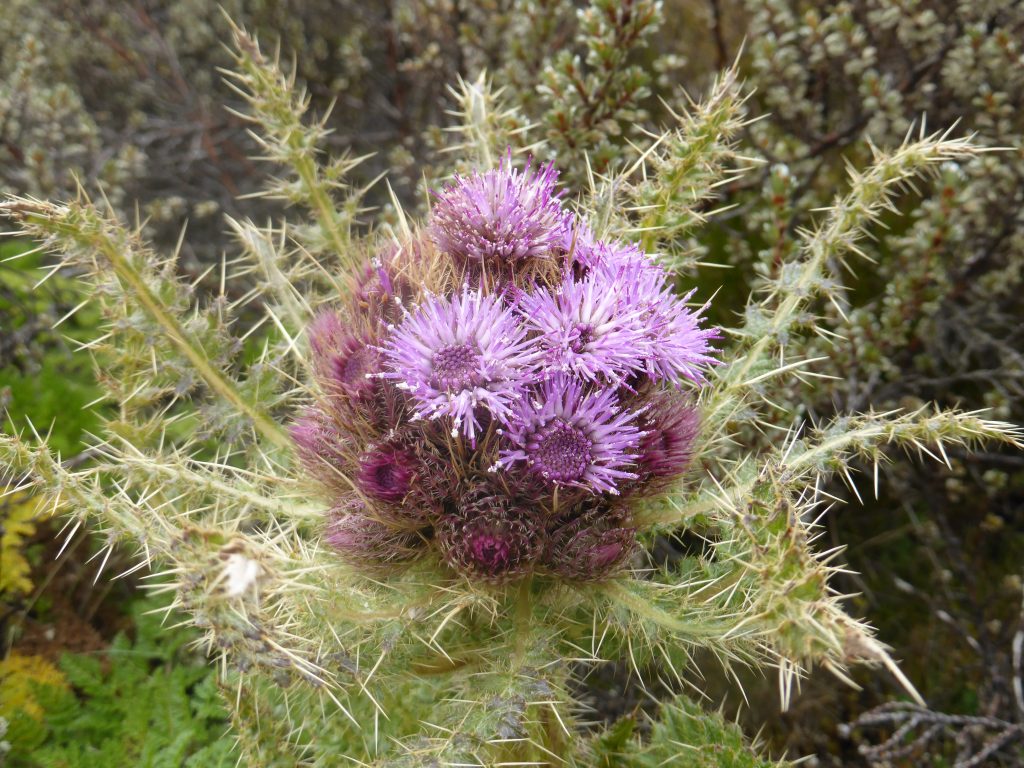
We reached Shira Camp in time for lunch – and in time for the cloud to settle on us.
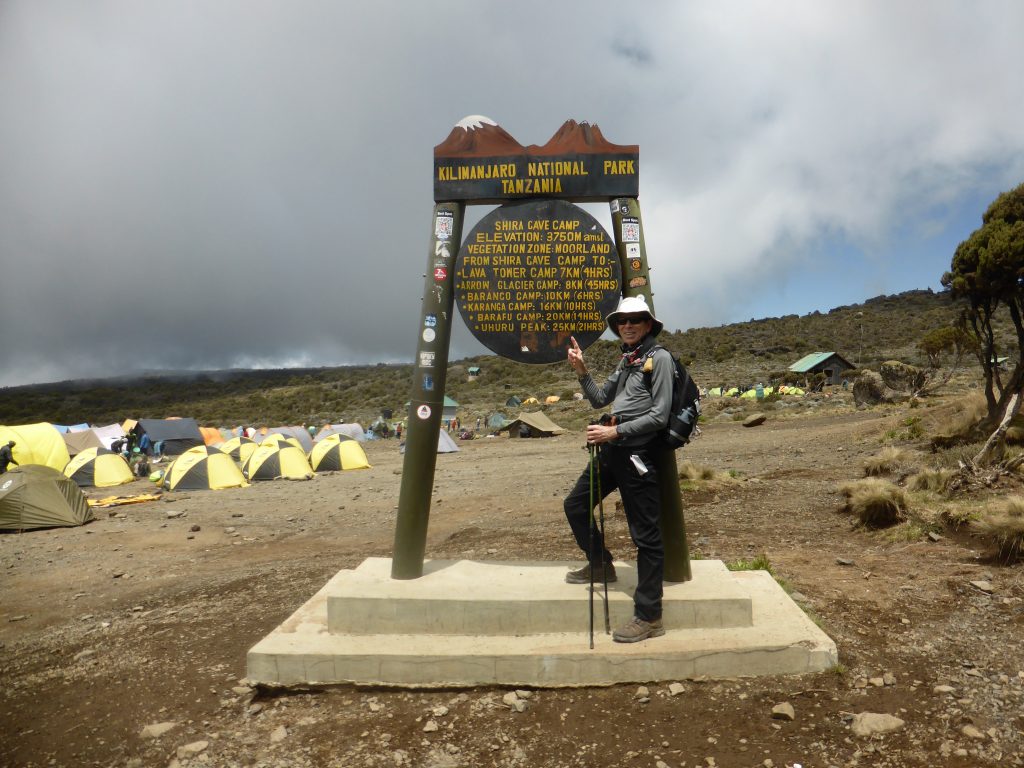
Washing up after lunch
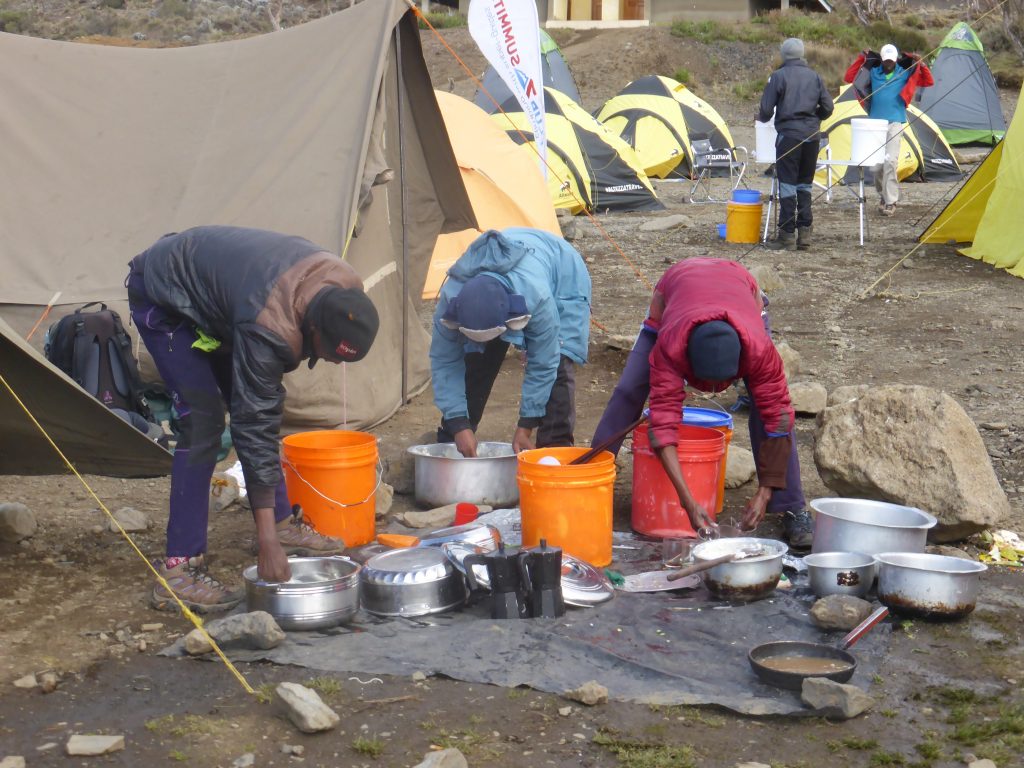
The Shira Cave
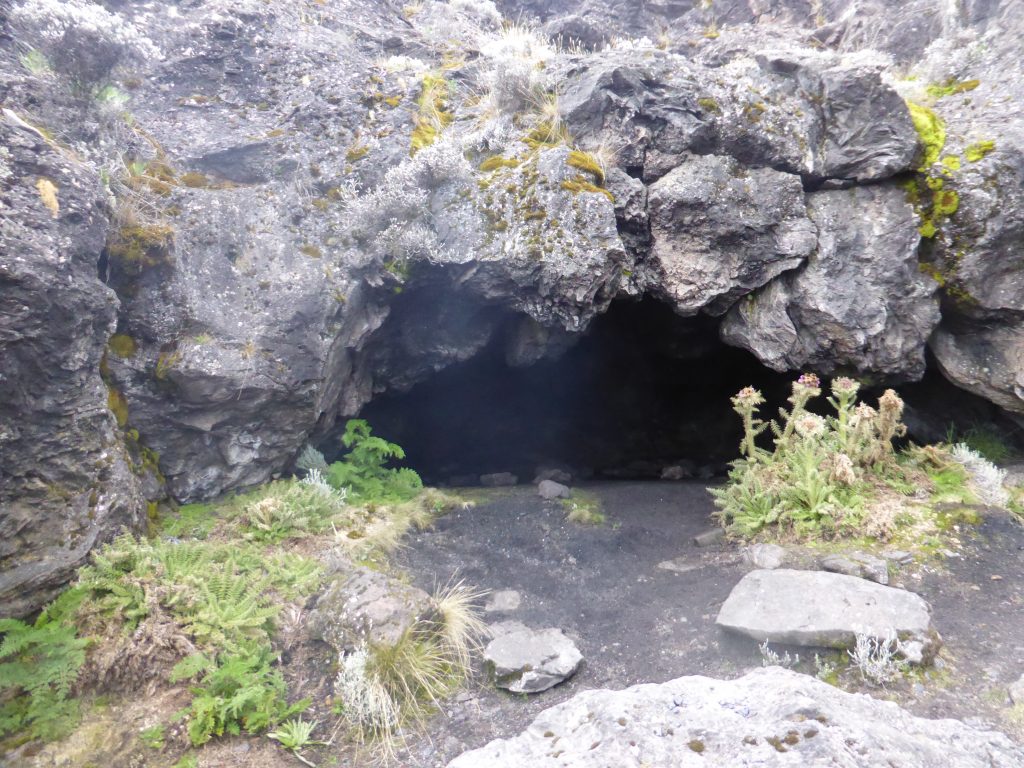
Nashon and I took a further excursion to a small hill which should have a view….
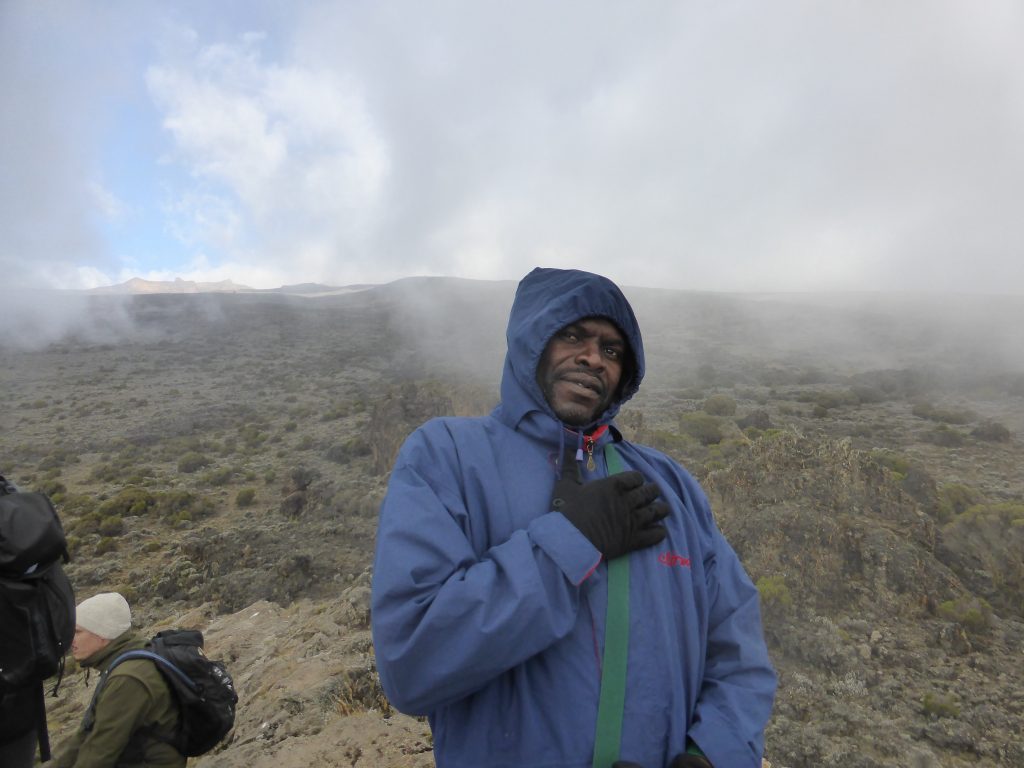
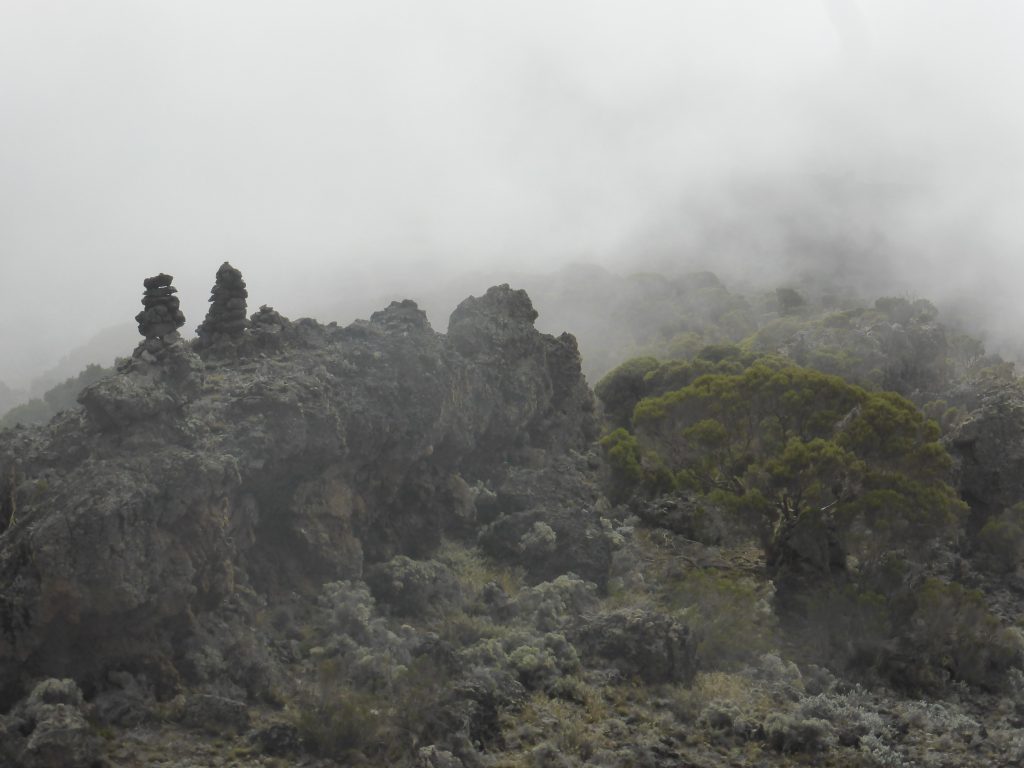
Our tents

Preparing supper
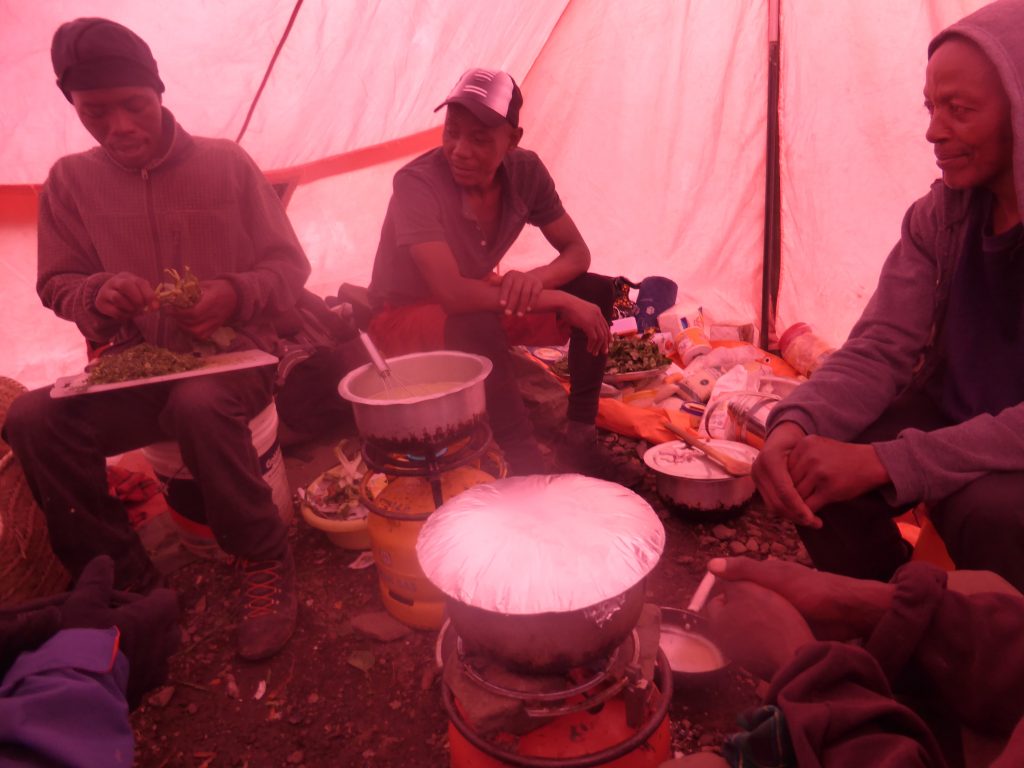
As darkness fell the clouds cleared – what a sight.
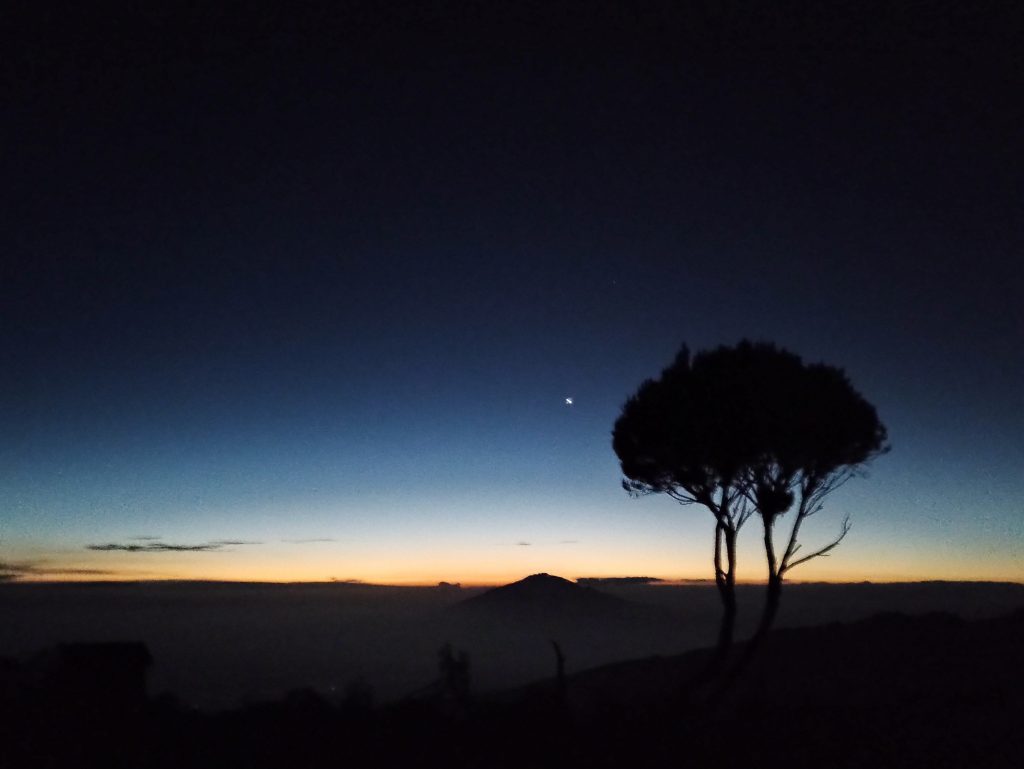
Hike: Machame Gate to Machame Hut • Hiking Route » outdooractive.com
Our first day started early but with lots of hanging around at the Zebra Hotel in Moshi.
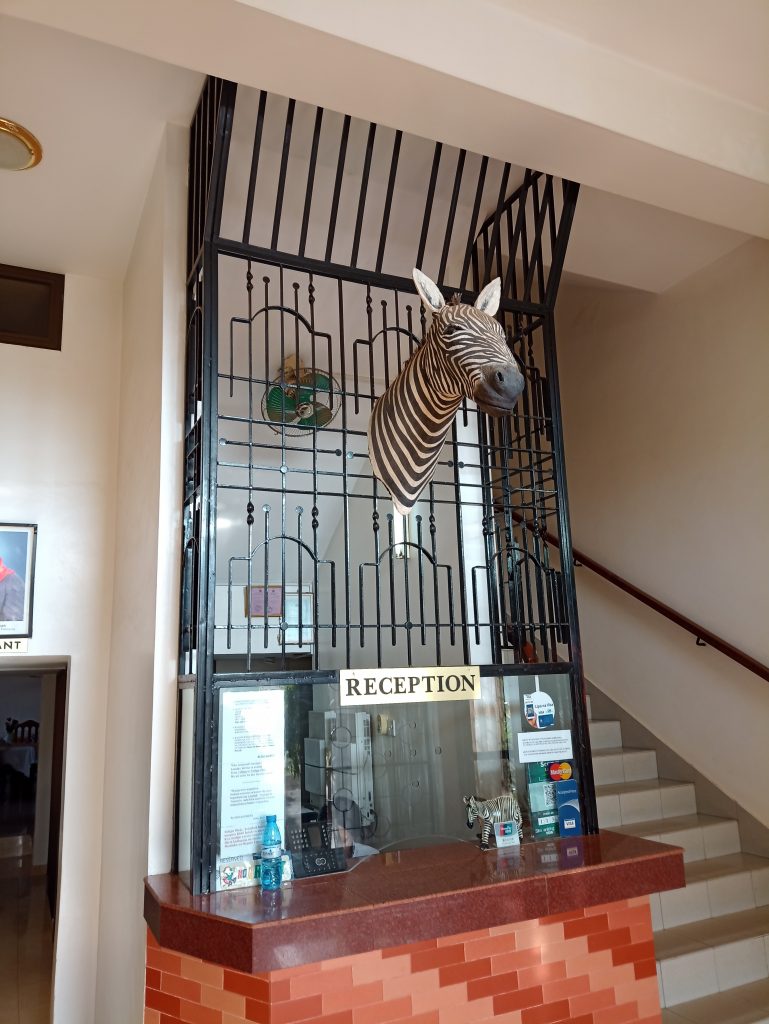
For those prepared to climb 6 storeys to the roof, Kilimanjaro was just visible.
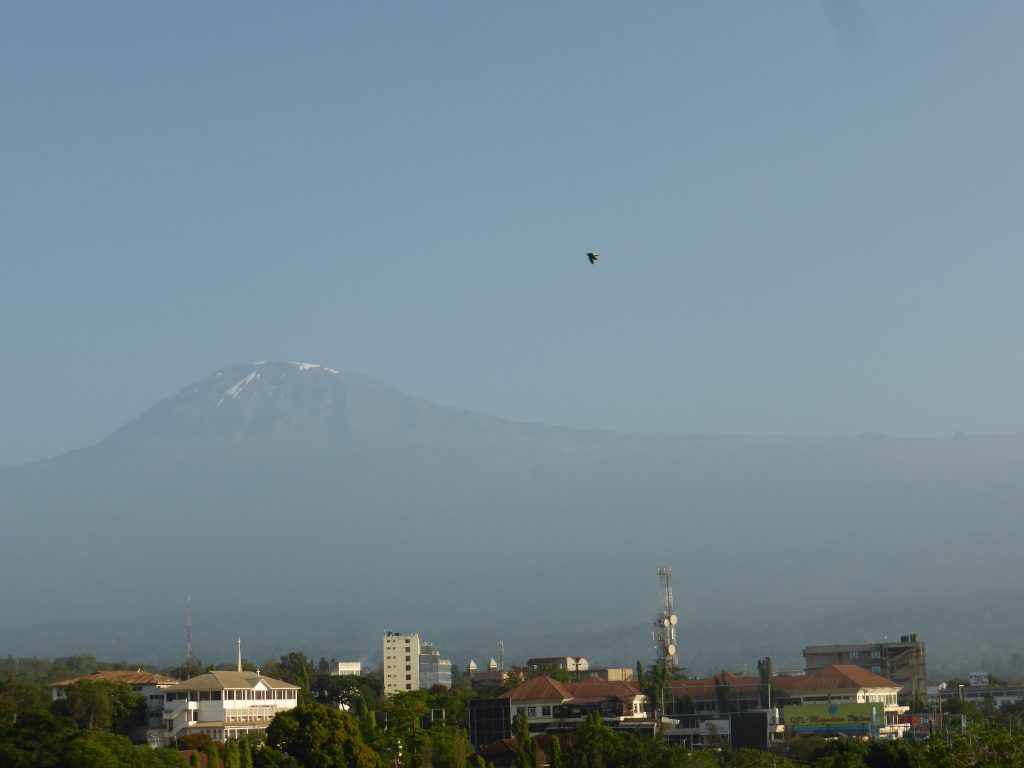
Meanwhile, Wolfgang (manager of the guiding company) checked our equipment.
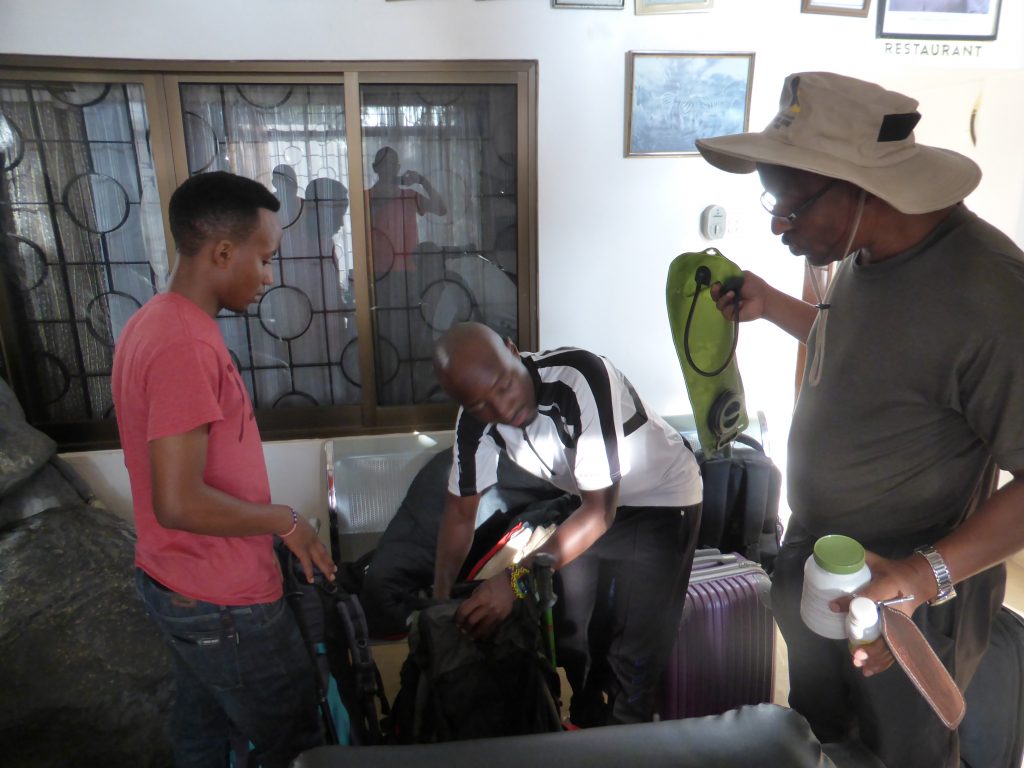
The luggage (max 15kg per person) was loaded onto the roof of the bus. Then the people were loaded and we drove to the equipment hire place where some hired missing kit, some bought extra items, and we picked up our support team and all the equipment to sustain us for a week on the mountain.
A drive of about an hour the Machame Gate followed. There the porters unloaded all the equipment again, ready to carry it to our first night’s camp.
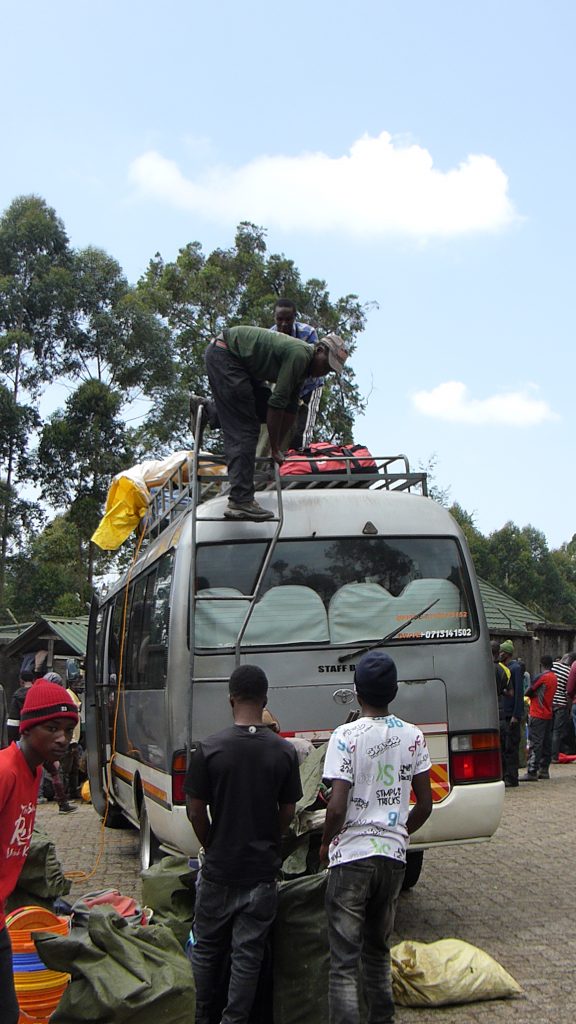
Everyone wanted their photo taken by the sign at the start of the route, but eventually we got it to ourselves.

We were served lunch then, later than I’d expected (about 13:40), we were off on the trail.
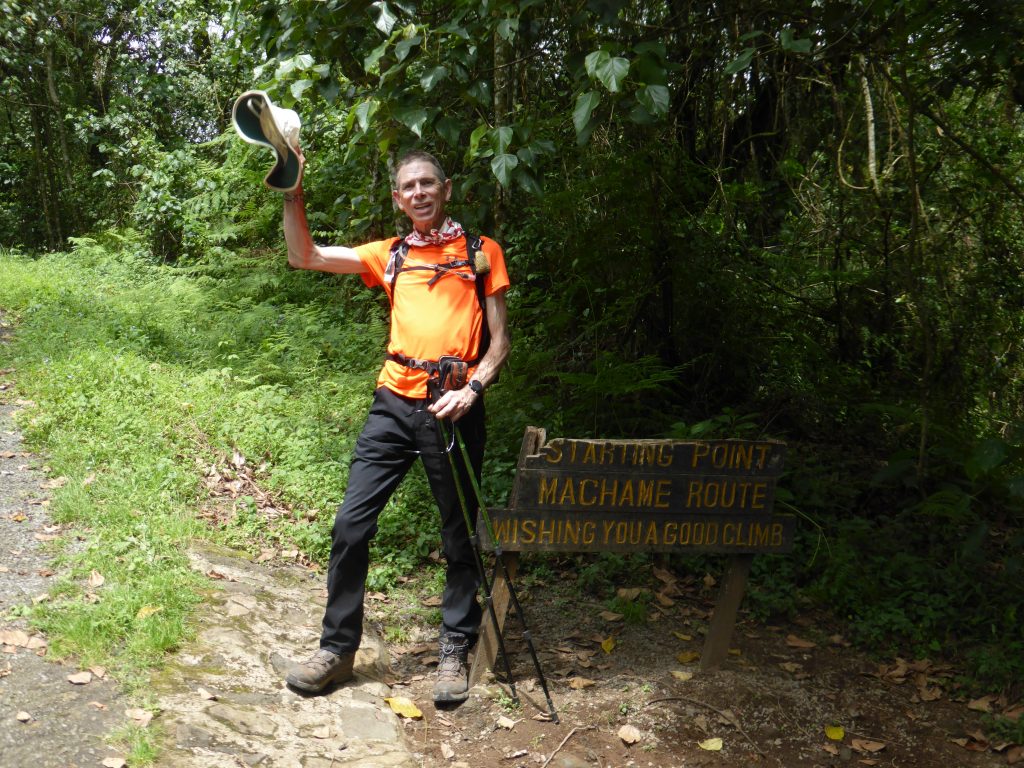
Today’s hike is a steady ascent of 1,200m (from 1,800m to 3,000m) over 10.8km all on a good trail through the rainforest.
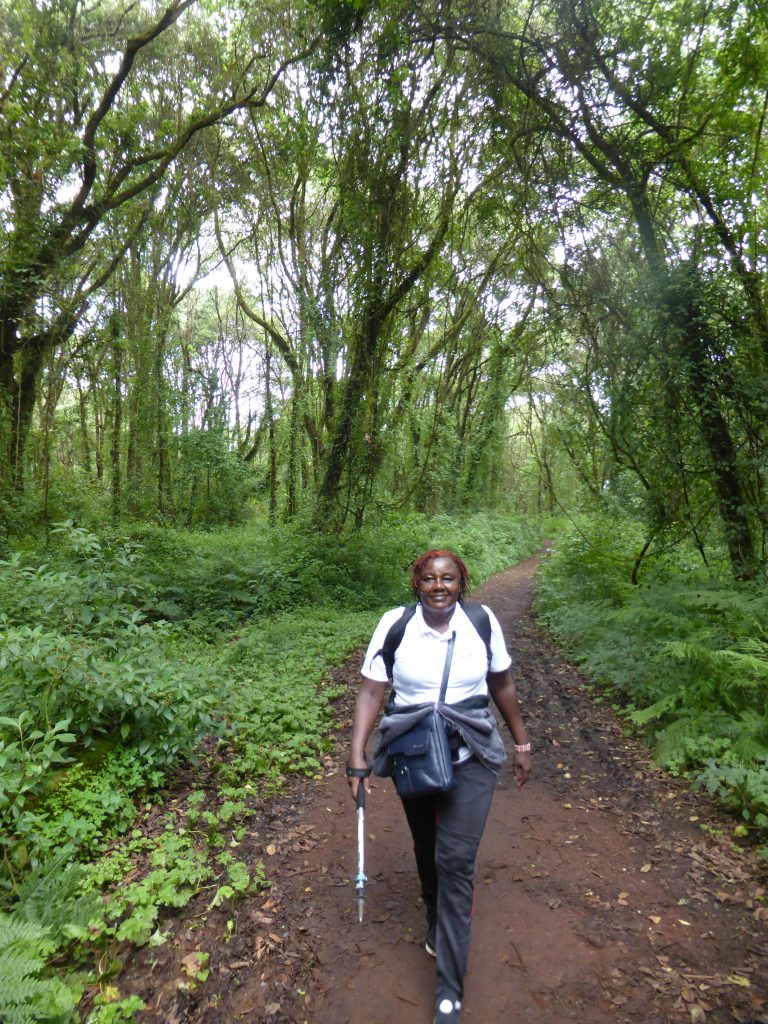
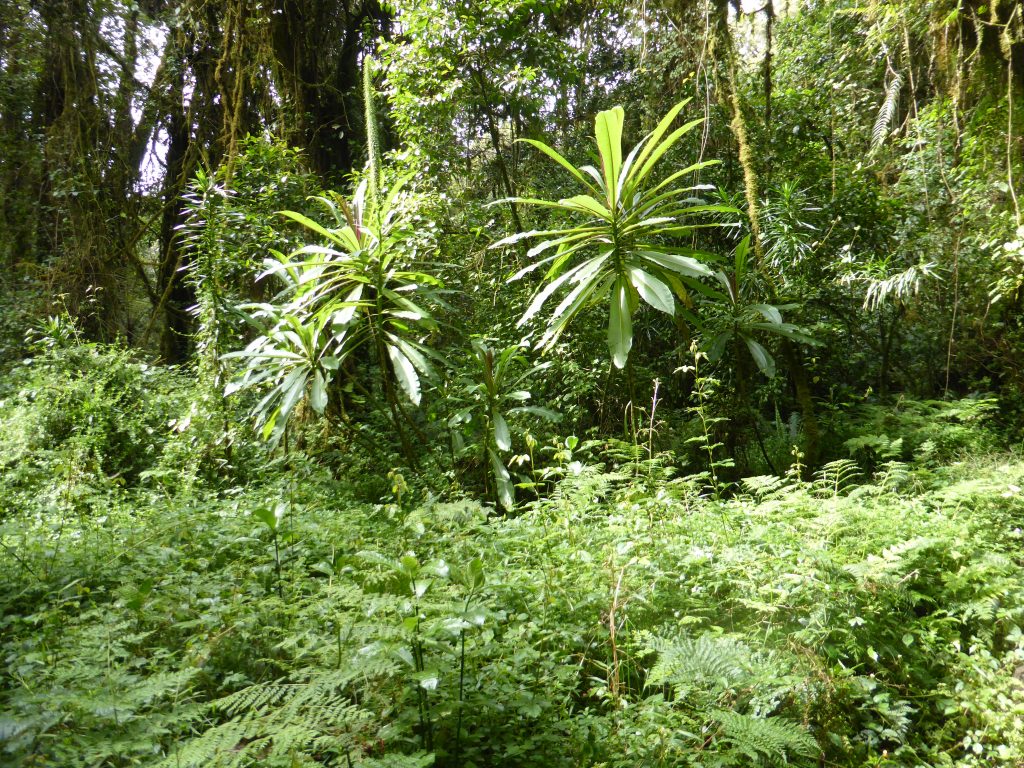
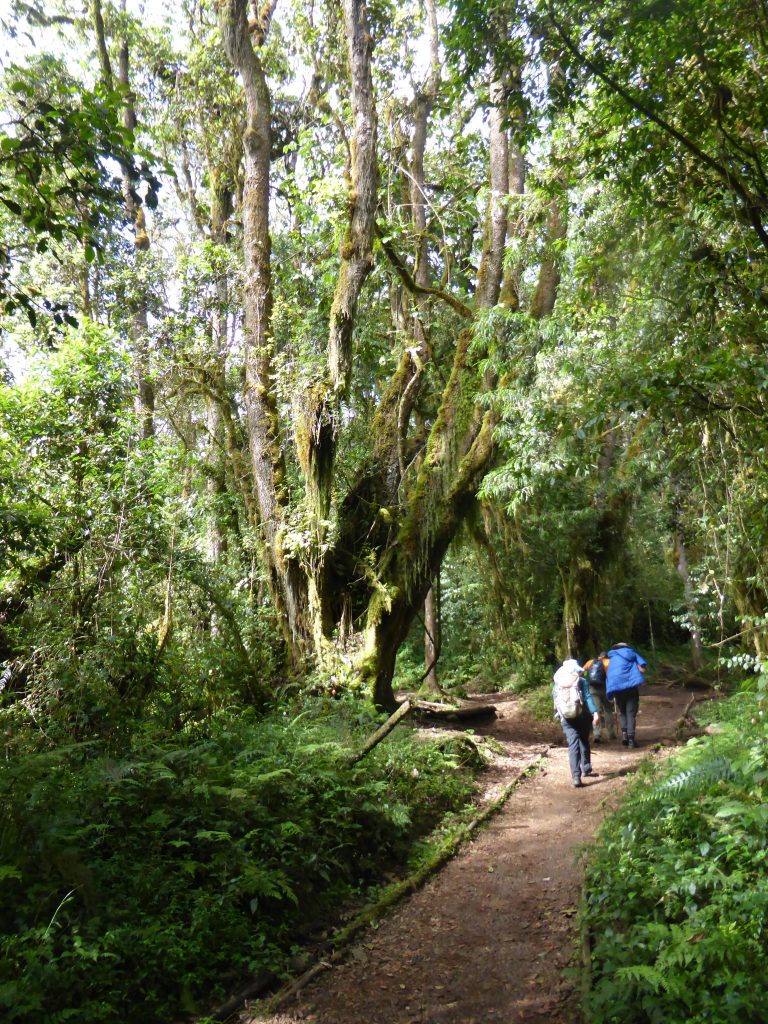
It can be a procession at times, with hikers and porters all using the same trail.
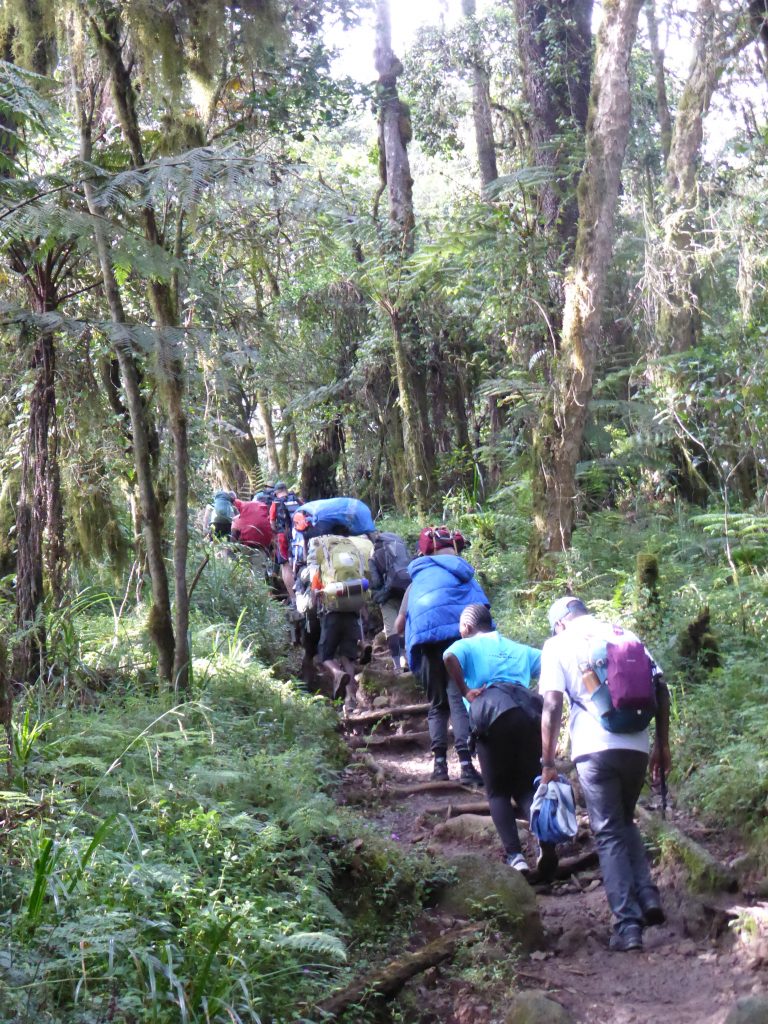
Some 3h40 after setting out we reached Machame Camp.

Here our tents were being erected and we were fed and watered before retiring to our tents for the first night under canvas.
Morning Hike – Ngong Hills end to end and back • Hiking Route » outdooractive.com
In Nairobi ahead of my Kilimanjaro climb, Dr Faith and her brother Steve took me to Ngong Hills for a training hike – more altitude than I’ve found in Hampshire (with a minimum elevation above 2,000m it’s higher than anywhere in UK)!
We met at 5am then an hour’s drive from Syokimau to Ngong in time to see the sun rising.

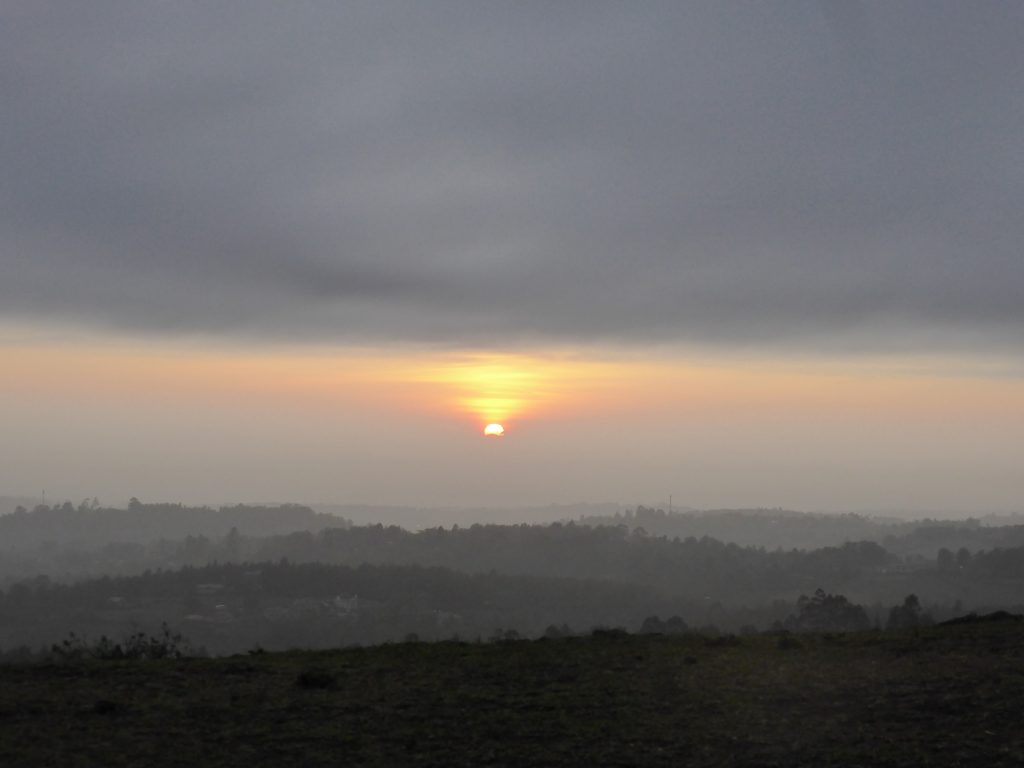
Well, just about see the sun rising as we were up in the clouds. As we started the hike (it was chilly) we could hear rather than see the wind turbines around us, and views were pretty limited.
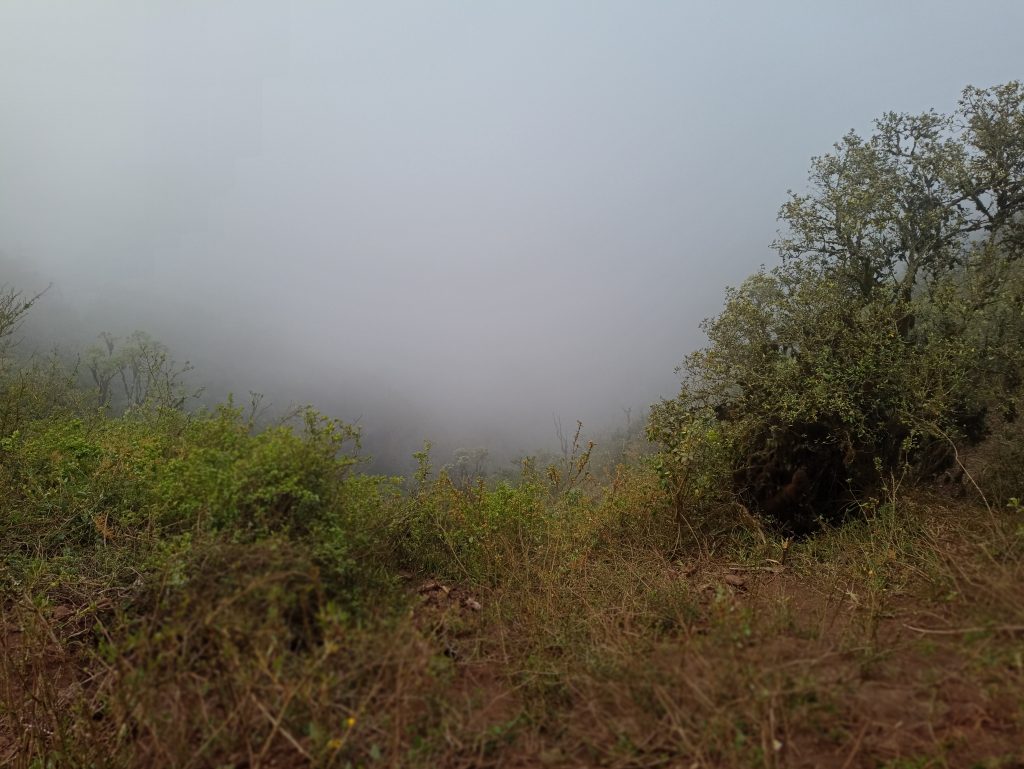
The hike starts with a steady climb (250m in 3km)
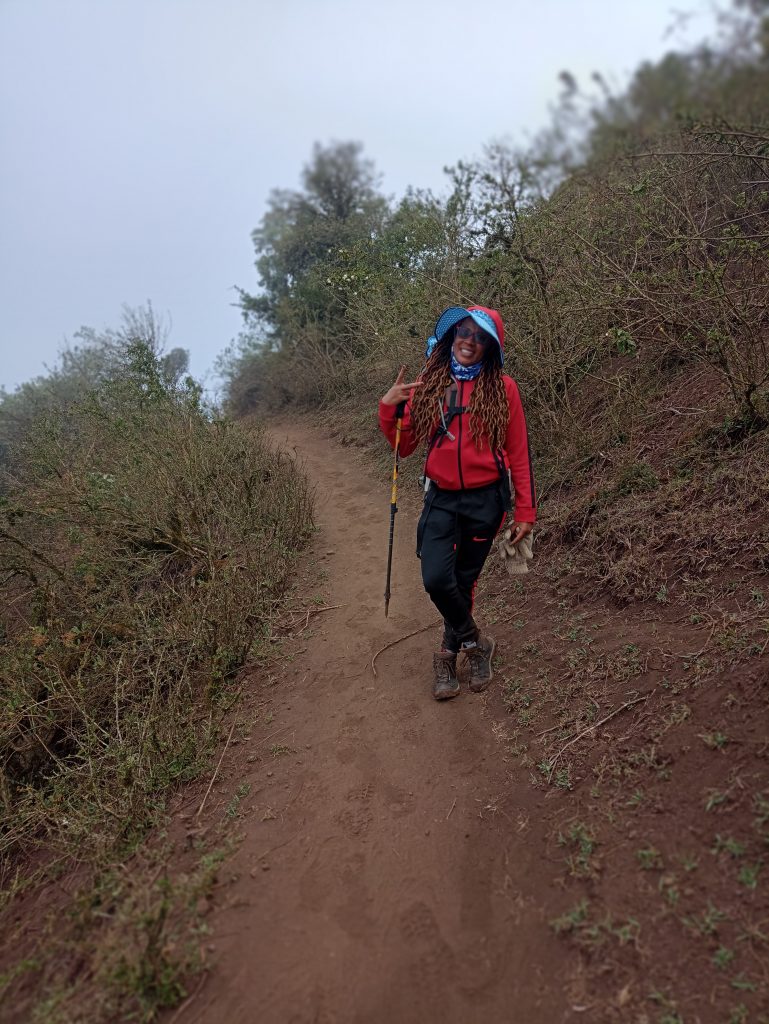
This is followed by a series of mini-summits and improving views.
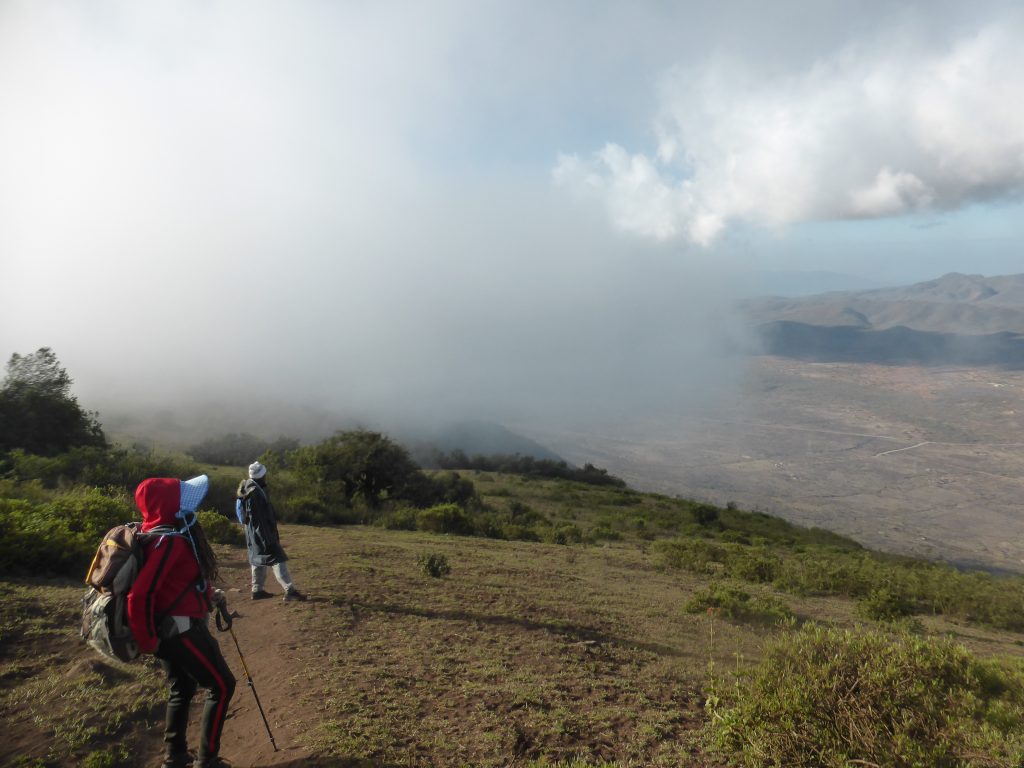
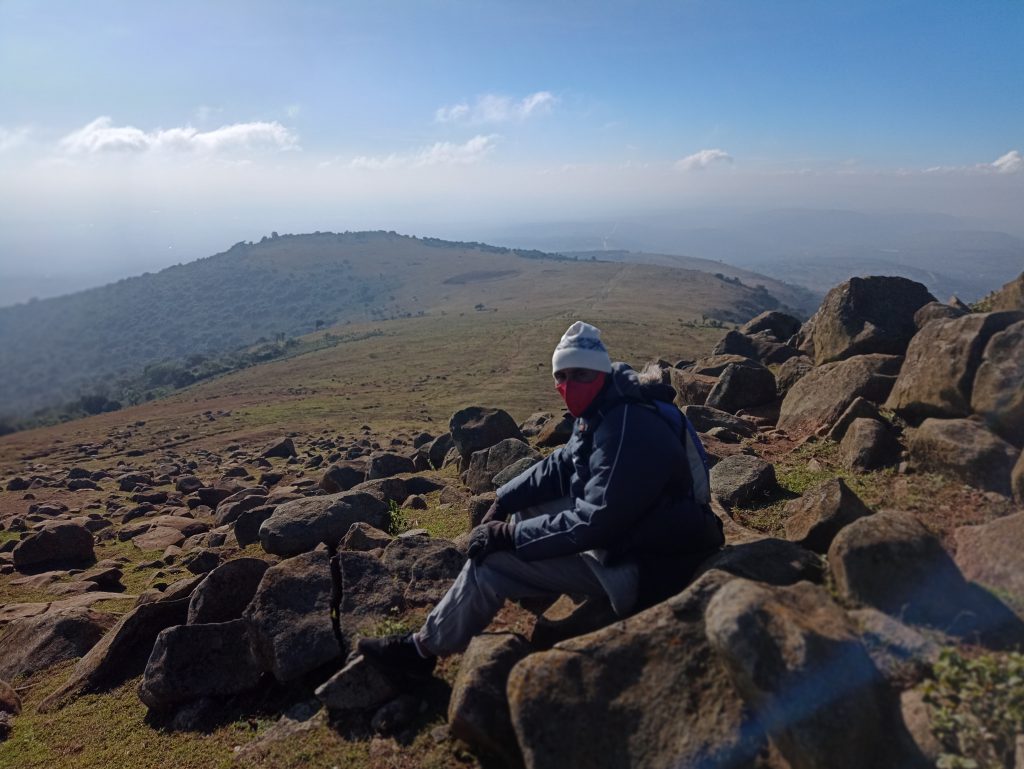

Then a long descent to the southern gate (100m lower than the northern gate) where we had to pay our entrance fees.

Then reverse the route back to the start, with increasing temperature and sun.
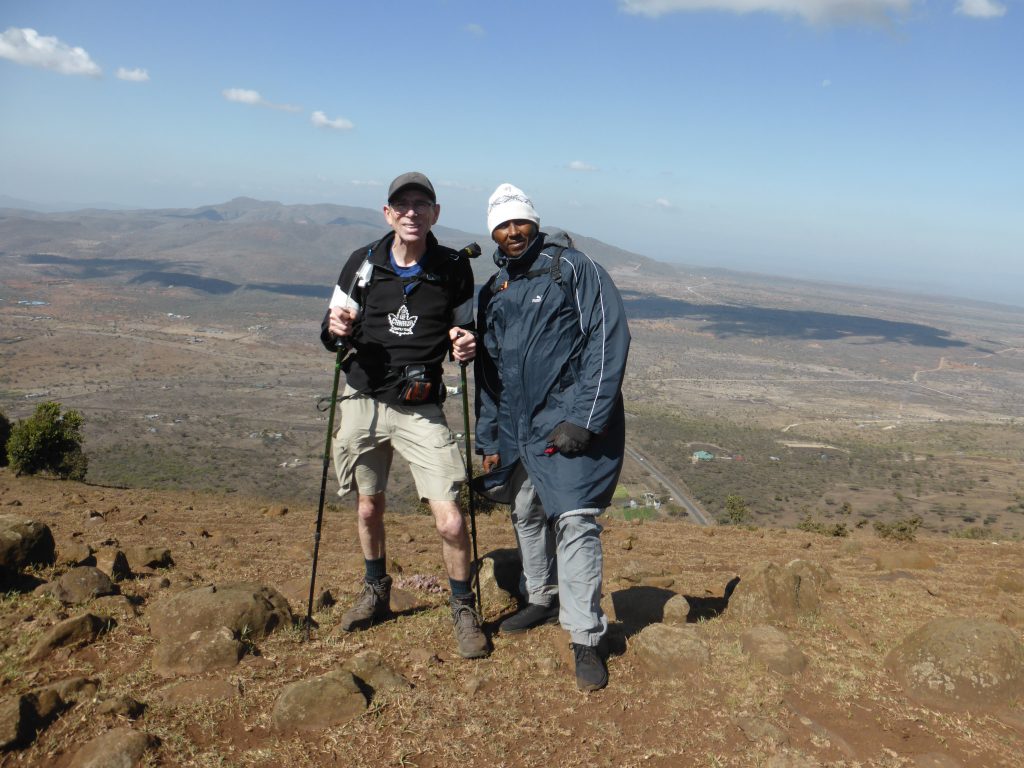

This group were singing and playing hymns that could be heard far our over the hills, an inspiration as you slogged up towards them.
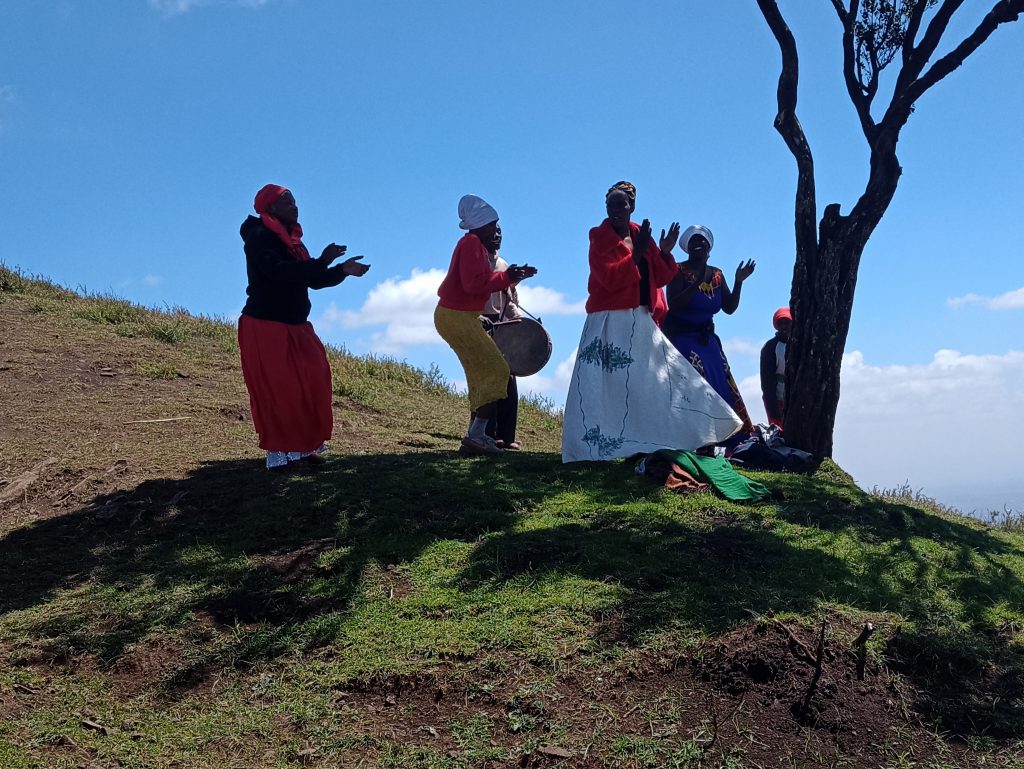
We made it – the two daktaris!
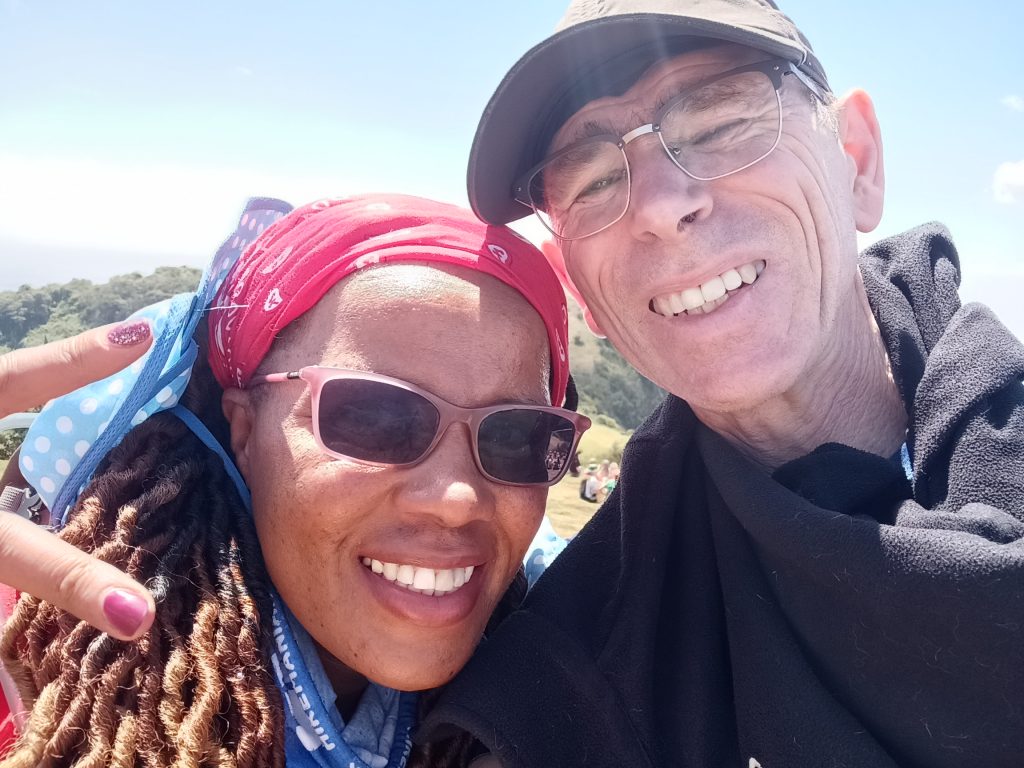
Back near the start, cattle and goats were grazing in the sunshine.

My new boots, bought the day before I left and only worn on the flight out, now looked well and truly used!
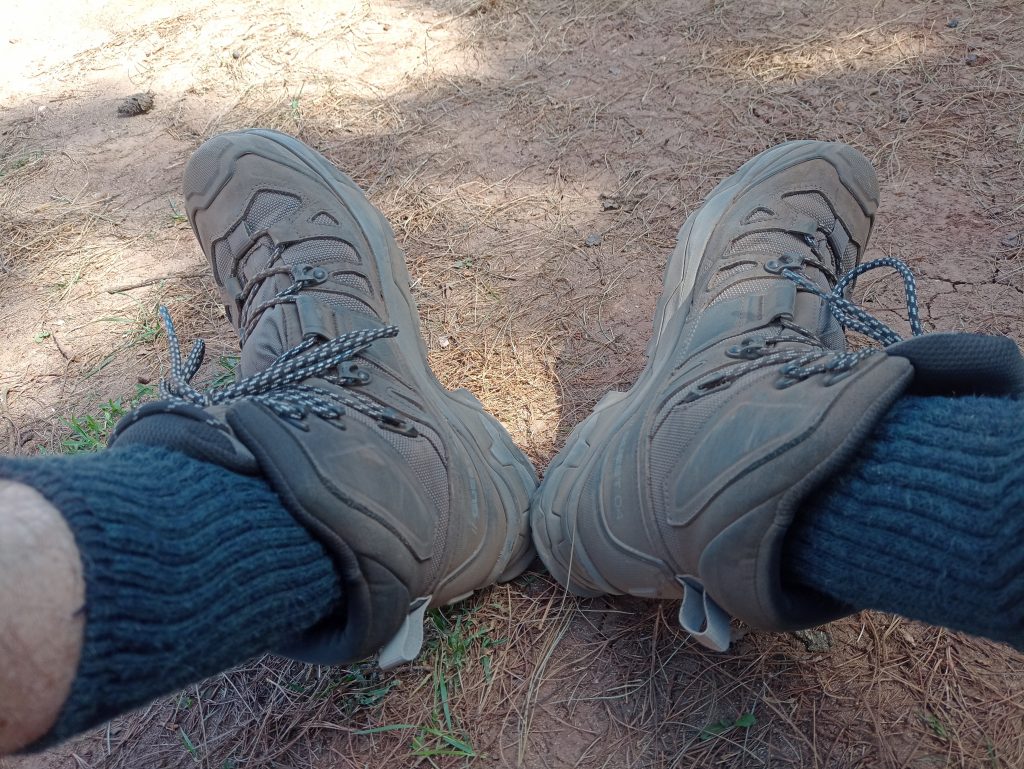
My final couple of days were quietly preparing to travel and sorting out the truck. Friday started with a dawn run along the length of Bamburi beach (foolishly in bare feet)
Truck tyre sorted, some final shopping down, I returned to Majaoni and took a walk by the creek.
On the way back I saw these kids enjoying their sloping tree.
Saturday morning – a visit to say goodbye to Beatrice and family (Ben is home from hospital)
Lydia, Francisca and Martin
One for granny!
And then Jacob drove me to the airport and I’m catching up as I wait in Nairobi for the midnight flight to Amsterdam. 2 weeks has passed very quickly, and I’ll miss all my Kenyan friends. Tutaonana tena marafiki.